D Link IR868LA1 Wireless AC1750 Dual Band Gigabit Cloud Router USB 3.0 User Manual Part 1
D Link Corporation Wireless AC1750 Dual Band Gigabit Cloud Router USB 3.0 Part 1
D Link >
Contents
- 1. User Manual Part 1
- 2. User Manual Part 2
User Manual Part 1
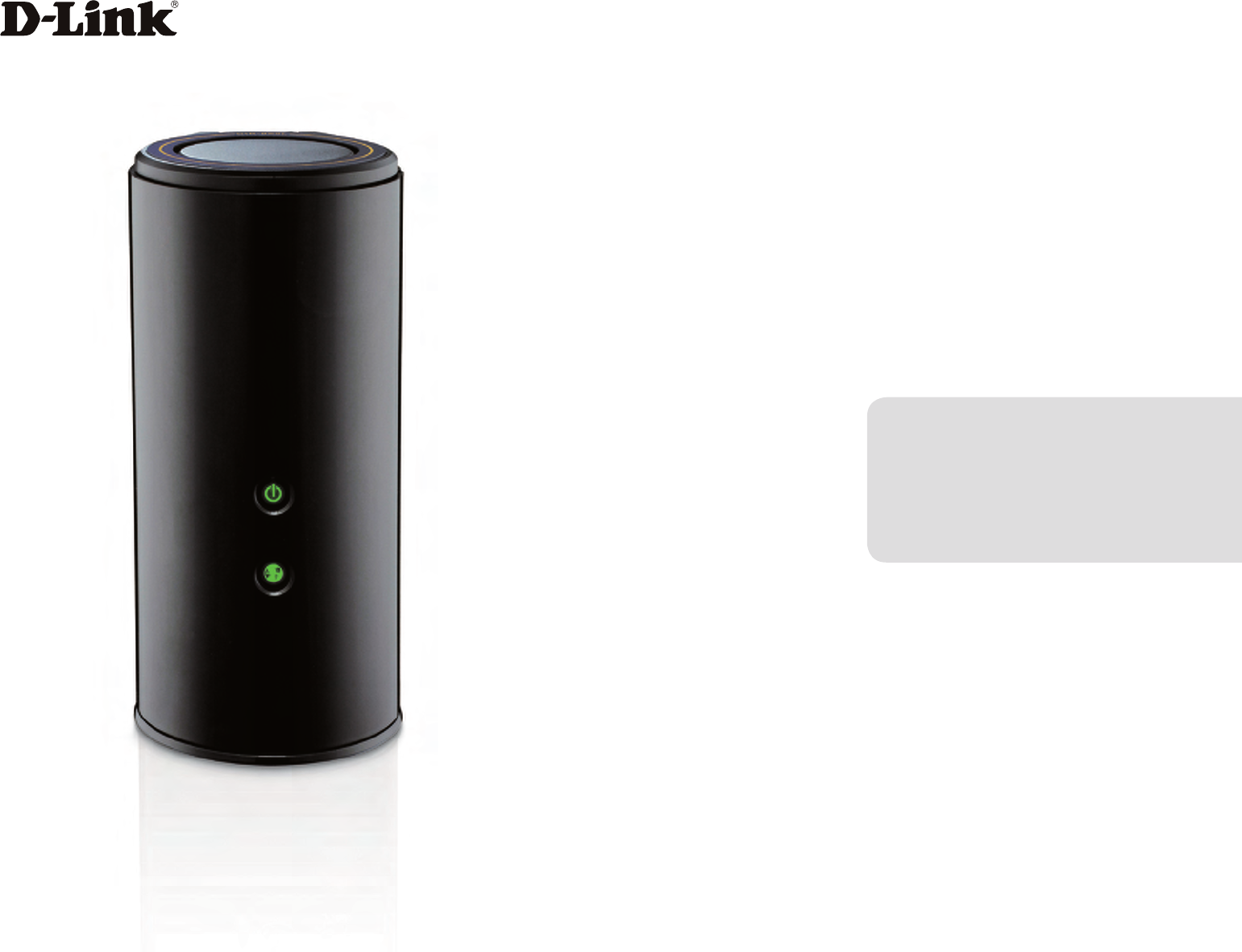
Version 1.0 | 01/16/2013
User Manual
DIR-868L
Wireless AC1750 Dual-Band Gigabit
Cloud Router USB 3.0

iD-Link DIR-868L User Manual
D-Link reserves the right to revise this publication and to make changes in the content hereof without obligation to notify any
person or organization of such revisions or changes.
Manual Revisions
Trademarks
D-Link and the D-Link logo are trademarks or registered trademarks of D-Link Corporation or its subsidiaries in the United
States or other countries. All other company or product names mentioned herein are trademarks or registered trademarks of
their respective companies.
Copyright © 2013 by D-Link Corporation.
All rights reserved. This publication may not be reproduced, in whole or in part, without prior expressed written permission
from D-Link Corporation.
Revision Date Description
1.0 January 16, 2013 • Initial release
Preface

iiD-Link DIR-868L User Manual
Table of Contents
Preface ................................................................................. i
Manual Revisions ........................................................................... i
Trademarks ...................................................................................... i
Product Overview .............................................................. 1
Package Contents ......................................................................... 1
System Requirements ................................................................. 2
Introduction ................................................................................... 3
Features ............................................................................................4
Hardware Overview ..................................................................... 5
Connections ...........................................................................5
LEDs ........................................................................................... 6
Installation ......................................................................... 7
Before you Begin ........................................................................... 7
Wireless Installation Considerations ...................................... 8
Manual Setup .................................................................................9
Conguration ...................................................................11
D-Link Quick Setup Wizard .....................................................12
QRS Mobile App (iOS, Android) .............................................19
SharePort Mobile App (iOS, Android) .................................20
Web-based Conguration Utility ..........................................24
Internet Connection Setup .............................................25
Static IP ..............................................................................26
Dynamic IP (DHCP) ........................................................27
PPPoE (Username/Password) ....................................28
PPTP ....................................................................................30
L2TP ....................................................................................31
DS-Lite ...............................................................................33
Wireless Settings .................................................................34
Wireless Connection Setup Wizard..........................35
Wireless Security Setup Wizard .................................38
Add Wireless Device with WPS Wizard ...................40
Manual Wireless Settings .................................................42
802.11 b/g/n (2.4GHz) ..................................................42
802.11ac draft (5GHz) ...................................................43
Network Settings ................................................................44
Router Settings ...............................................................45
DHCP Server Settings ...................................................46
DHCP Reservation .........................................................47
Storage ...................................................................................48
Media Server.........................................................................49
IPv6 ..........................................................................................50
IPv6 Internet Connection Setup Wizard ................51
Manual IPv6 Local Connectivity Setup ..................56
IPv6 Manual Setup.........................................................57
mydlink Settings .................................................................68
Advanced ......................................................................................69
Virtual Server ........................................................................69
Port Forwarding ..................................................................70
Application Rules ................................................................71
QoS Engine............................................................................72
Network Filters .....................................................................74
Access Control .....................................................................75
Table of Contents

iiiD-Link DIR-868L User Manual
Table of Contents
Website Filters ......................................................................78
Inbound Filter ......................................................................79
Firewall Settings ..................................................................80
Routing ...................................................................................82
Advanced Wireless .............................................................83
Wi-Fi Protected Setup .......................................................84
Advanced Network ............................................................86
Guest Zone ............................................................................87
IPv6 Firewall ..........................................................................88
IPv6 Routing .........................................................................89
Tools ................................................................................................90
Admin .....................................................................................90
Time .........................................................................................91
SysLog .....................................................................................92
Email Settings ......................................................................93
System ....................................................................................94
Firmware ................................................................................95
Firmware Upgrade .........................................................95
Language Pack ................................................................95
Dynamic DNS .......................................................................96
System Check .......................................................................97
Schedules ..............................................................................98
Status ..............................................................................................99
Device Info ............................................................................99
Logs ...................................................................................... 100
Statistics .............................................................................. 101
Internet Sessions .............................................................. 102
Routing ................................................................................ 103
Wireless ............................................................................... 104
IPv6 ....................................................................................... 105
IPv6 Routing ...................................................................... 106
Support ....................................................................................... 107
Connect a Wireless Client to your Router ....................108
WPS Button ................................................................................ 108
Windows® 7 ................................................................................ 109
WPA/WPA2 ......................................................................... 109
WPS ....................................................................................... 112
Windows Vista® ......................................................................... 116
WPA/WPA2 ......................................................................... 117
WPS/WCN 2.0 .................................................................... 119
Windows® XP ............................................................................. 120
WPA/WPA2 ......................................................................... 121
Troubleshooting ............................................................123
Wireless Basics ...............................................................127
What is Wireless? ...................................................................... 128
Tips ................................................................................................ 130
Wireless Modes ......................................................................... 131
Networking Basics .........................................................132
Check your IP address ............................................................ 132
Statically Assign an IP address ............................................ 133
Wireless Security ......................................................... 134
What is WPA? ................................................................ 134
Technical Specications ................................................135

1D-Link DIR-868L User Manual
Section 1 - Product Overview
Product Overview
Package Contents
Note: Using a power supply with a dierent voltage rating than the one included with the DIR-868L will cause damage and void the warranty
for this product.
If any of the above items are missing, please contact your reseller.
DIR-868L Wireless AC1750 Dual-Band Gigabit Cloud Router USB 3.0
Ethernet Cable
Power Adapter
Wi-Fi Conguration Note
Wi-Fi Conguration Note

2D-Link DIR-868L User Manual
Section 1 - Product Overview
Network Requirements • An Ethernet-based Cable or DSL modem
• 802.11ac (draft), n, g, b, or a wireless or Ethernet port
Web-based Conguration
Utility Requirements
Computer with the following:
• Windows®, Macintosh, or Linux-based operating system
• An installed Ethernet adapter
Browser Requirements:
• Internet Explorer 7 or higher
• Firefox 3.5 or higher
• Safari 4 or higher
• Chrome 8 or higher
Windows® Users: Make sure you have the latest version of Java
installed. Visit www.java.com to download the latest version.
mydlink Requirements
• iPhone/iPad/iPod Touch (iOS 3.0 or higher)
• Android device (1.6 or higher)
• Computer with the following browser requirements:
• Internet Explorer 7 or higher
• Firefox 3 or higher
• Safari 5 or higher
• Chrome 5 or higher
iPhone, iPad, and iPod touch are registered trademarks of Apple Inc. Android is a trademark of Google, Inc.
System Requirements

3D-Link DIR-868L User Manual
Section 1 - Product Overview
Introduction
The D-Link Wireless AC1750 Dual-Band Gigabit Cloud Router USB 3.0 (DIR-868L) comes equipped with four Gigabit ports to
provide speeds up to 10x faster than standard 10/100 ports. It also uses 802.11ac (draft) technology with multiple intelligent
antennas to maximize the speed and range of your wireless signal to signicantly outperform 802.11n devices. With the addition
of Intelligent Quality of Service (QoS), data streams are separated which helps organize and prioritize your network trac so
your video streaming, gaming, and VoIP calls run smoother over both your wired and wireless network.
The DIR-868L supports a host of cloud features inclouding QRS Mobile which allows you to setup and congure the router
using a mobile app. You can set up your router right from your sofa, no PC required.
The Wireless AC1750 Dual-Band Gigabit Cloud Router USB 3.0 is also mydlink-enabled, which gives you access to your home
network no matter where you go. Now you can monitor and manage your home network right from your laptop, iPhone®, iPad®,
or Android™ device. mydlink-enabled routers can be congured to send an email to keep you informed anywhere, anytime
when new devices are connecting to your network or unwanted access is detected. Monitor in real-time websites that are
being visited with recent browser history displayed on the mydlink™ Lite app – which is great for parents.
SharePort Mobile technology lets you take advantage of the USB 3.0 port found on the back of your DIR-868L. Plug in a USB
storage drive and you can use the SharePort Mobile app for iOS and Android to access les, stream videos, view photos, or
listen to music on your laptop or mobile devices. Plug in a printer and you can use the SharePort Mobile Plus app to share that
printer with all of your devices.
The DIR-868L Wireless AC1750 Dual-Band Gigabit Cloud Router USB 3.0 provides incredible speeds, smart antenna technology,
fast ports, cloud features, and terric security features. It also features an innovative design and easy installation options.

4D-Link DIR-868L User Manual
Section 1 - Product Overview
• Faster Wireless Networking - The DIR-868L can provide up to a full 1750Mbps* wireless connection with
concurrent 801.11ac and 802.11n wireless clients . It also operates on both the 2.4 GHz and 5 GHz bands to
allow separation of trac so users can participate in high-bandwidth activities, such as video streaming, online
gaming, and real-time audio, without aecting low-priority trac like email and web surng.
• Cloud Features - The DIR-868L support the QRS Mobile app to setup the router using a mobile device. It is also
mydlink-enabled so you can remotely access and mange your DIR-868L from a mobile device. SharePort Mobile
can be used to share les, stream videos, view photos, and play music. SharePort Plus lets you share a printer.
• Compatible with 802.11a/b/g/n Devices - The DIR-868L is still fully compatible with the 802.11n, IEEE 802.11g
and 802.11a standards, so it can connect with existing 802.11n, 802.11g, 802.11b, and 802.11a wireless devices.
• Advanced Firewall Features - The Web-based user interface displays a number of advanced network
management features including:
• Content Filtering - Easily applied content ltering based on MAC Address, URL, and/or Domain
Name.
• Filter Scheduling - These lters can be scheduled to be active on certain days or for a duration of
hours or minutes.
• Secure Multiple/Concurrent Sessions - The DIR-868L can pass through VPN sessions. It supports
multiple and concurrent IPSec and PPTP sessions, so users behind the DIR-868L can securely access
corporate networks.
• User-friendly Setup Wizard - Through its easy-to-use Web-based user interface, the DIR-868L lets you control
what information is accessible to those on the wireless network, whether from the Internet or from your company’s
server. Congure your router to your specic settings within minutes.
* Maximum wireless signal rate derived from IEEE Standard 802.11a, 802.11b, 802.11g, and 802.11n specications. Actual data throughput will vary. Network conditions and
environmental factors, including volume of network trac, building materials and construction, and network overhead, lower actual data throughput rate. Environmental
conditions will adversely aect wireless signal range.
Features
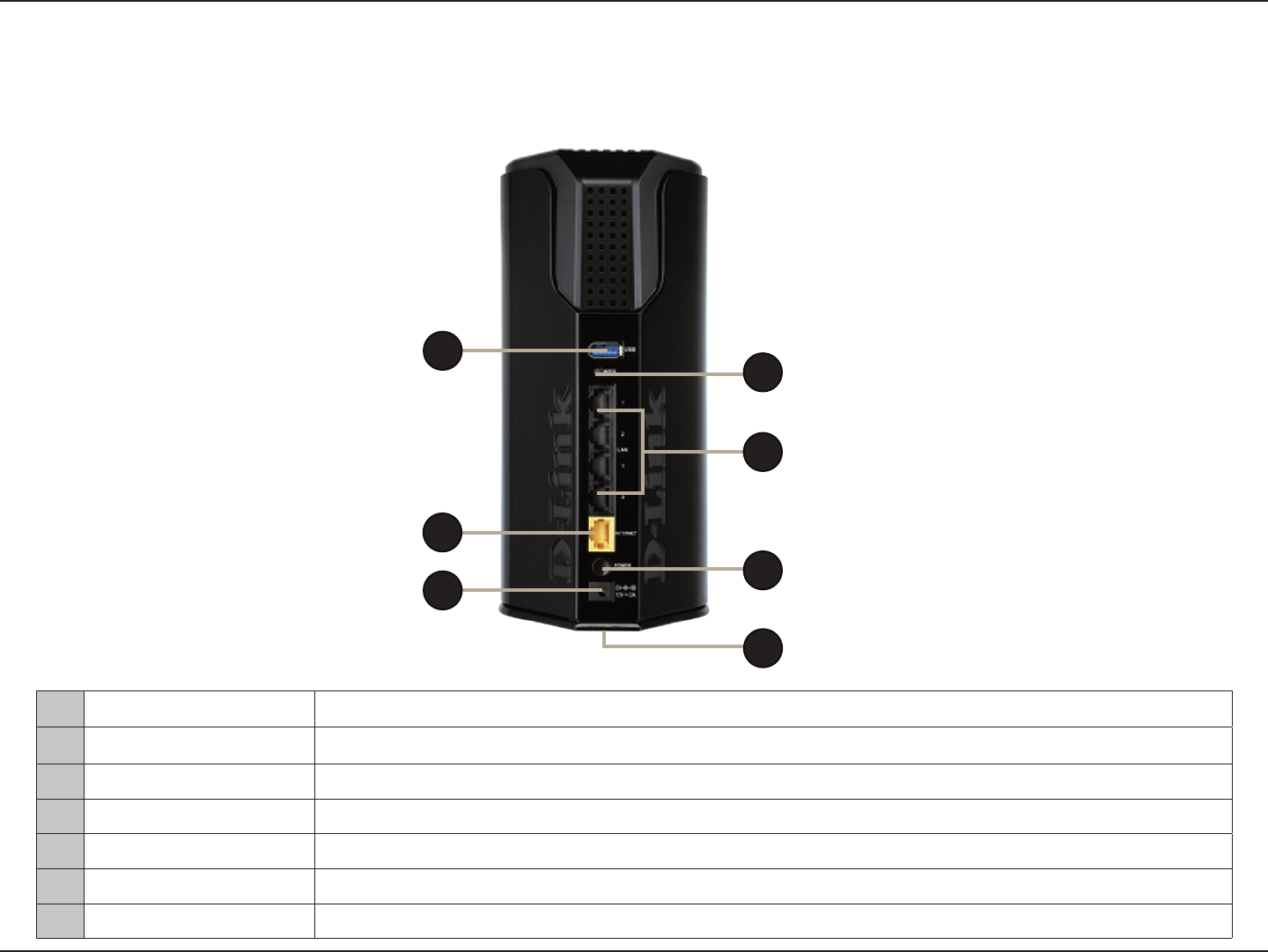
5D-Link DIR-868L User Manual
Section 1 - Product Overview
Hardware Overview
Connections
1USB 3.0 Port Connect a USB ash drive to share content , or connect it to a USB printer to share it on your network.
2WPS Button Press to start the WPS process and automatically create a secure connection to a WPS client.
3Gigabit LAN Ports (1-4) Connect Ethernet devices such as computers, switches, storage (NAS) devices and game consoles.
4Gigabit Internet Port Using an Ethernet cable, connect your broadband modem to this port.
5Power Button Press the power button to power on and o.
6Power Receptor Receptor for the supplied power adapter.
7Reset Button Insert a paperclip in the hole and wait for several seconds to reset the router to default settings.
4
5
6
2
1
3
7
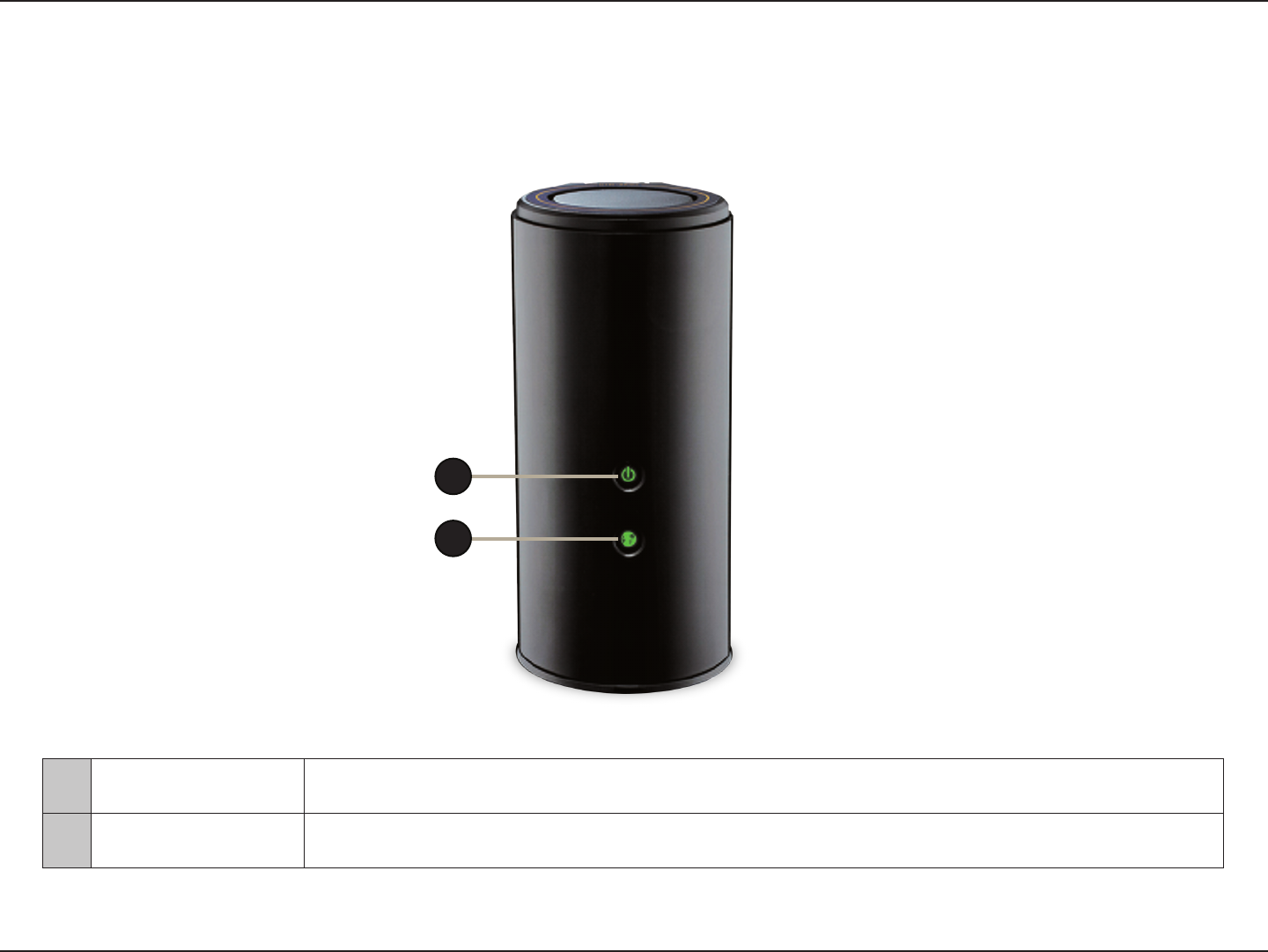
6D-Link DIR-868L User Manual
Section 1 - Product Overview
Hardware Overview
LEDs
1Power LED A solid green light indicates a proper connection to the power supply. The light will blink green during
the WPS process. The light will be a solid orange during boot up.
2Internet LED A solid light indicates connection on the Internet port. If the LED is orange, the connection is good but
the router cannot connect to the Internet.
1
2

7D-Link DIR-868L User Manual
Section 2 - Installation
Before you Begin
Installation
This section will walk you through the installation process. Placement of the router is very important. Do not place the router
in an enclosed area such as a closet, cabinet, or in the attic or garage.
• Please congure the router with the computer that was last connected directly to your modem.
• You can only use the Ethernet port on your modem. If you were using the USB connection before using the router,
then you must turn o your modem, disconnect the USB cable and connect an Ethernet cable to the Internet port
on the router, and then turn the modem back on. In some cases, you may need to call your ISP to change connection
types (USB to Ethernet).
• If you have DSL and are connecting via PPPoE, make sure you disable or uninstall any PPPoE software such as WinPoet,
Broadjump, or Enternet 300 from your computer or you will not be able to connect to the Internet.

8D-Link DIR-868L User Manual
Section 2 - Installation
Wireless Installation Considerations
The D-Link wireless router lets you access your network using a wireless connection from virtually anywhere within the
operating range of your wireless network. Keep in mind, however, that the number, thickness and location of walls, ceilings,
or other objects that the wireless signals must pass through, may limit the range. Typical ranges vary depending on the types
of materials and background RF (radio frequency) noise in your home or business. The key to maximizing wireless range is to
follow these basic guidelines:
1. Keep the number of walls and ceilings between the D-Link router and other network devices to a minimum -
each wall or ceiling can reduce your adapter’s range from 3-90 feet (1-30 meters.) Position your devices so that
the number of walls or ceilings is minimized.
2. Be aware of the direct line between network devices. A wall that is 1.5 feet thick (.5 meters), at a 45-degree angle
appears to be almost 3 feet (1 meter) thick. At a 2-degree angle it looks over 42 feet (14 meters) thick! Position
devices so that the signal will travel straight through a wall or ceiling (instead of at an angle) for better reception.
3. Building Materials make a dierence. A solid metal door or aluminum studs may have a negative eect on range.
Try to position access points, wireless routers, and computers so that the signal passes through drywall or open
doorways. Materials and objects such as glass, steel, metal, walls with insulation, water (sh tanks), mirrors, le
cabinets, brick, and concrete will degrade your wireless signal.
4. Keep your product away (at least 3-6 feet or 1-2 meters) from electrical devices or appliances that generate RF
noise.
5. If you are using 2.4GHz cordless phones or X-10 (wireless products such as ceiling fans, lights, and home security
systems), your wireless connection may degrade dramatically or drop completely. Make sure your 2.4GHz phone
base is as far away from your wireless devices as possible. The base transmits a signal even if the phone in not
in use.
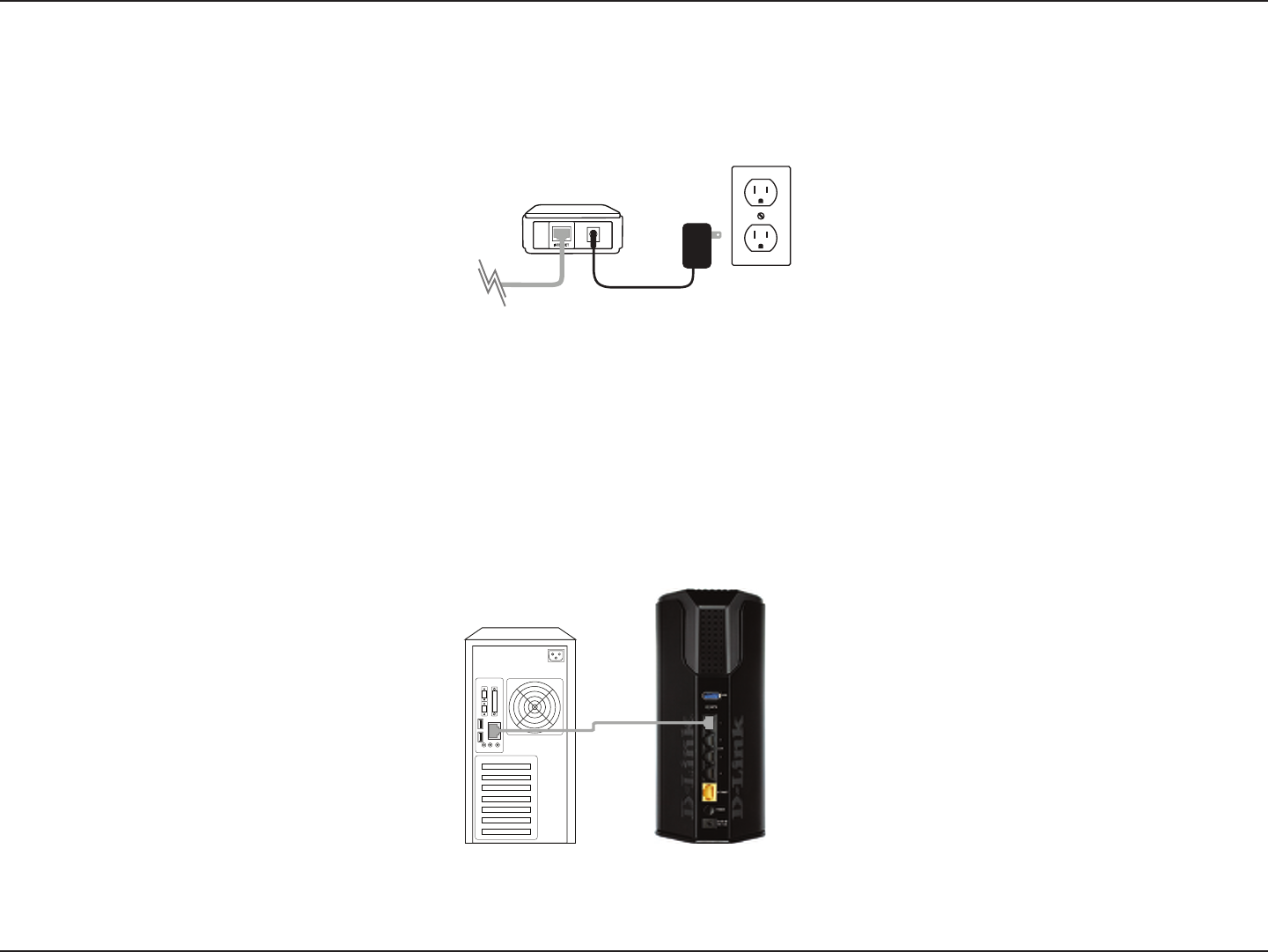
9D-Link DIR-868L User Manual
Section 2 - Installation
1. Turn o and unplug your cable or DSL broadband modem. This is required.
Manual Setup
4
2. Position your router close to your modem and a computer. Place the router in an open area of your intended
work area for better wireless coverage.
3. Unplug the Ethernet cable from your modem (or existing router if upgrading) that is connected to your computer.
Plug it into the LAN port labeled 1 on the back of your router. The router is now connected to your computer.
Modem
DIR-868LComputer
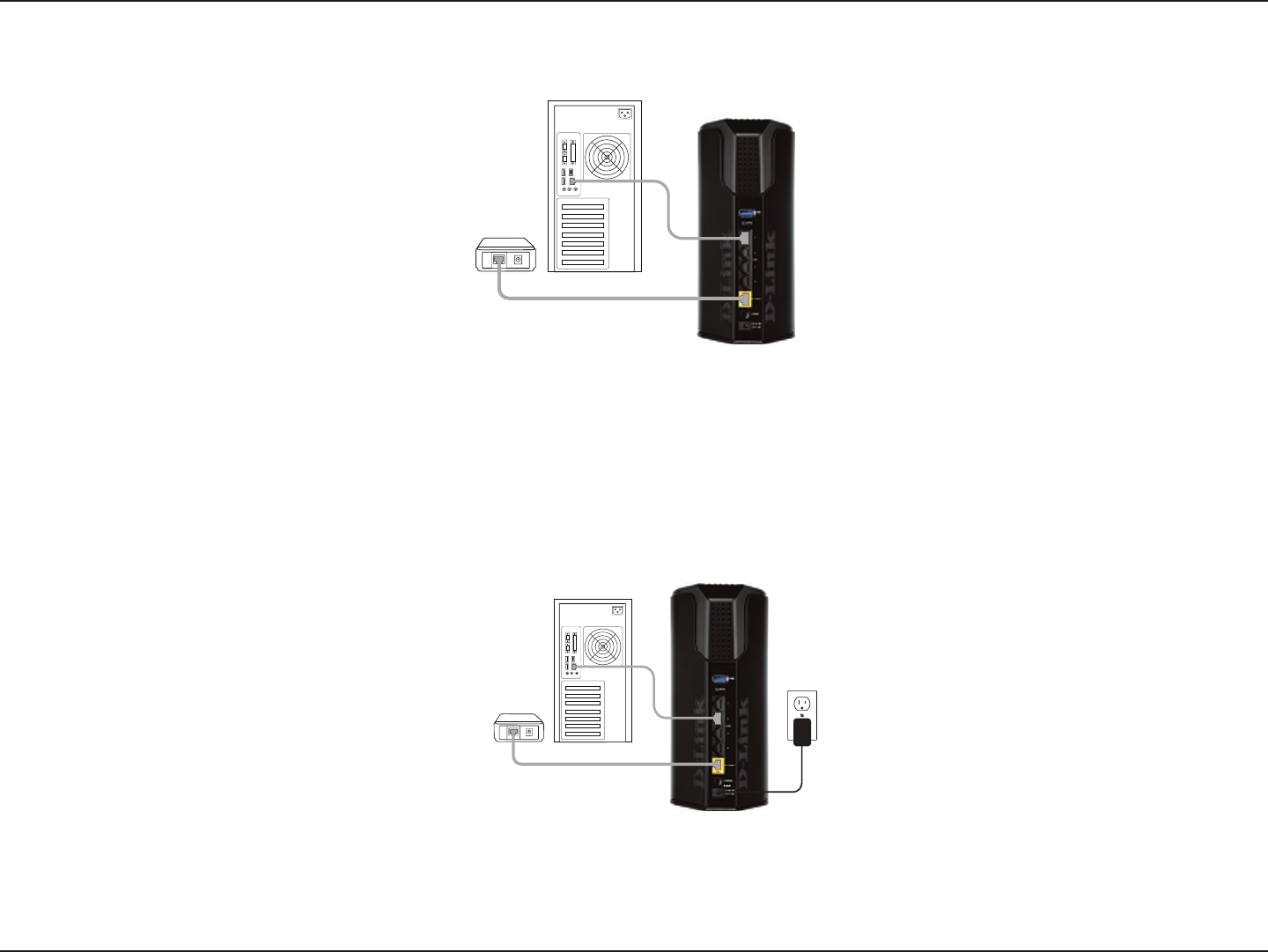
10D-Link DIR-868L User Manual
Section 2 - Installation
4. Plug one end of the included Ethernet cable that came with your router into the yellow port labeled INTERNET
on the back of the router. Plug the other end of this cable into the Ethernet port on your modem.
INTERNET
5. Reconnect the power adapter to your cable or DSL broadband modem and wait for two minutes.
6. Connect the supplied power adapter into the power receptor on the back of the router and then plug it into a
power outlet or surge protector. Press the power button and verify that the power LED is lit. Allow 1 minute for
the router to boot up.
1
INTERNET
7. If you are connecting to a Broadband service, you may be online already and further conguration will be optional.
DIR-868L
DIR-868L
Modem
Computer
Modem
Computer

11D-Link DIR-868L User Manual
Section 2 - Installation
There are several dierent ways you can congure your router to connect to the Internet and connect to your clients:
• D-Link Setup Wizard - This wizard will launch when you log into the router for the rst time. Refer to page 12.
• QRS Mobile App - Use your iPhone, iPad, or iPod Touch to congure your router. Refer to page 19.
• Manual Setup - Log into the router and manually congure your router (advanced users only). Refer to pagepage 26.
Conguration
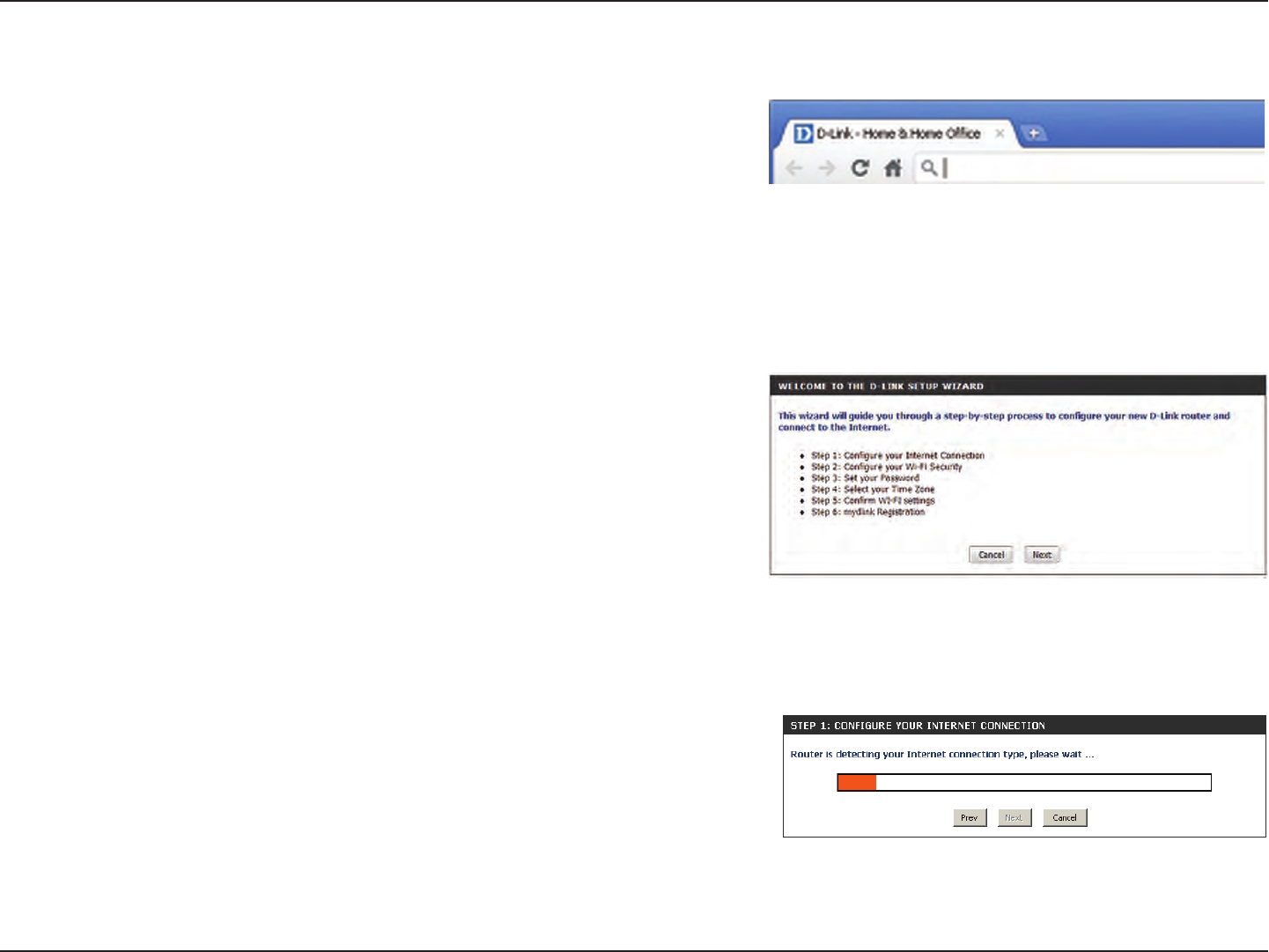
12D-Link DIR-868L User Manual
Section 3 - Conguration
This wizard is designed to guide you through a step-by-step
process to congure your new D-Link router and connect to the
Internet.
Click Next to continue.
D-Link Quick Setup Wizard
If this is your rst time installing the router, open your web browser. You
will automatically be directed to the Wizard Setup Screen.
If the wizard does not open automatically, you can alternately reach
the configuration utility by entering the IP address of the router
(http://192.168.0.1). Please refer to page 24.
Please wait while your router detects your internet connection type.
If the router detects your Internet connection, you may need to enter
your ISP information such as username and password.
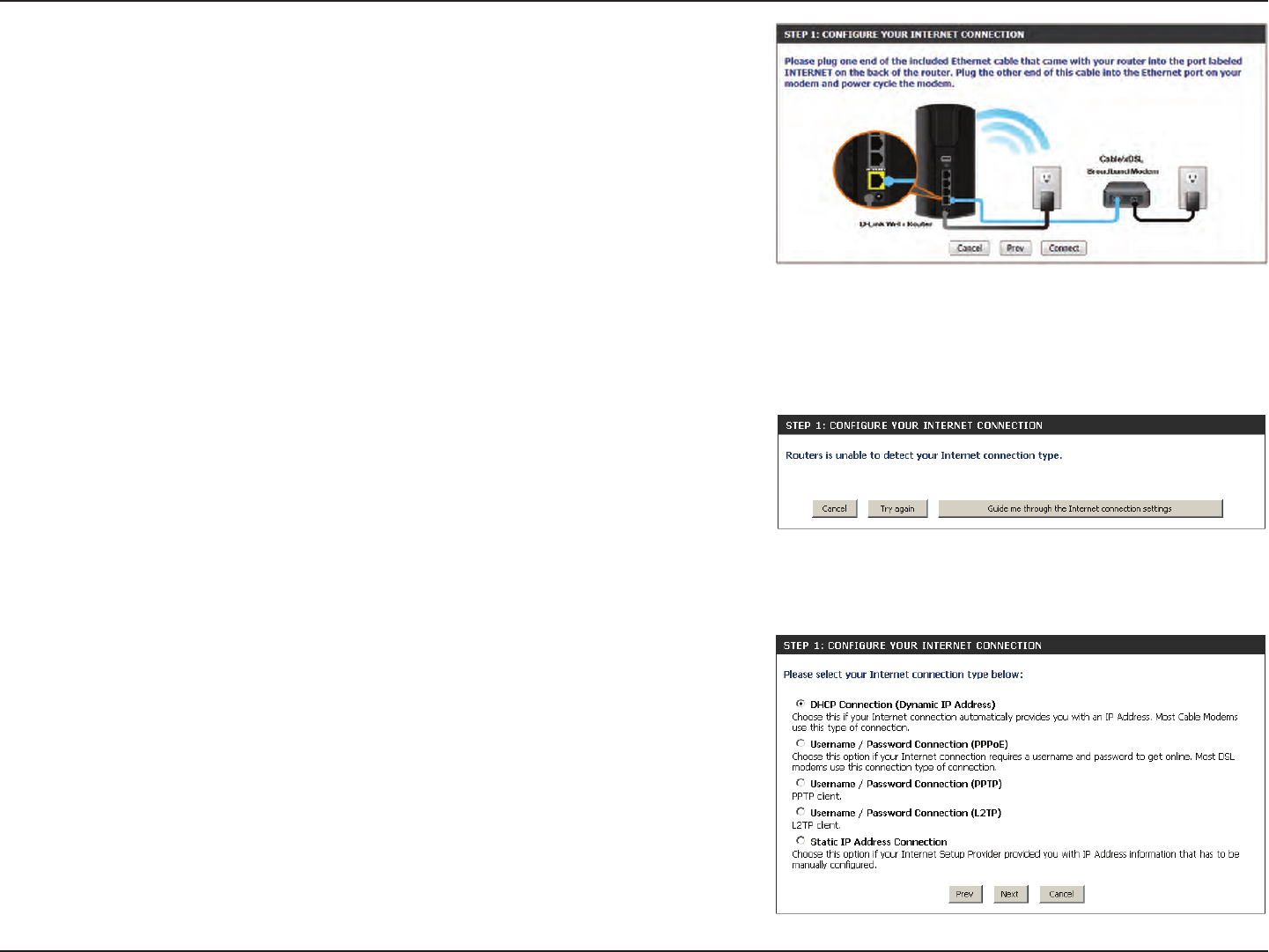
13D-Link DIR-868L User Manual
Section 3 - Conguration
If the router does not detect a valid Ethernet connection from the
Internet port, this screen will appear. Connect your broadband modem
to the Internet port and then click Try Again.
If the router detects an Ethernet connection but does not detect the type
of Internet connection you have, this screen will appear. Click Guide me
through the Internet Connection Settings to display a list of connection
types to choose from.
Select your Internet connection type and click Next to continue.
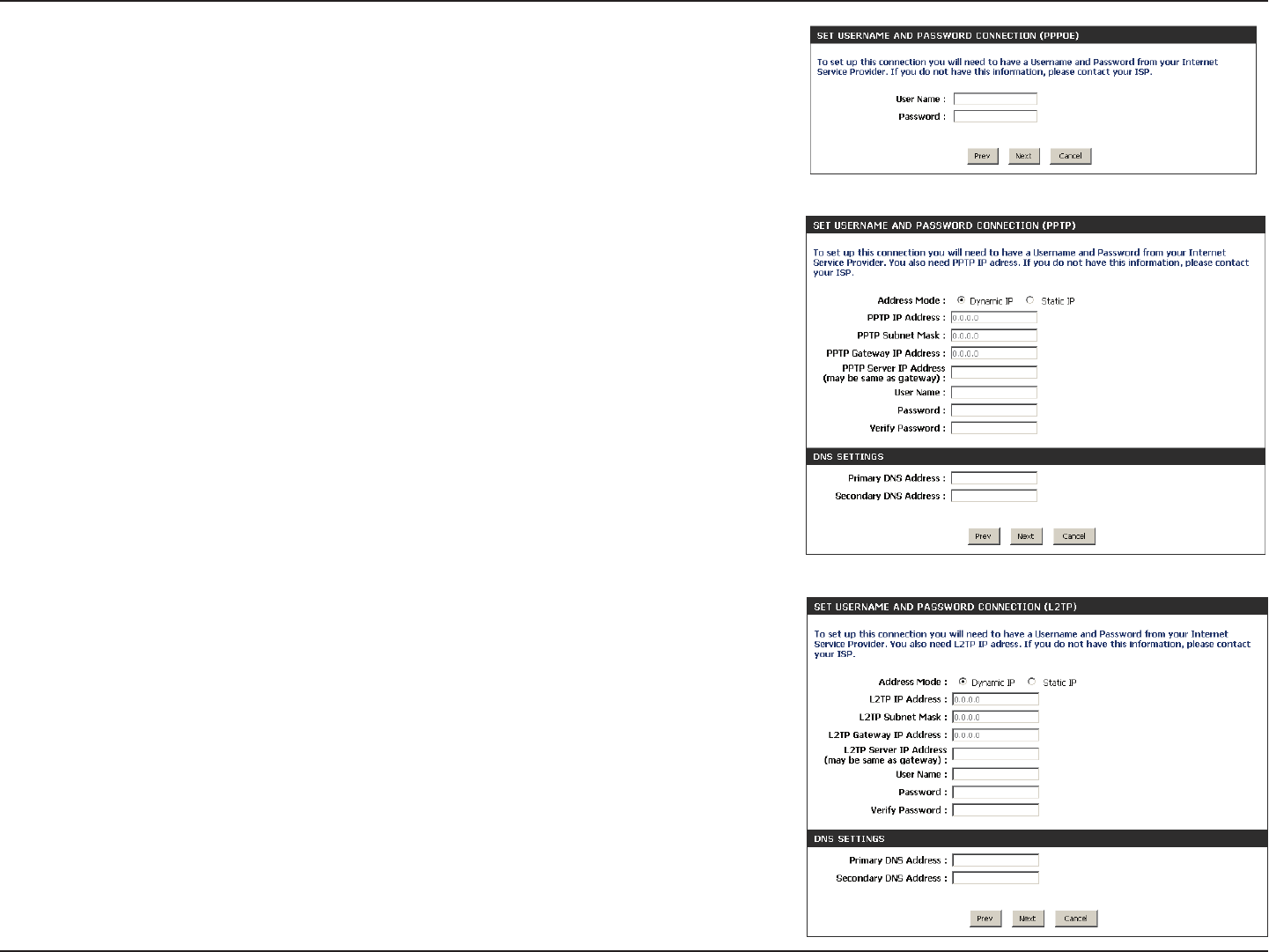
14D-Link DIR-868L User Manual
Section 3 - Conguration
If the router detected or you selected PPPoE, enter your PPPoE username
and password and click Next to continue.
Note: Make sure to remove your PPPoE software from your computer. The
software is no longer needed and will not work through a router.
If the router detected or you selected PPTP, enter your PPTP username,
password, and other information supplied by your ISP. Click Next to
continue.
If the router detected or you selected L2TP, enter your L2TP username,
password, and other information supplied by your ISP. Click Next to
continue.
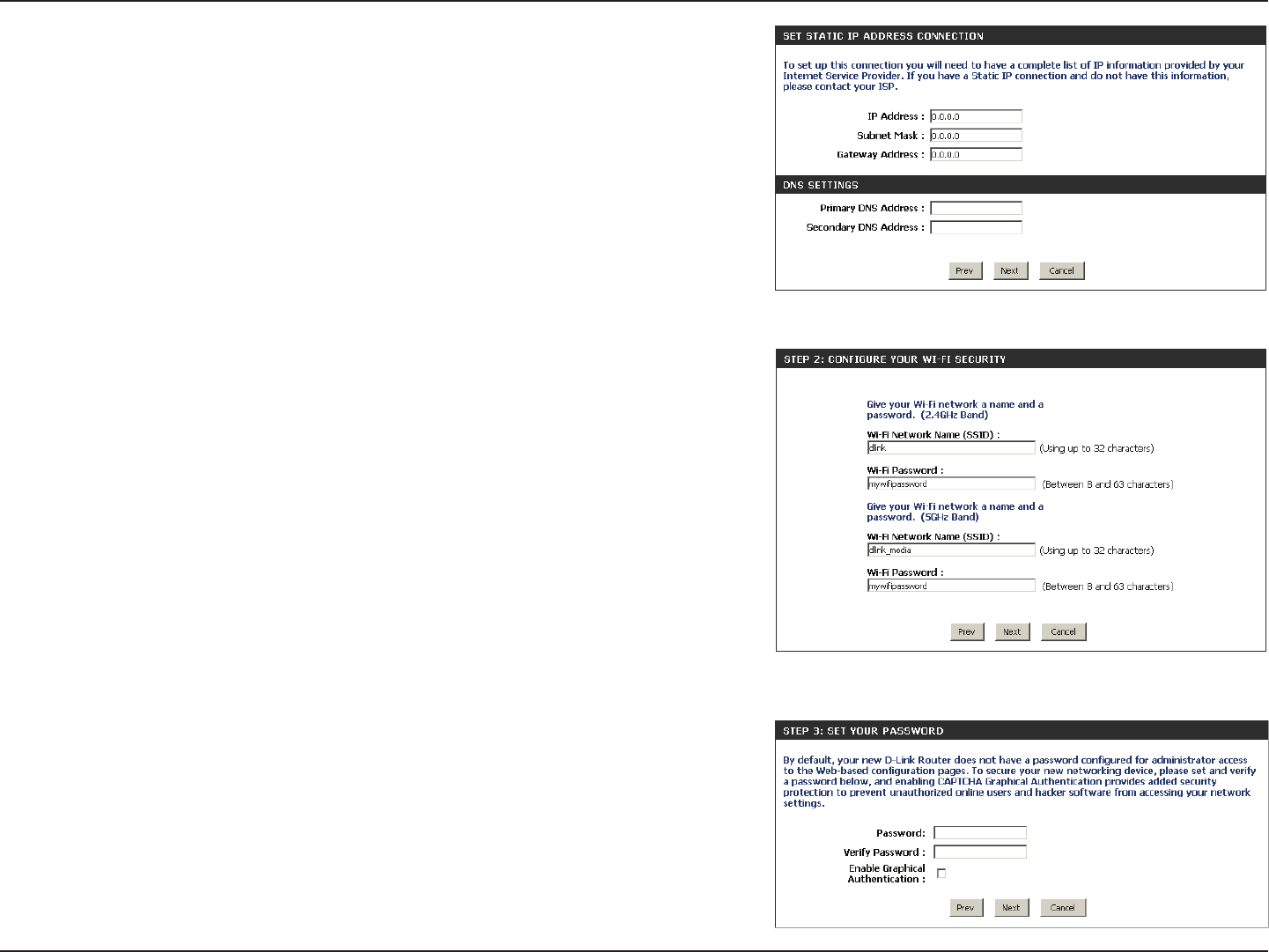
15D-Link DIR-868L User Manual
Section 3 - Conguration
If the router detected or you selected Static, enter the IP and DNS
settings supplied by your ISP. Click Next to continue.
For both the 2.4GHz and 5GHz segments, create a Wi-Fi network name
(SSID) using up to 32 characters.
Create a Wi-Fi password (between 8-63 characters). Your wireless clients
will need to have this passphrase or key entered to be able to connect
to your wireless network.
Click Next to continue.
In order to secure your router, please enter a new password. Check the
Enable Graphical Authentication box to enable CAPTCHA authentication
for added security. Click Next to continue.
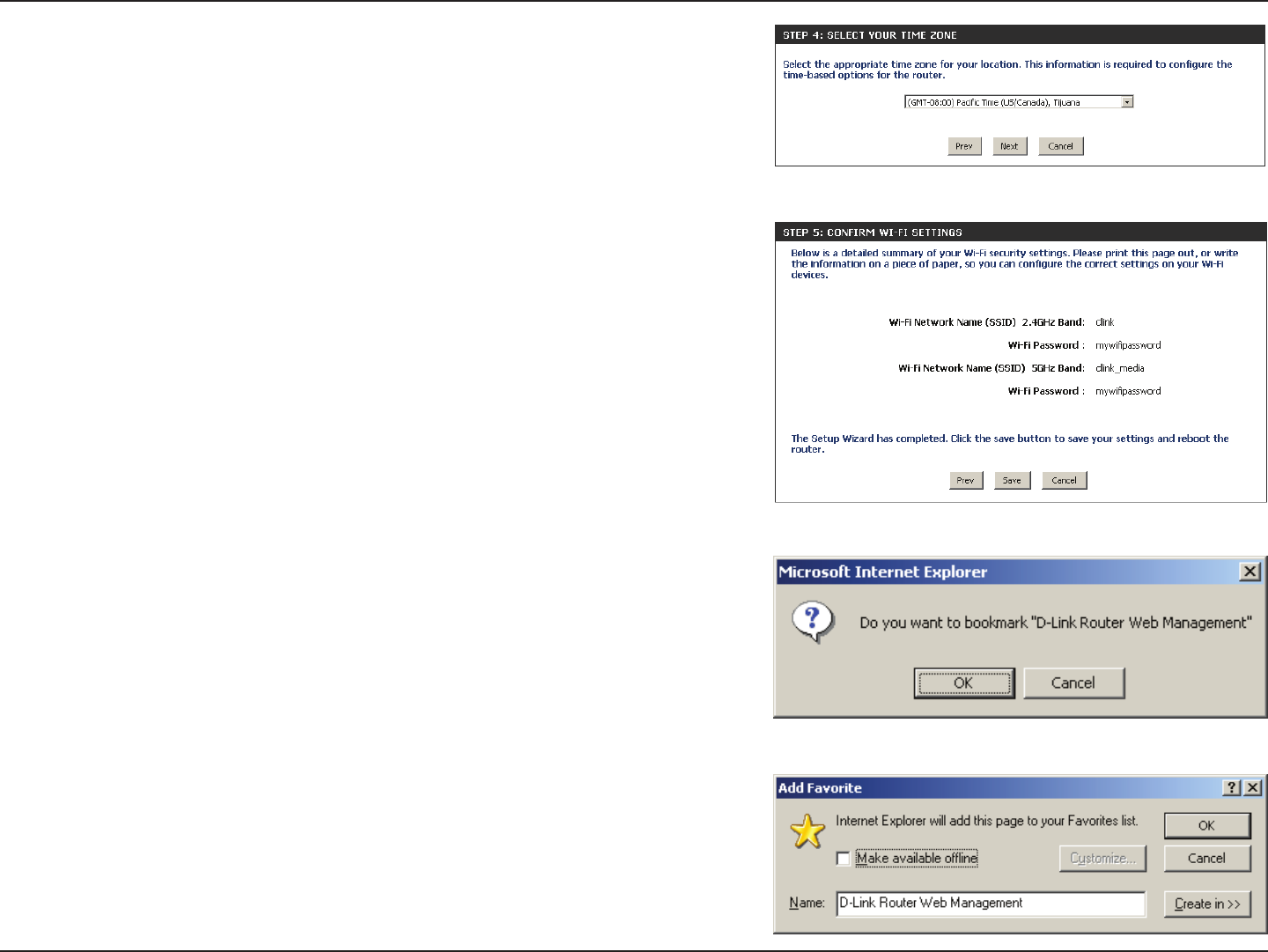
16D-Link DIR-868L User Manual
Section 3 - Conguration
Select your time zone from the drop-down menu and click Next to
continue.
The Setup Complete window will display your Wi-Fi settings. Click Save
and Connect to continue.
If you want to create a bookmark to the router, click OK. Click Cancel if
you do not want to create a bookmark.
If you clicked Yes, a window may appear (depending on what web
browser you are using) to create a bookmark.
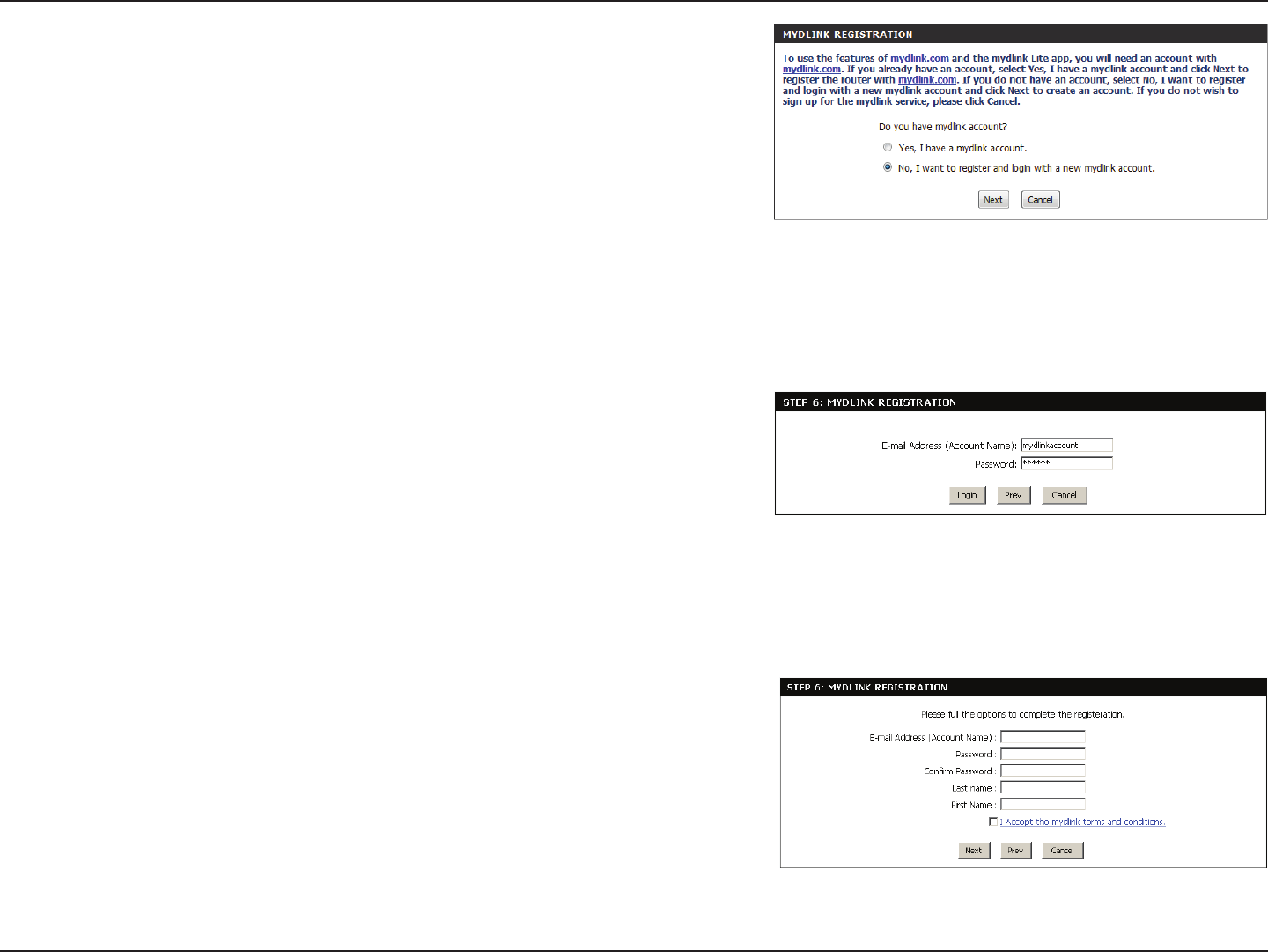
17D-Link DIR-868L User Manual
Section 3 - Conguration
To use the mydlink service (mydlink.com or the mydlink Lite app), you
must have an account. Select if you do have a mydlink account or if you
need to create one. Click Next to continue.
If you do not want to register at this time, click Cancel.
If you clicked Yes, enter your mydlink account name (email address) and
password. Click Login to register your router.
If you clicked No, ll out the requested information and click Next to
create your mydlink account.
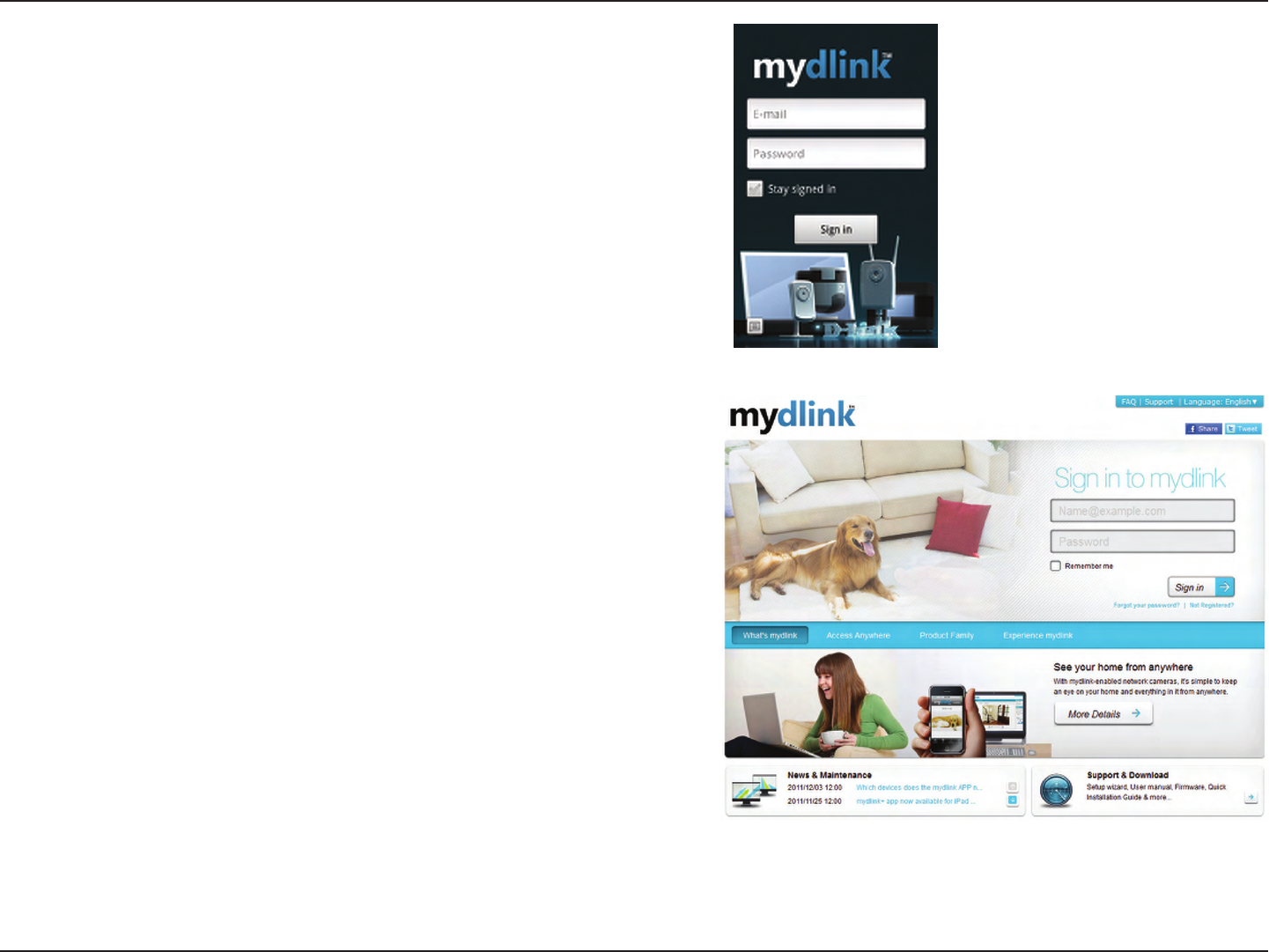
18D-Link DIR-868L User Manual
Section 3 - Conguration
The mydlink App will allow you to receive notices, browse network
users, and congure your router from an iPhone/iPad/iPod Touch
(iOS 3.0 or higher), Android device (1.6 or higher).
To download the "mydlink lite" app, visit the Apple Store, Android
Market or http://mydlink.com/Lite.
PC and Mac users can use the mydlink portal at http://mydlink.com.
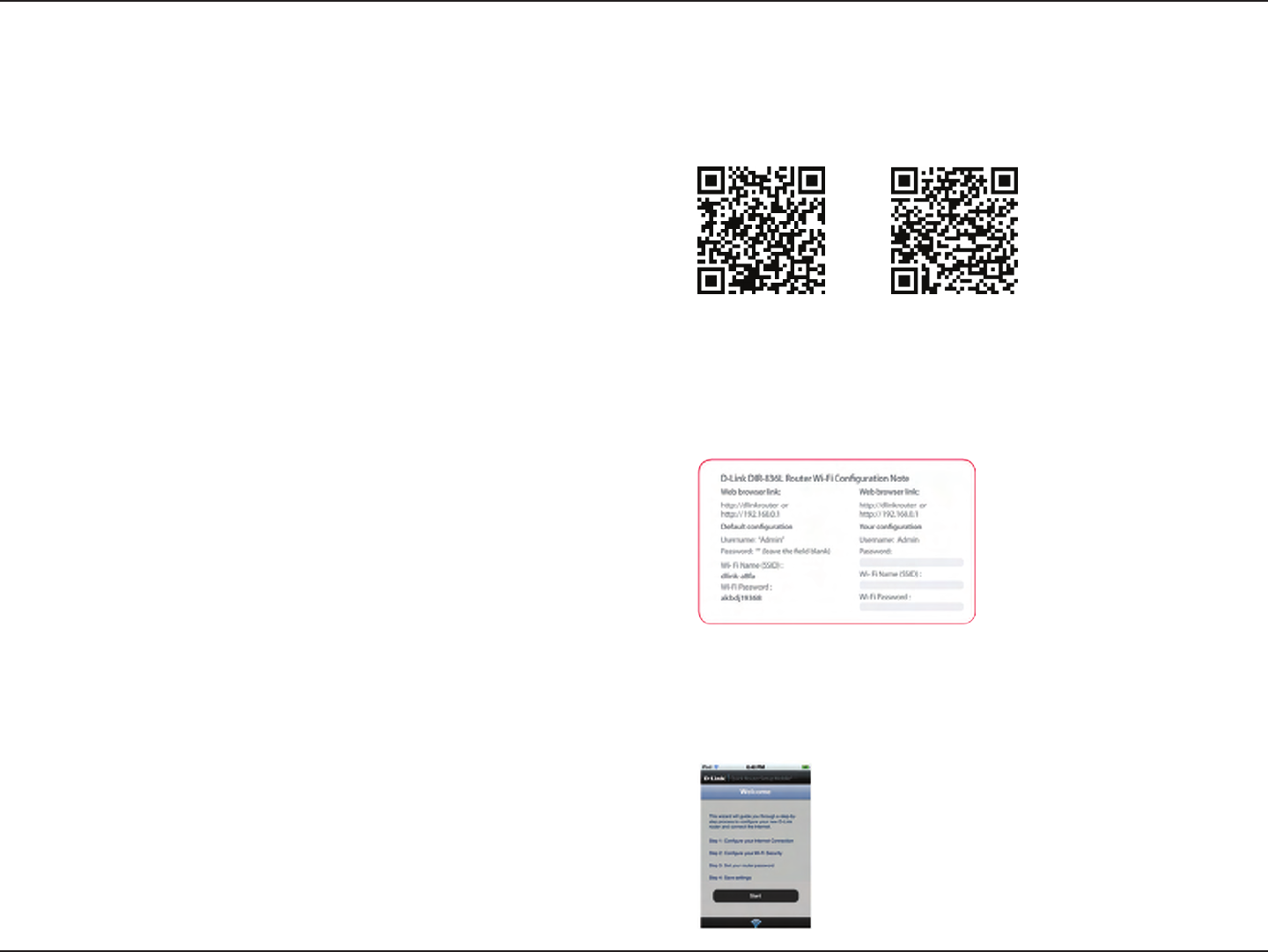
19D-Link DIR-868L User Manual
Section 3 - Conguration
QRS Mobile App (iOS, Android)
D-Link oers an app for your iOS or Android device to install and congure your router.
Step 1
From an iOS device, go to the iTunes Store. From an Android
device go to Google Play. Search for ‘D-Link’, select QRS Mobile,
and download the app to your device. You may also scan the
appropriate code on the right to locate the app download page.
Step 2
Once your app is installed, you may now congure your router.
Connect to the router wirelessly by going to your wireless utility
on your device. Scan for the Wi-Fi name (SSID) as listed on the
supplied info card. Select and then enter your Wi-Fi password.
Step 3
Once you connect to the router, launch the QRS mobile app and
it will guide you through the installation of your router.
iOS Android
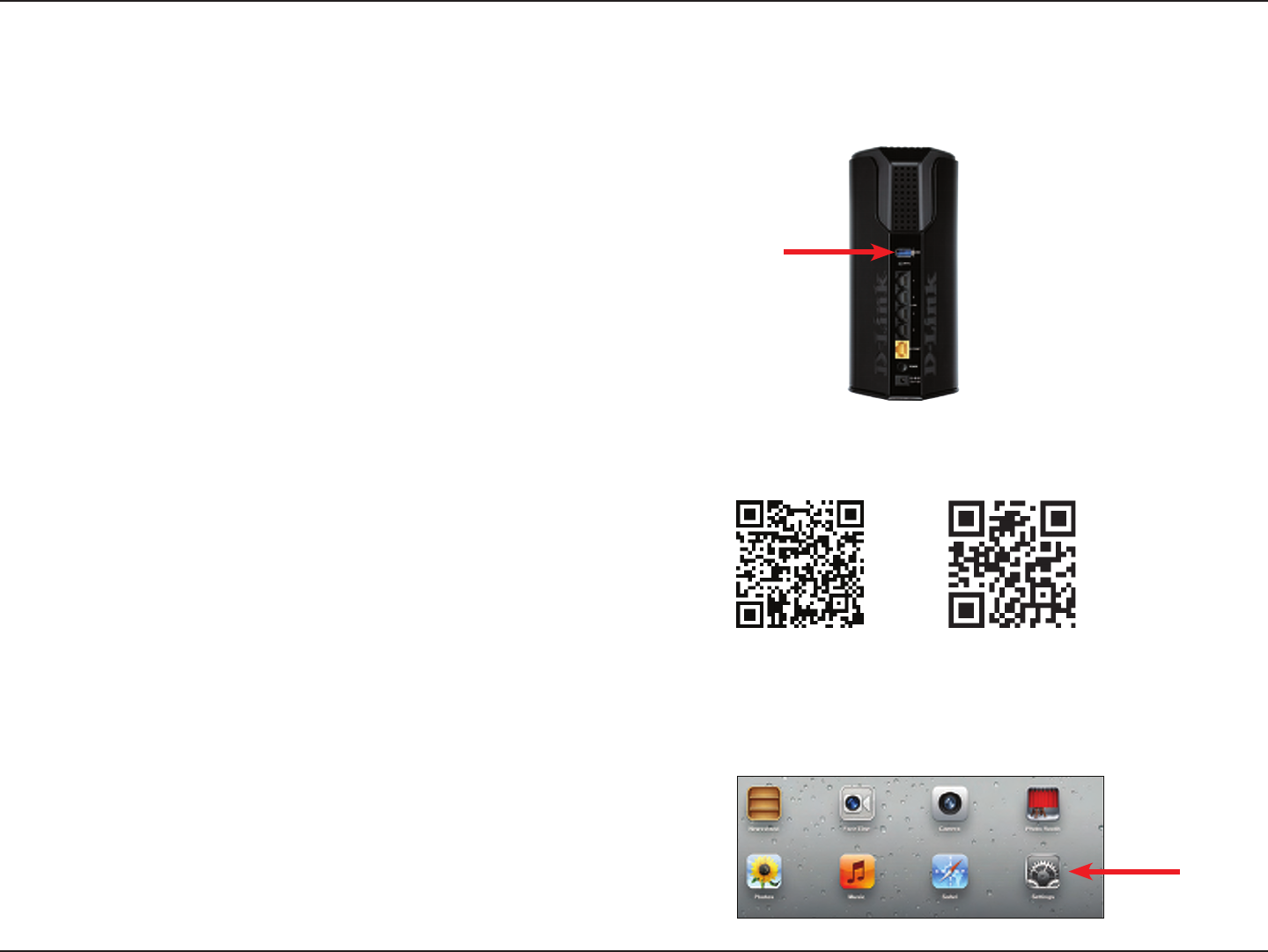
20D-Link DIR-868L User Manual
Section 3 - Conguration
2. Use your iOS or Android mobile device to scan the QR code
to the right to download the SharePort Mobile app.
You can also search for the SharePort Mobile app directly in
the iOS App Store or Google Play.
SharePort Mobile App (iOS, Android)
3. From your iOS or Android mobile device, choose Settings.
Note: These steps are for the iOS version of the
app. The Android version may dier slightly. Settings
iOS Android
USB port
1. Plug your USB storage drive into the USB port.
Note: The DIR-868L supports hard drives with up to
one terabyte of storage capacity.
The SharePort Mobile app will allow you to access les from a USB storage drive that is plugged into your router. You must enable le sharing from
the Setup > Storage page (refer to page 22) for this app to work properly.
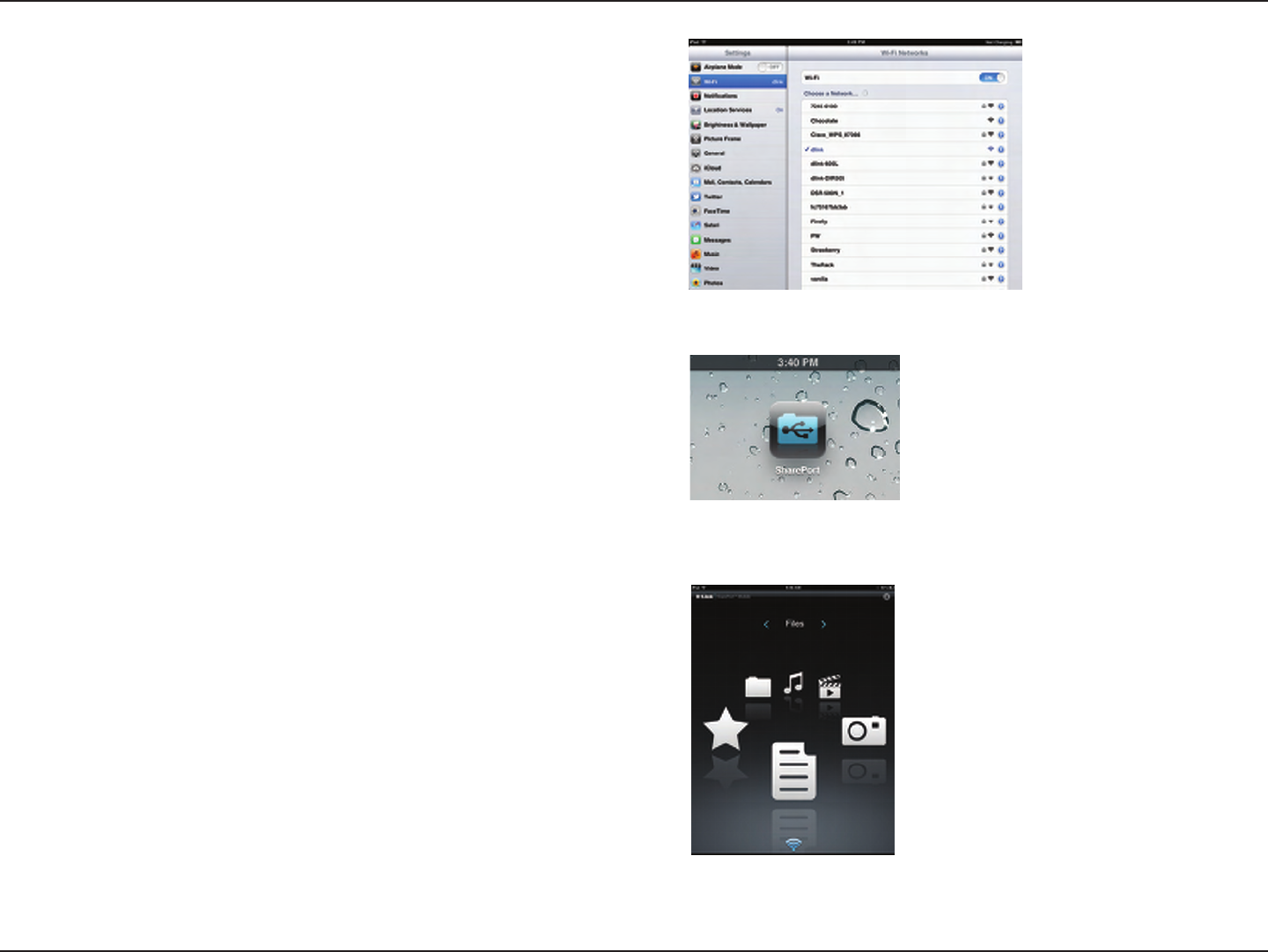
21D-Link DIR-868L User Manual
Section 3 - Conguration
4. Click Wi-Fi, select the Wi-Fi Network Name (SSID) that you created during
setup and then enter the default Wi-Fi password located on your Wi-Fi
conguration note.
6. The following screen will appear.
5. Once connected, tap on the SharePort Mobile icon.
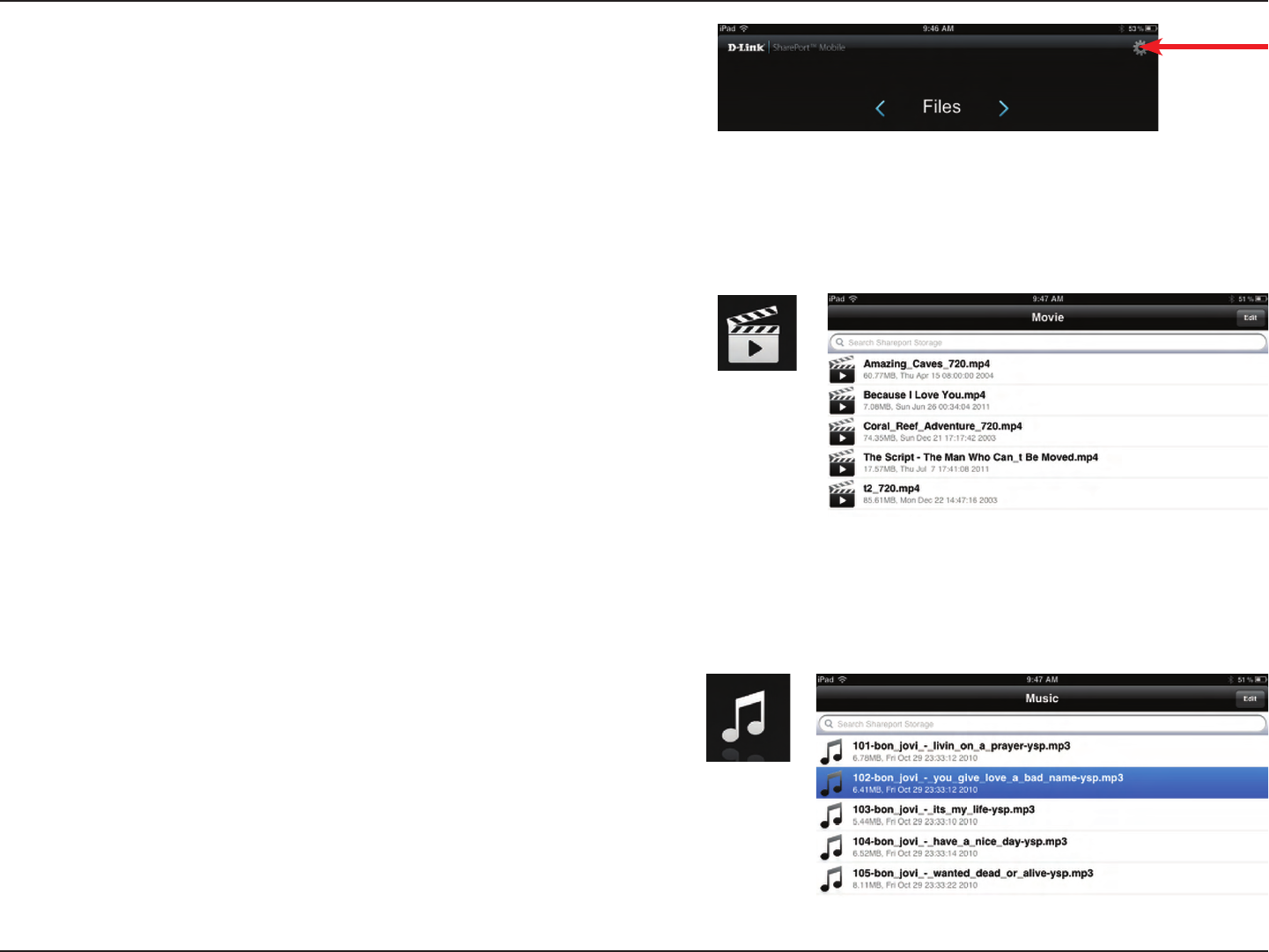
22D-Link DIR-868L User Manual
Section 3 - Conguration
7. Tap on the Settings icon located on the right top corner of the screen.
Tap Edit to enter your User Name and Password (the default username
is admin and the password eld should be left blank). Once you nish,
click Done to continue.
9. For the Music section, click the music icon to play your music from your
USB ash drive.
8. For the Movie section, click the movie icon to play your movie from your
USB ash drive.
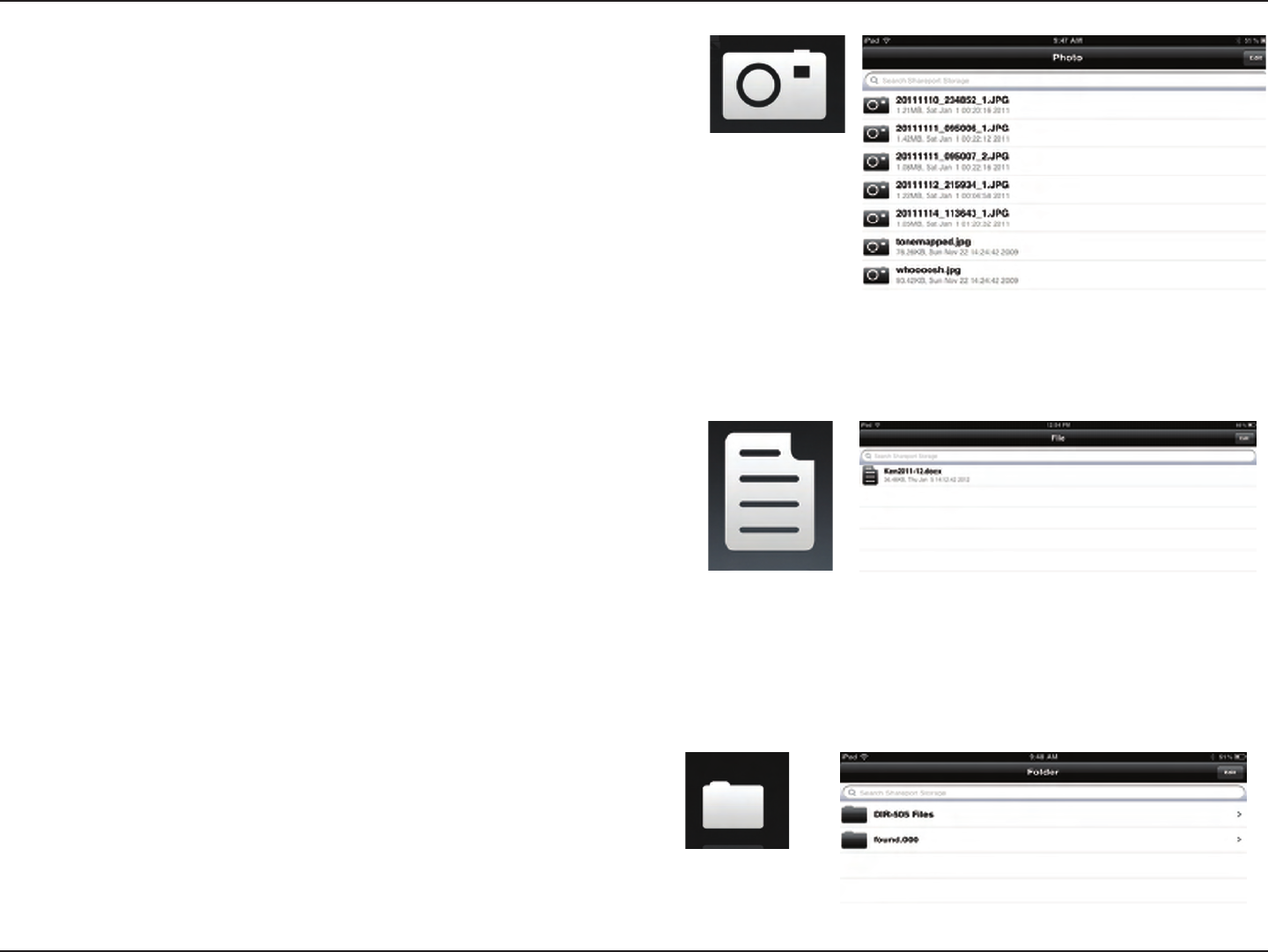
23D-Link DIR-868L User Manual
Section 3 - Conguration
10. For the Photo section, click the Photo icon to view your photos from
your USB ash drive.
11. For the Files section, click on the Files icon to view your les from your
USB ash drive.
12. For the Folder section, click the folder icon to view your folders
from your USB ash drive.
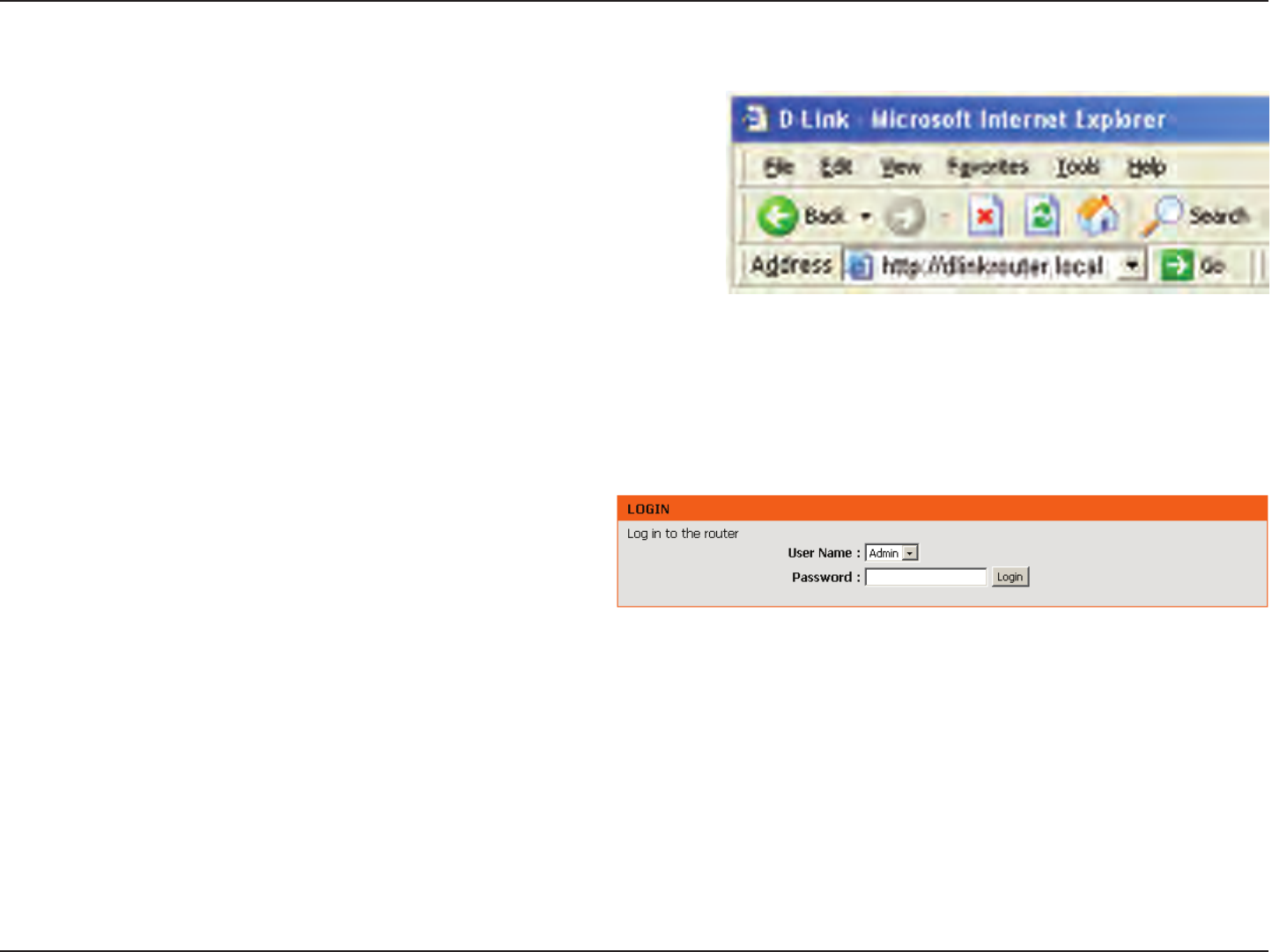
24D-Link DIR-868L User Manual
Section 3 - Conguration
Web-based Conguration Utility
Enter your password. The password should be left blank
by default.
To access the conguration utility, open a web-browser such as
Internet Explorer and enter http://dlinkrouter.local.
Windows and Mac users may also connect by typing the IP address
of the router (http://192.168.0.1) in the address bar.
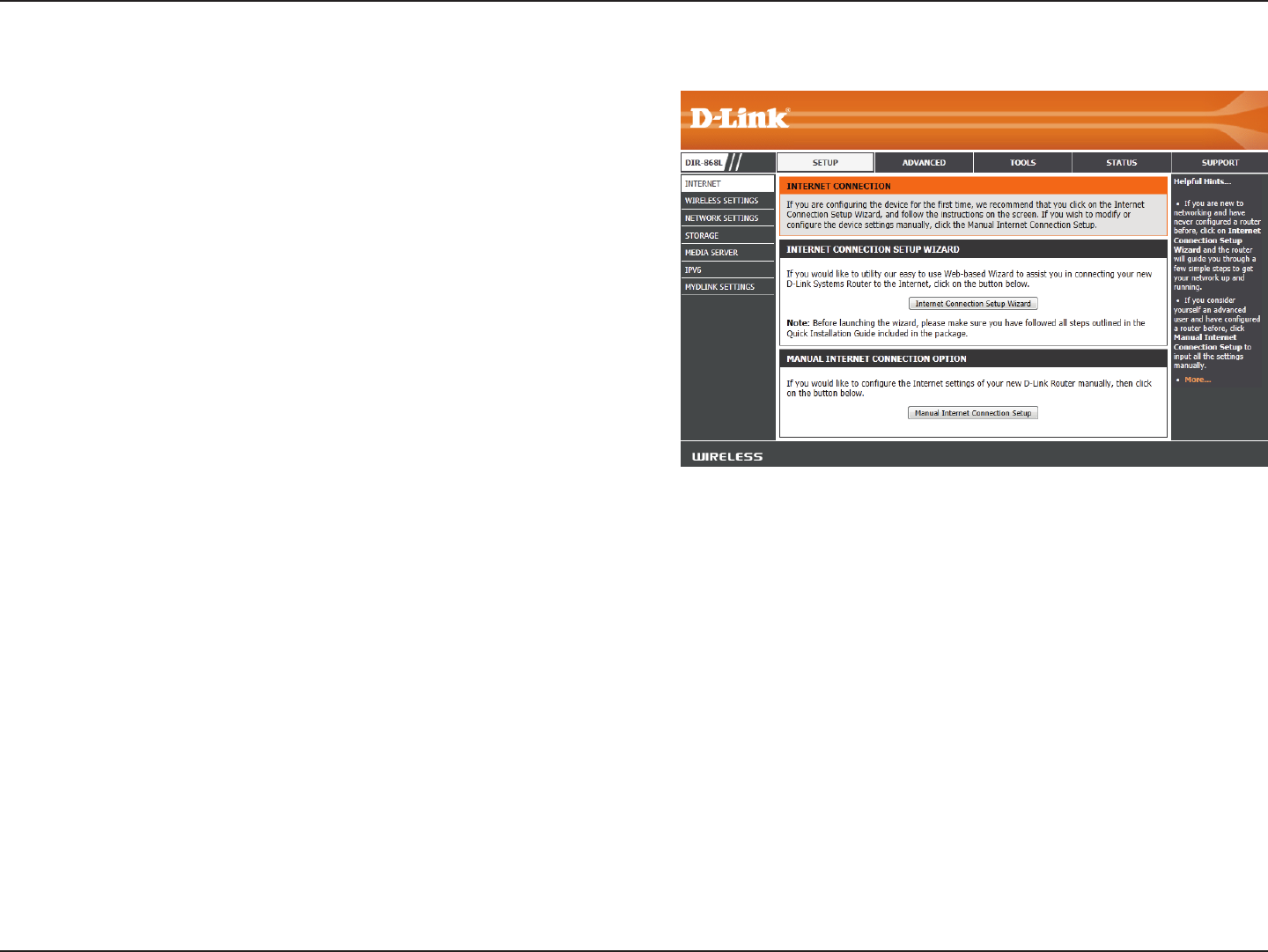
25D-Link DIR-868L User Manual
Section 3 - Conguration
Internet Connection Setup
If you want to congure your router to connect to the Internet
using the wizard, click Internet Connection Setup Wizard.
You will be directed to the Quick Setup Wizard. Please refer
to page 12.
Click Manual Internet Connection Setup to congure your
connection manually and continue to the next page.
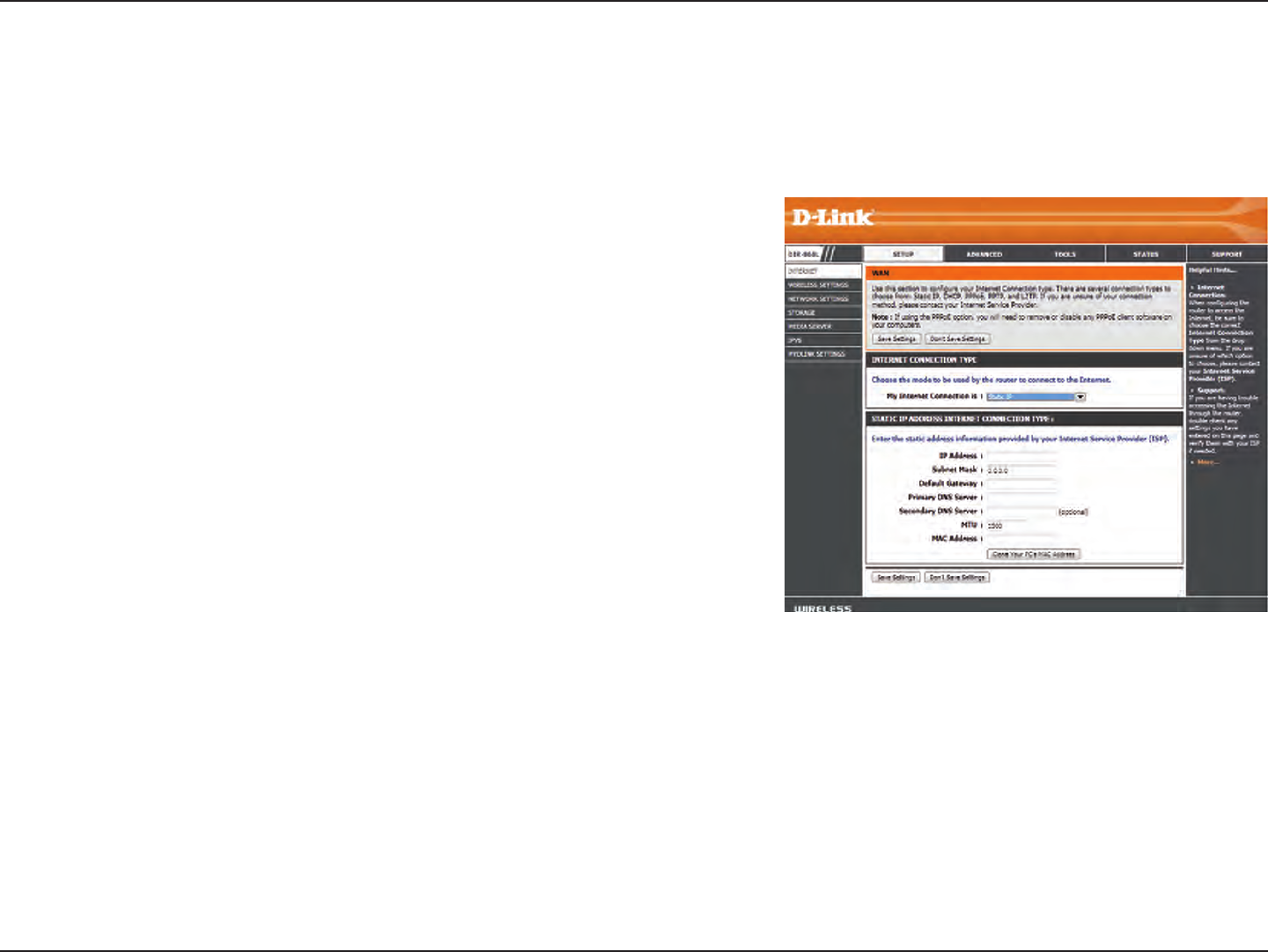
26D-Link DIR-868L User Manual
Section 3 - Conguration
Select Static IP to manually enter the IP settings supplied by your ISP.
Advanced Domain Name System (DNS) services enhances your Internet
performance by getting you the information and web pages you are looking
for faster and more reliably. In addition, it improves your overall Internet
experience by correcting many common typo mistakes automatically,
taking you where you intended to go and saving you valuable time.
Check to enable true Gigabit routing. This will increase the through-put
of the WAN-LAN connectivity of the router.
Enter the IP address assigned by your ISP.
Enter the Subnet Mask assigned by your ISP.
Enter the Gateway assigned by your ISP.
The DNS server information will be supplied by your ISP
Maximum Transmission Unit - you may need to change the MTU for
optimal performance with your specic ISP. 1500 is the default MTU.
The default MAC Address is set to the Internet port’s physical interface MAC address on the Broadband Router. It is not recommended
that you change the default MAC address unless required by your ISP. You can use the Copy Your PC’s MAC Address button to
replace the Internet port’s MAC address with the MAC address of your Ethernet card.
My Internet
Connection Is:
Enable Advanced
DNS Service:
Enable True
Gigabit Routing
Connectivity:
IP Address:
Subnet Mask:
Default Gateway:
DNS Servers:
MTU:
MAC Address:
Manual Internet Setup
Static IP
Select your connection type from the My Internet Connect Is drop-down box. Choose Static IP if all of the port’s IP information has been provided
by your ISP. You will need to enter the IP address, subnet mask, gateway address, and DNS address(es). Each IP address entered in the elds must
be in the appropriate IP form, which are four octets separated by a dot (x.x.x.x). The Router will not accept the IP address if it is not in this format.
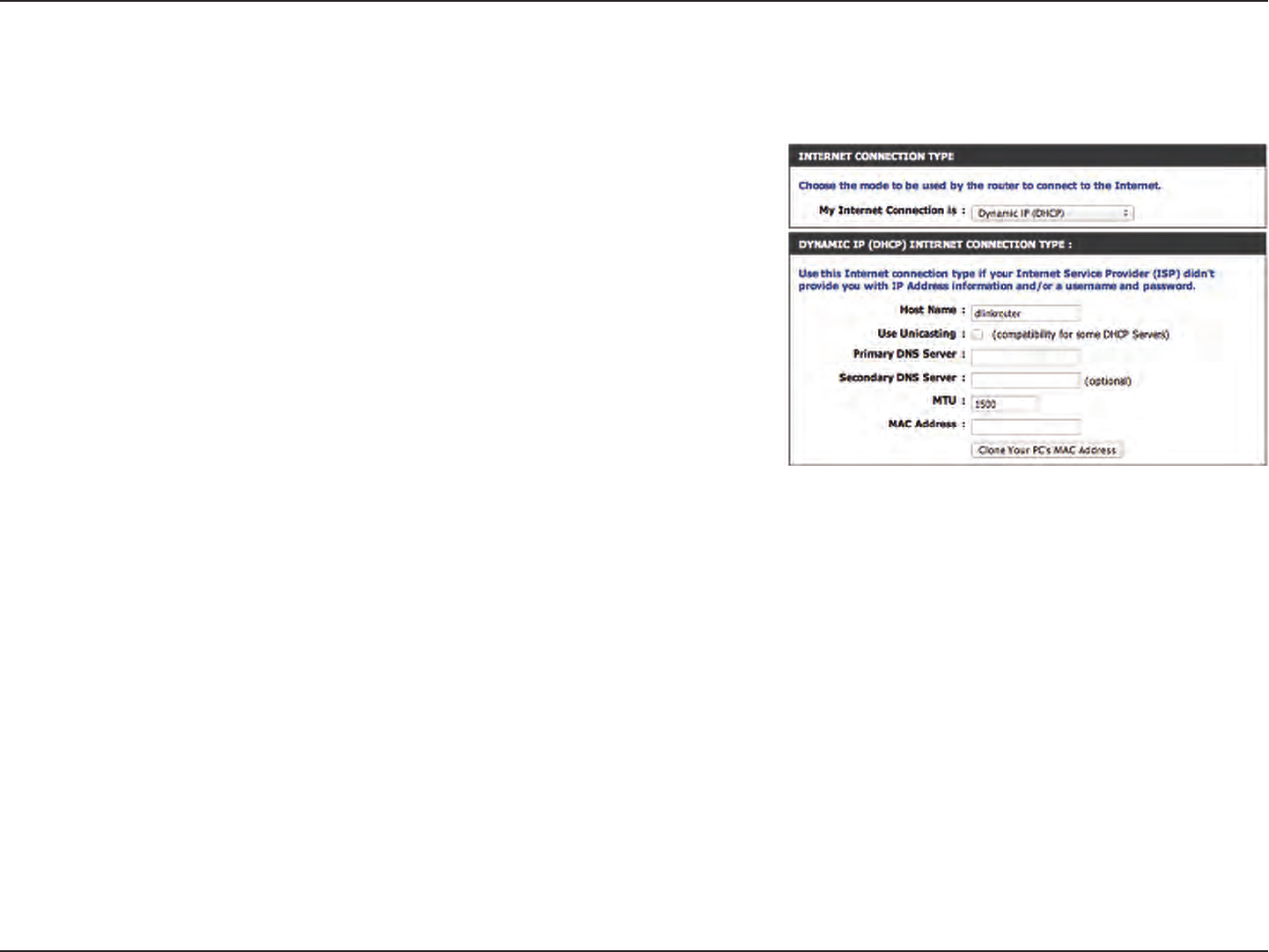
27D-Link DIR-868L User Manual
Section 3 - Conguration
Select Dynamic IP (DHCP) to obtain IP Address information automatically
from your ISP. Select this option if your ISP does not give you any IP
numbers to use. This option is commonly used for cable modem services.
Advanced Domain Name System (DNS) services enhances your Internet
performance by getting you the information and web pages you are looking
for faster and more reliably. In addition, it improves your overall Internet
experience by correcting many common typo mistakes automatically,
taking you where you intended to go and saving you valuable time.
Disclaimer: D-Link makes no warranty as to the availability, reliability,
functionality and operation of the Advanced DNS service or its features.
Check to enable true Gigabit routing. This will increase the through-put of the WAN-LAN connectivity of the router.
The Host Name is optional but may be required by some ISPs. Leave blank if you are not sure.
Check the box if you are having problems obtaining an IP address from your ISP.
Enter the Primary and secondary DNS server IP addresses assigned by your ISP. These addresses are usually obtained automatically
from your ISP. Leave at 0.0.0.0 if you did not specically receive these from your ISP.
Maximum Transmission Unit - you may need to change the MTU for optimal performance with your specic ISP. 1500 is the default
MTU.
The default MAC Address is set to the Internet port’s physical interface MAC address on the Broadband Router. It is not recommended
that you change the default MAC address unless required by your ISP. You can use the Copy Your PC’s MAC Address button to
replace the Internet port’s MAC address with the MAC address of your Ethernet card.
My Internet
Connection:
Enable Advanced
DNS Service:
Enable True
Gigabit Routing
Connectivity:
Host Name:
Use Unicasting:
Primary/Secondary
DNS Server:
MTU:
MAC Address:
Dynamic IP (DHCP)
If you are unsure what method you use to connect to the Internet, try this rst. Cable modems usually use this type of connection
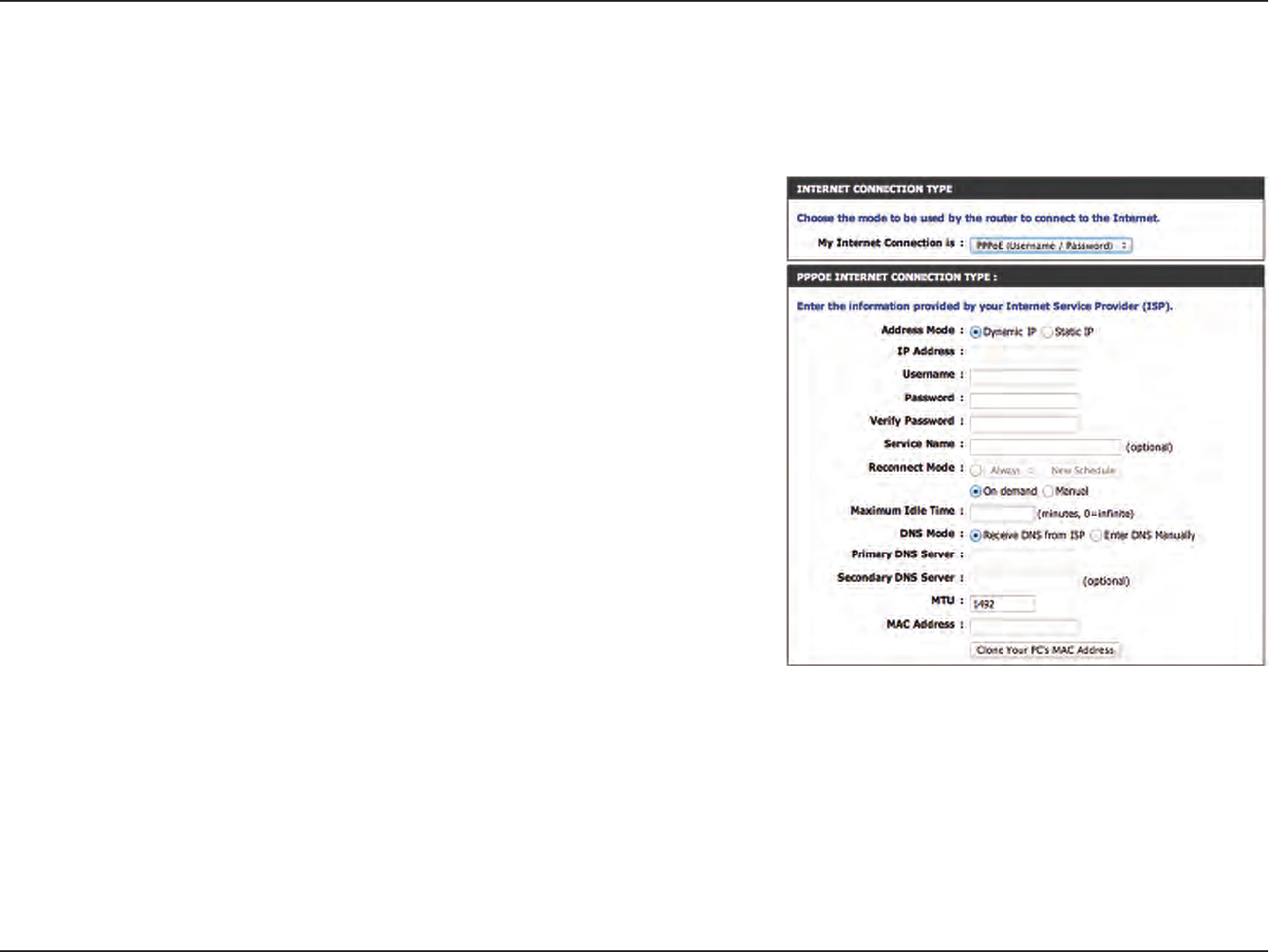
28D-Link DIR-868L User Manual
Section 3 - Conguration
Select PPPoE (Username/Password) from the drop-down menu.
Advanced Domain Name System (DNS) services enhances your Internet
performance by getting you the information and web pages you are looking
for faster and more reliably. In addition, it improves your overall Internet
experience by correcting many common typo mistakes automatically,
taking you where you intended to go and saving you valuable time.
Disclaimer: D-Link makes no warranty as to the availability, reliability,
functionality and operation of the Advanced DNS service or its features.
Check to enable true Gigabit routing. This will increase the through-put
of the WAN-LAN connectivity of the router.
Select Static IP if your ISP assigned you the IP address, subnet mask,
gateway, and DNS server addresses. In most cases, select Dynamic.
Enter the IP address (Static PPPoE only).
Enter your PPPoE user name.
Enter your PPPoE password and then retype the password in the next box.
Enter the ISP Service Name (optional).
Select either Always-on, On-Demand, or Manual.
My Internet
Connection:
Enable
Advanced DNS
Service:
Enable True
Gigabit Routing
Connectivity:
Address Mode:
IP Address:
User Name:
Password:
Service Name:
Reconnect
Mode:
PPPoE (Username/Password)
Choose PPPoE (Point to Point Protocol over Ethernet) if your ISP uses a PPPoE connection. Your ISP will provide you with a username and password.
This option is typically used for DSL services. Make sure to remove your PPPoE software from your computer. The software is no longer needed and
will not work through a router.

29D-Link DIR-868L User Manual
Section 3 - Conguration
Maximum
Idle Time:
DNS
Addresses:
MTU:
MAC Address:
Enter a maximum idle time during which the Internet connection is maintained during inactivity. To disable this feature, enable
Auto-reconnect.
Enter the Primary and Secondary DNS Server Addresses (Static PPPoE only).
Maximum Transmission Unit - you may need to change the MTU for optimal performance with your specic ISP. 1492 is the default
MTU.
The default MAC Address is set to the Internet port’s physical interface MAC address on the Broadband Router. It is not recommended
that you change the default MAC address unless required by your ISP. You can use the Copy Your PC’s MAC Address button to
replace the Internet port’s MAC address with the MAC address of your Ethernet card.
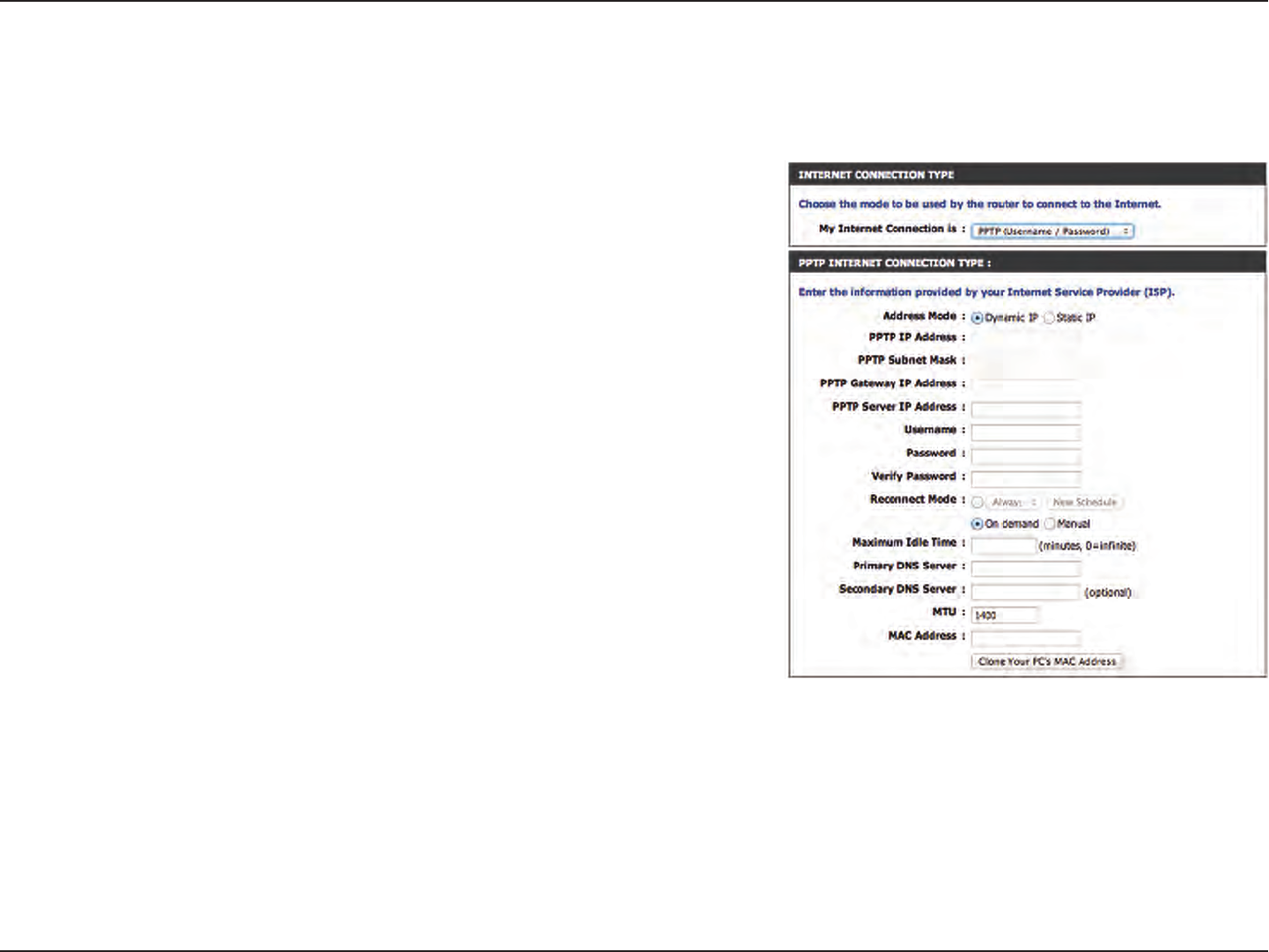
30D-Link DIR-868L User Manual
Section 3 - Conguration
Select PPTP (Username/Password) from the drop-down menu.
Advanced Domain Name System (DNS) services enhances your Internet
performance by getting you the information and web pages you are looking
for faster and more reliably. In addition, it improves your overall Internet
experience by correcting many common typo mistakes automatically,
taking you where you intended to go and saving you valuable time.
Disclaimer: D-Link makes no warranty as to the availability, reliability,
functionality and operation of the Advanced DNS service or its features.
Check to enable true Gigabit routing. This will increase the throughput of
the WAN-LAN connectivity of the router.
Select Static if your ISP assigned you the IP address, subnet mask,
gateway, and DNS server addresses. In most cases, select Dynamic.
Enter the IP address (Static PPTP only).
Enter the Primary and Secondary DNS Server Addresses (Static PPTP only).
Enter the Gateway IP Address provided by your ISP.
Enter the Server IP provided by your ISP (optional).
Enter your PPTP username.
Enter your PPTP password and then retype the password in the next box.
Select either Always-on, On-Demand, or Manual.
PPTP
Choose PPTP (Point-to-Point-Tunneling Protocol ) if your ISP uses a PPTP connection. Your ISP will provide you with a username and password. This
option is typically used for DSL services.
My Internet
Connection:
Enable Advanced
DNS Service:
Enable True
Gigabit Routing
Connectivity:
Address Mode:
PPTP IP Address:
PPTP Subnet Mask:
PPTP Gateway:
PPTP Server IP:
Username:
Password:
Reconnect Mode:
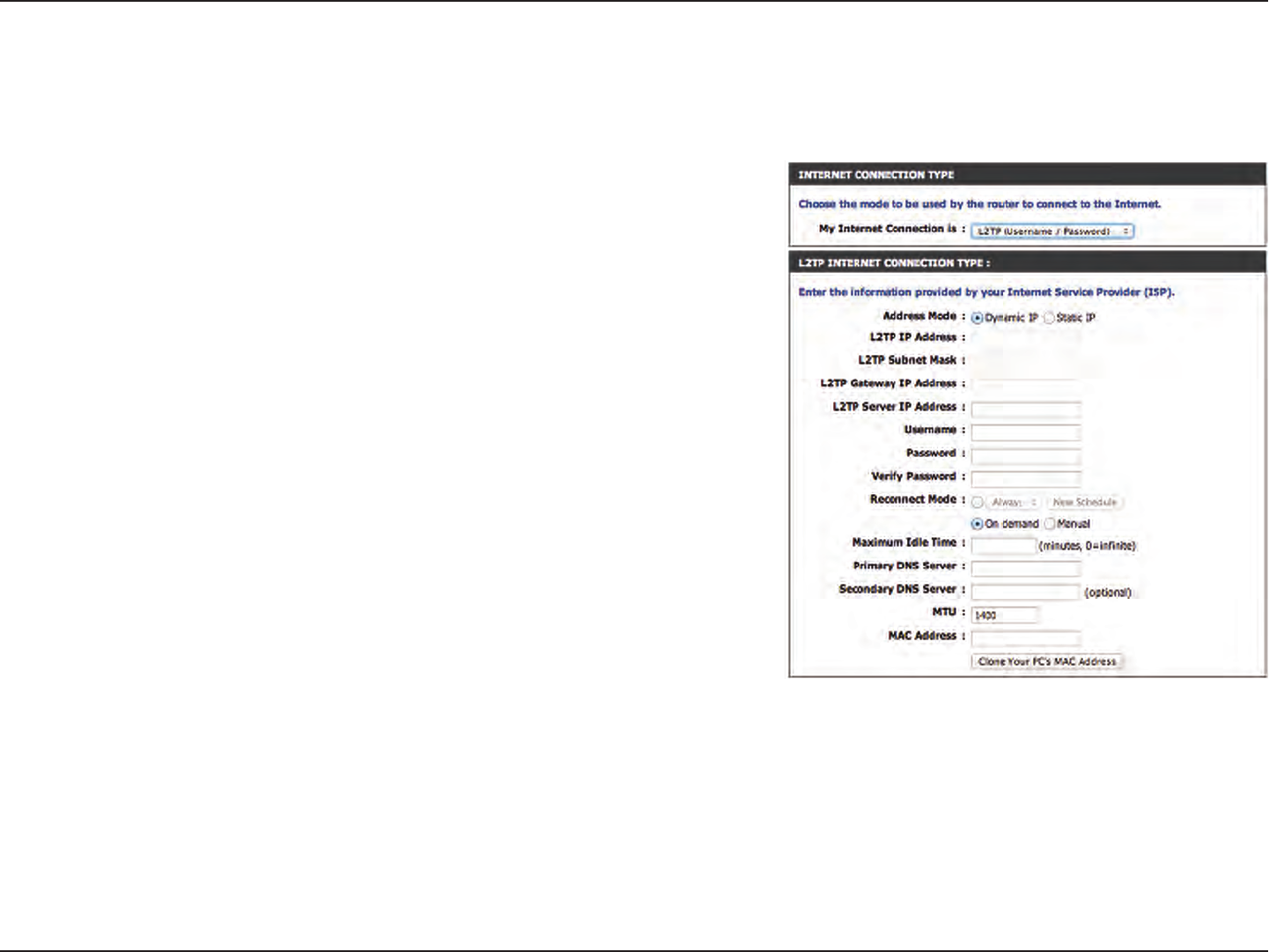
31D-Link DIR-868L User Manual
Section 3 - Conguration
Select L2TP (Username/Password) from the drop-down menu.
Advanced Domain Name System (DNS) services enhances your Internet
performance by getting you the information and web pages you are looking
for faster and more reliably. In addition, it improves your overall Internet
experience by correcting many common typo mistakes automatically,
taking you where you intended to go and saving you valuable time.
Disclaimer: D-Link makes no warranty as to the availability, reliability,
functionality and operation of the Advanced DNS service or its features.
Check to enable true Gigabit routing. This will increase the throughput of
the WAN-LAN connectivity of the router.
Select Static if your ISP assigned you the IP address, subnet mask,
gateway, and DNS server addresses. In most cases, select Dynamic.
Enter the IP address (Static PPTP only).
Enter the Primary and Secondary DNS Server Addresses (Static PPTP only).
Enter the Gateway IP Address provided by your ISP.
Enter the Server IP provided by your ISP (optional).
Enter your PPTP username.
Enter your PPTP password and then retype the password in the next box.
Select either Always-on, On-Demand, or Manual.
L2TP
Choose L2TP (Layer 2 Tunneling Protocol ) if your ISP uses a L2TP connection. Your ISP will provide you with a username and password. This option
is typically used for DSL services.
My Internet
Connection:
Enable Advanced
DNS Service:
Enable True
Gigabit Routing
Connectivity:
Address Mode:
PPTP IP Address:
PPTP Subnet Mask:
PPTP Gateway:
PPTP Server IP:
Username:
Password:
Reconnect Mode:

32D-Link DIR-868L User Manual
Section 3 - Conguration
Enter a maximum idle time during which the Internet connection is maintained during inactivity. To disable this feature, enable
Auto-reconnect.
The DNS server information will be supplied by your ISP (Internet Service Provider.)
Maximum Transmission Unit - you may need to change the MTU for optimal performance with your specic ISP. 1400 is the default
MTU.
The default MAC Address is set to the Internet port’s physical interface MAC address on the Broadband Router. It is not recommended
that you change the default MAC address unless required by your ISP. You can use the Clone Your PC’s MAC Address button to
replace the Internet port’s MAC address with the MAC address of your Ethernet card.
Maximum Idle
Time:
DNS Servers:
MTU:
MAC Address:
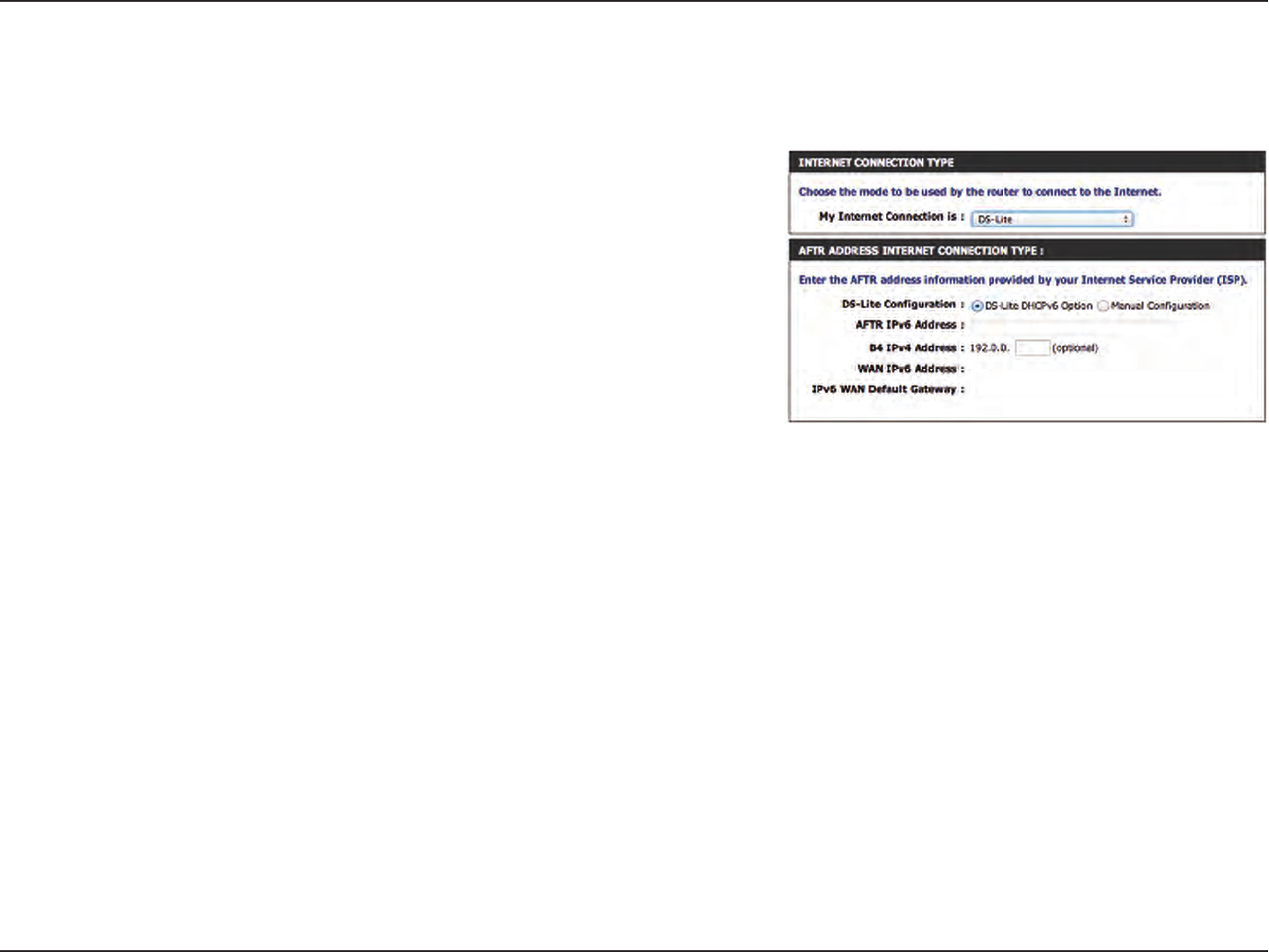
33D-Link DIR-868L User Manual
Section 3 - Conguration
DS-Lite
DS-Lite is an IPv6 connection type. After selecting DS-Lite, the following parameters will be available for conguration:
DS-Lite
Conguration:
AFTR IPv6 Address:
B4 IPv4 Address:
WAN IPv6 Address:
IPv6 WAN Default
Gateway:
Select the DS-Lite DHCPv6 option to let the router allocate the AFTR
IPv6 address automatically. Select the Manual Conguration to enter
the AFTR IPv6 address in manually.
After selecting the Manual Conguration option above, enter the AFTR
IPv6 address used here.
Enter the B4 IPv4 address value used here.
Once connected, the WAN IPv6 address will be displayed here.
Once connected, the IPv6 WAN Default Gateway address will be
displayed here.
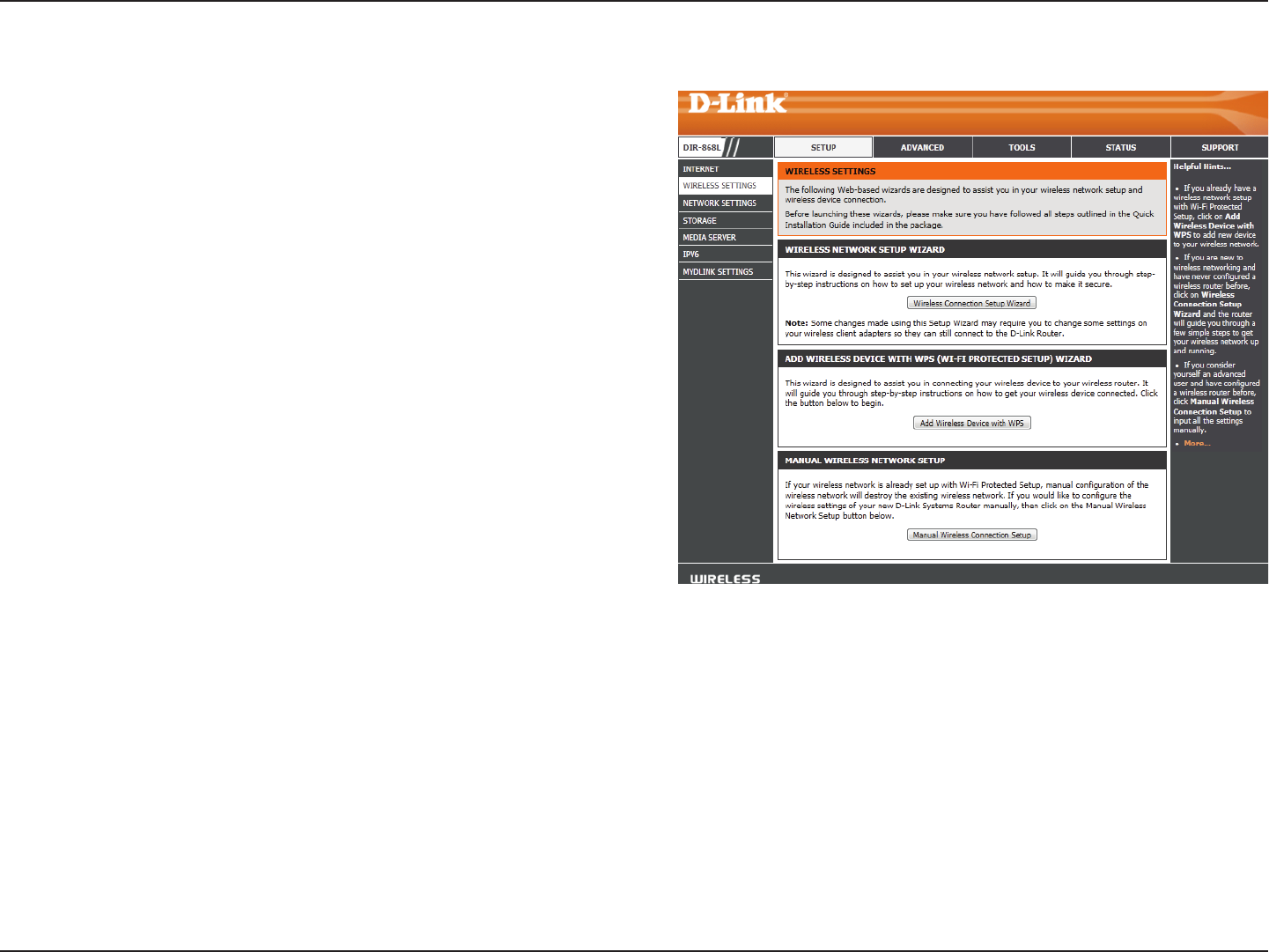
34D-Link DIR-868L User Manual
Section 3 - Conguration
Wireless Settings
If you want to congure the wireless settings on your router using the wizard,
click Wireless Network Setup Wizard and refer to page 42.
Click Add Wireless Device with WPS if you want to add a wireless device
using Wi-Fi Protected Setup (WPS) and refer to page 44.
If you want to manually congure the wireless settings on your router click
Manual Wireless Network Setup and refer to the next page.
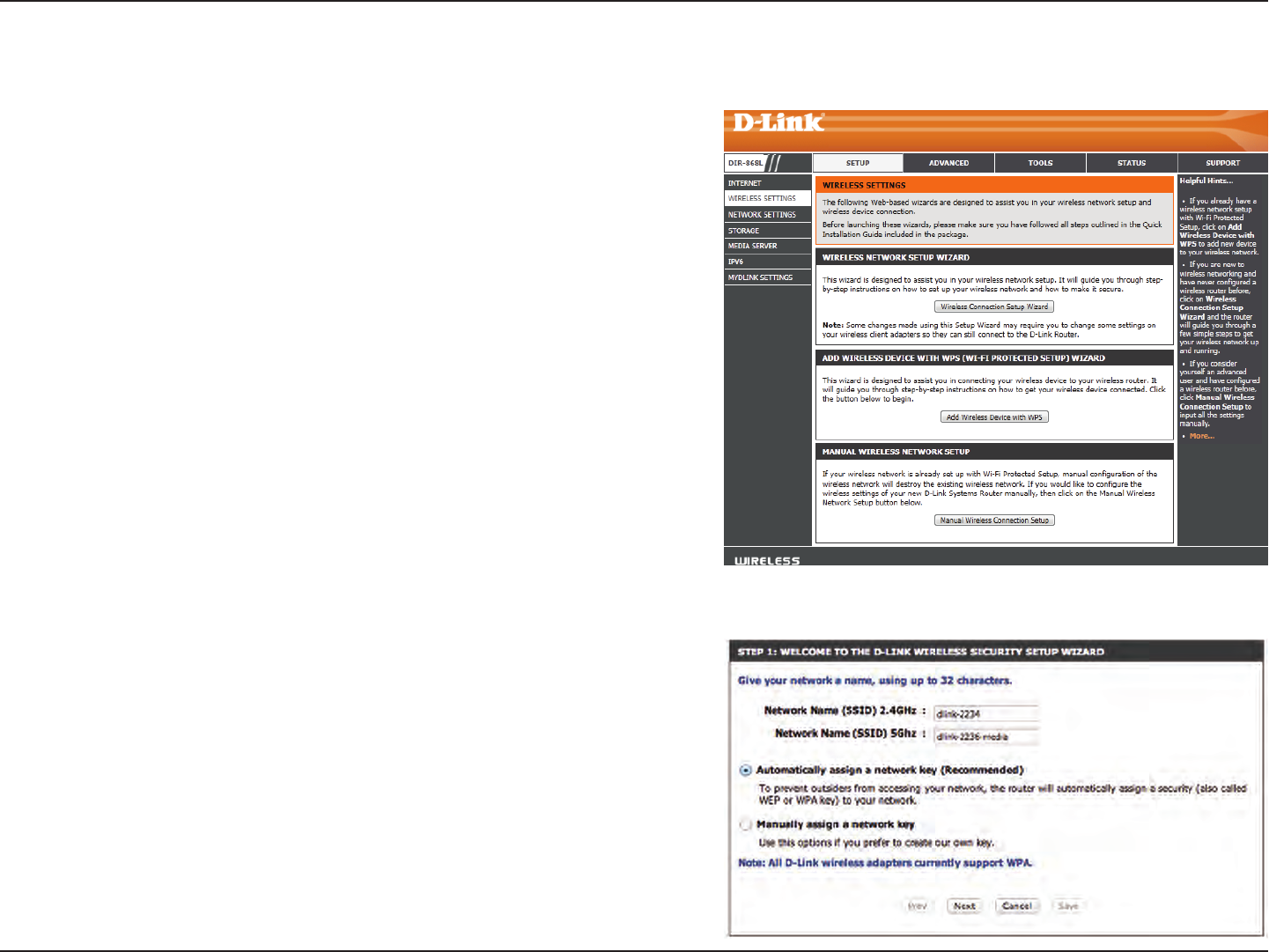
35D-Link DIR-868L User Manual
Section 4 - Security
Wireless Connection Setup Wizard
To run the security wizard, click on Setup at the top and then click Wireless
Connection Setup Wizard.
STEP 1: Type your desired wireless network names (SSIDs) for both the 2.4 GHz
band and the 5 GHz band.
Automatically: Select this option to automatically generate the router’s
network key and click Next.
Manually: Select this option to manually enter your network key and
click Next.
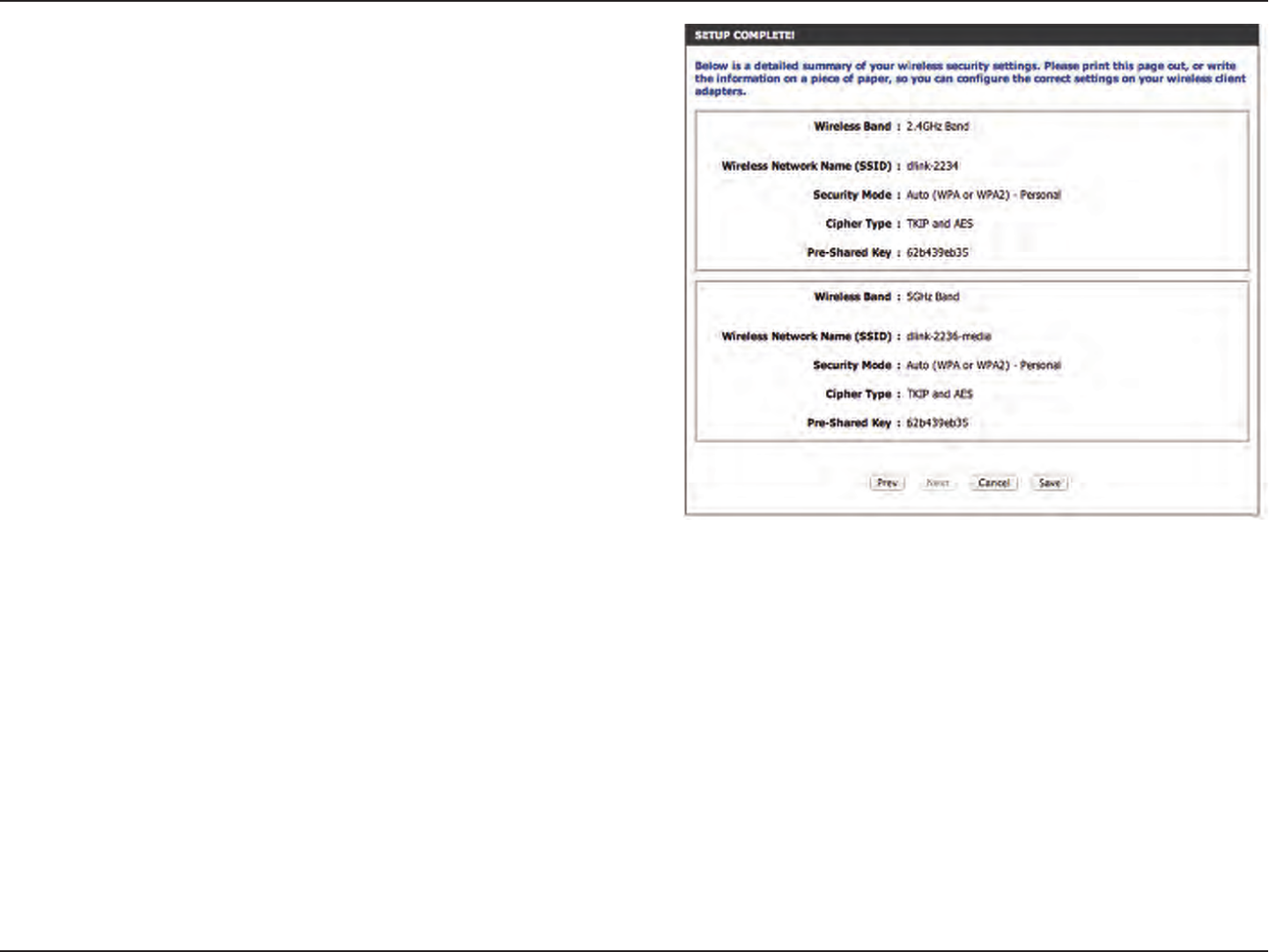
36D-Link DIR-868L User Manual
Section 4 - Security
If you selected Automatically, the option to make your password the same
on both bands with be oered. If you choose to make them the same, you
can select your own password in the box below.
Click Next.
You will now see a summary window that displays your settings. Write down
the security key and enter this on your wireless clients.
Click Save to save your settings.
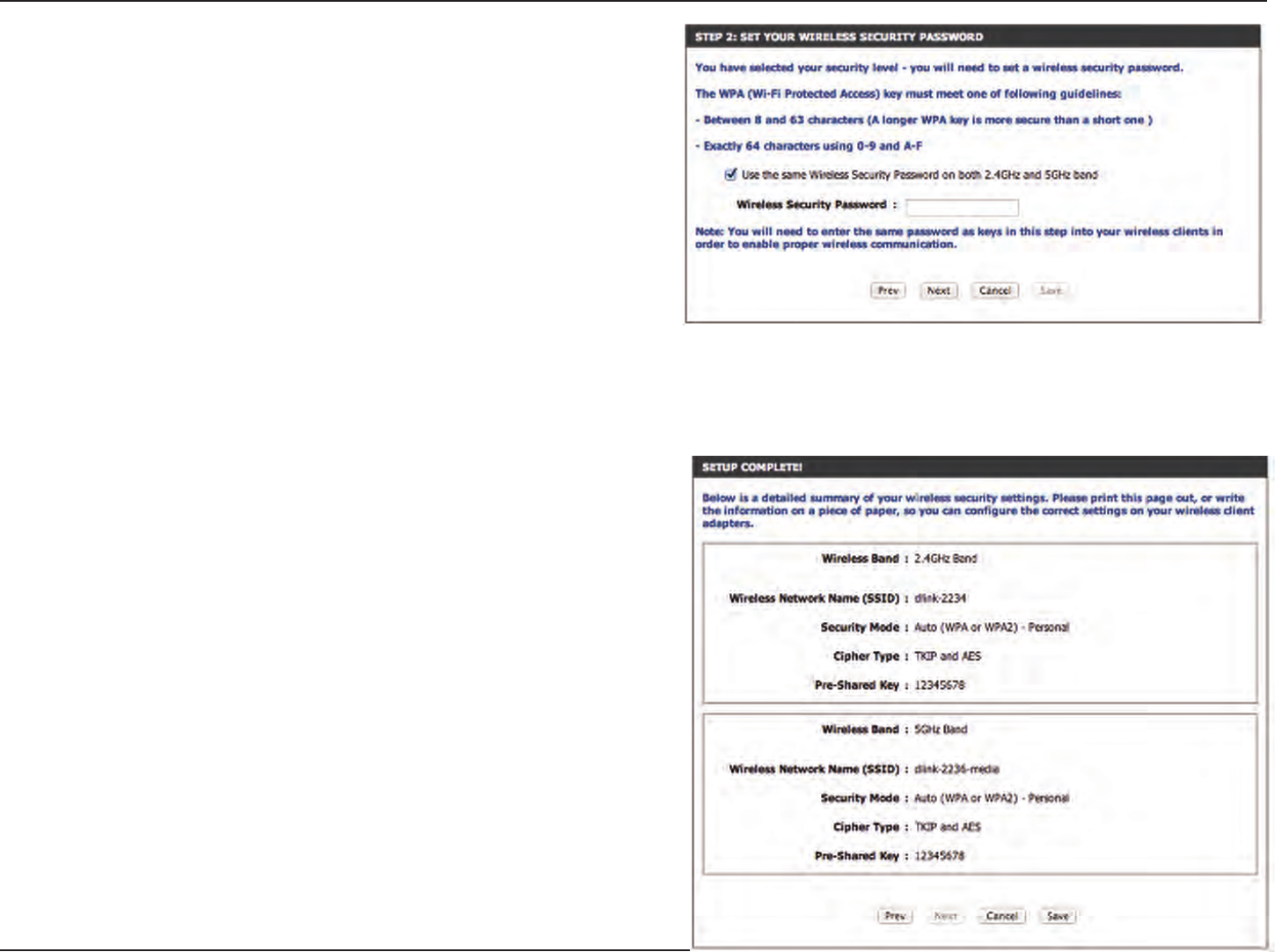
37D-Link DIR-868L User Manual
Section 4 - Security
If you selected Manually, the option to make your password the same on
both bands with be oered.
Enter your wireless password in the box below.
Click Next.
You will now see a summary window that displays your settings. Write down
the security key and enter this on your wireless clients.
Click Save to save your settings.
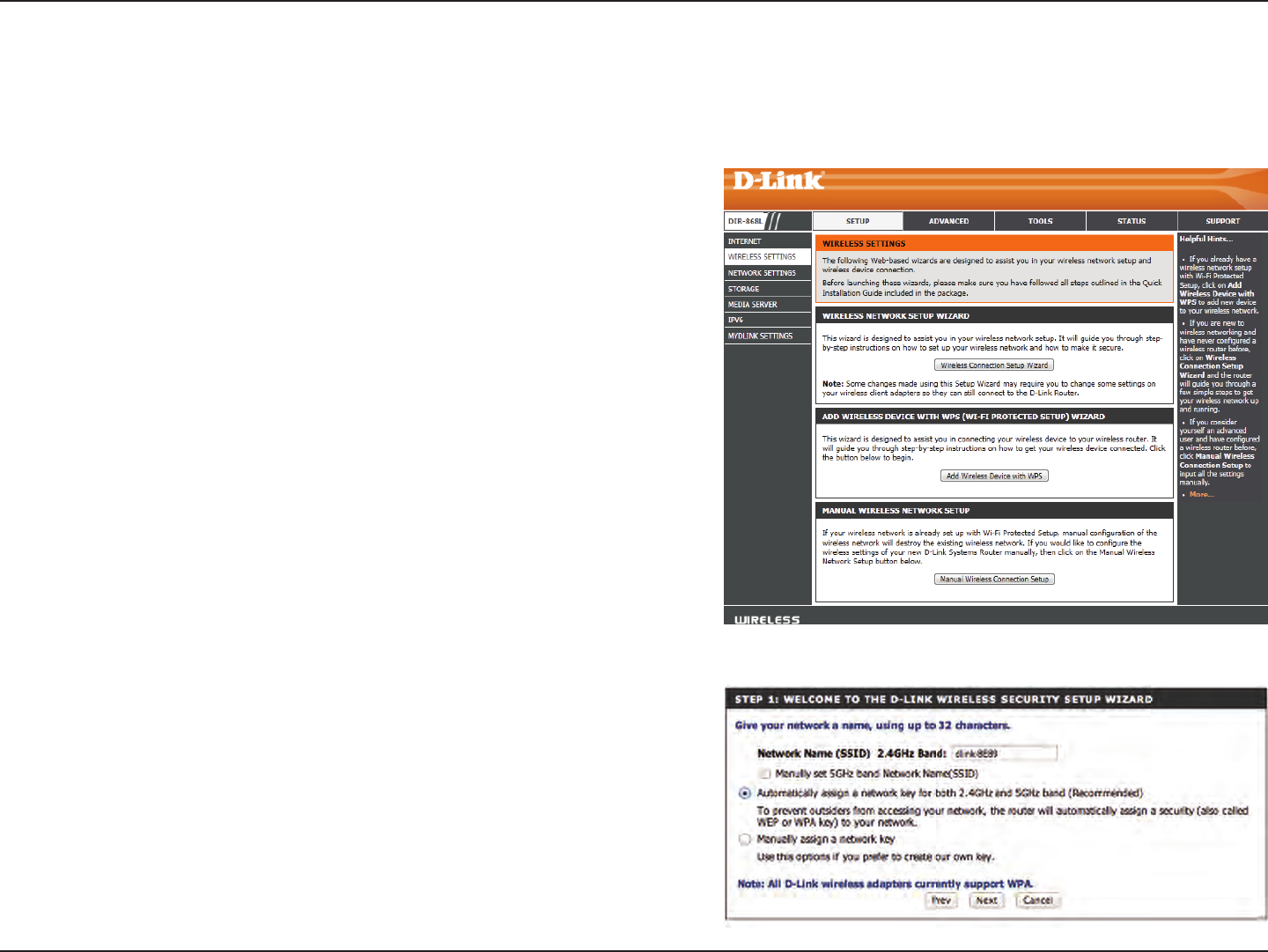
38D-Link DIR-868L User Manual
Section 4 - Security
Wireless Security Setup Wizard
To run the security wizard, click on Setup at the top and then click Wireless
Network Setup Wizard.
Type your desired wireless network name (SSID).
Automatically: Select this option to automatically generate the router’s
network key and click Next.
Manually: Select this option to manually enter your network key and
click Next.
If you are unfamiliar with the types of wireless security, more information is located in the appendix at back of this manual.
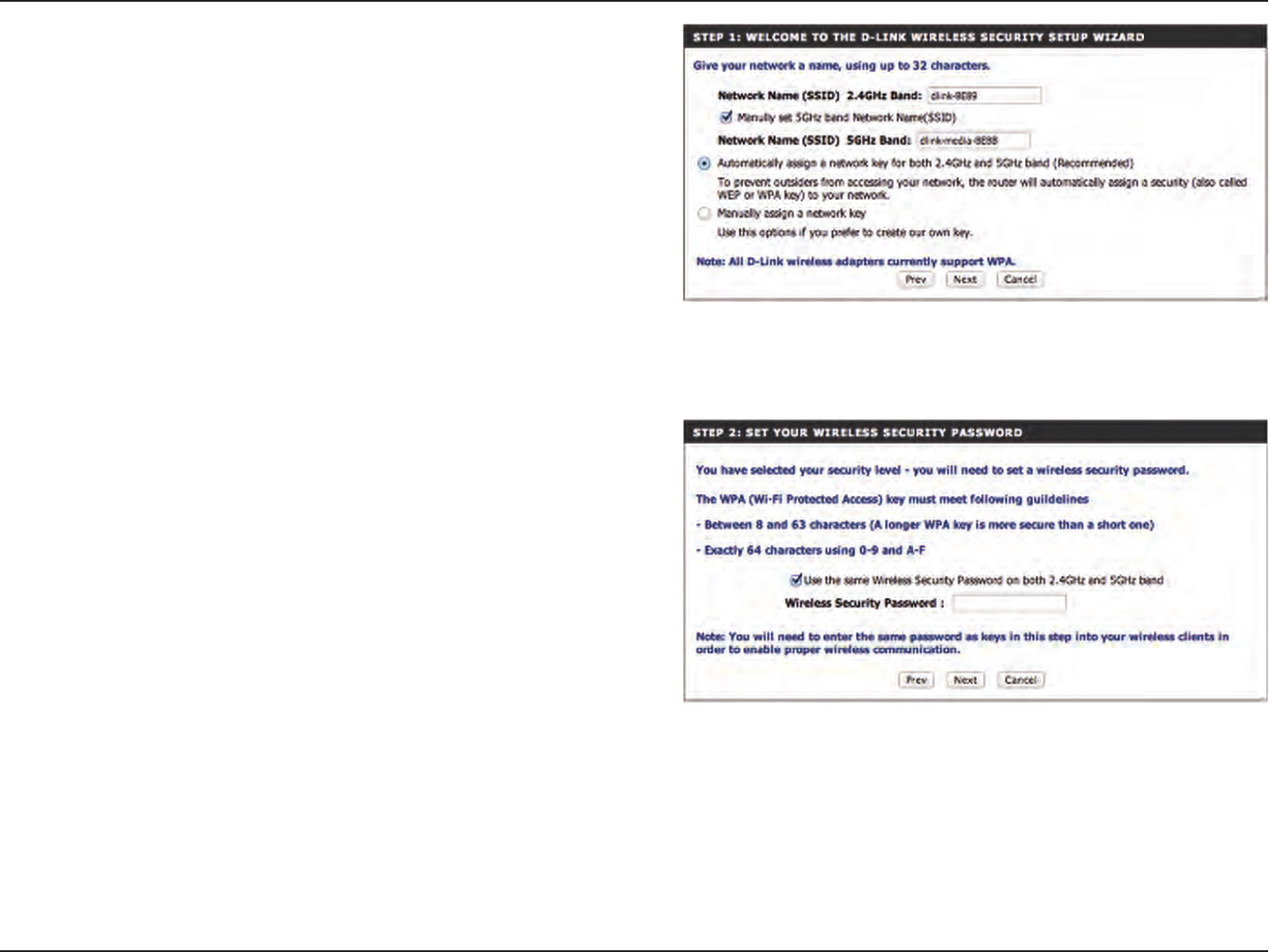
39D-Link DIR-868L User Manual
Section 4 - Security
If you selected Automatically, the summary window will display your
settings. Write down the security key and enter this on your wireless clients.
Click Save to save your settings.
If you selected Manually, the following screen will appear. Create a
passphrase for your security password. Click Next to continue.
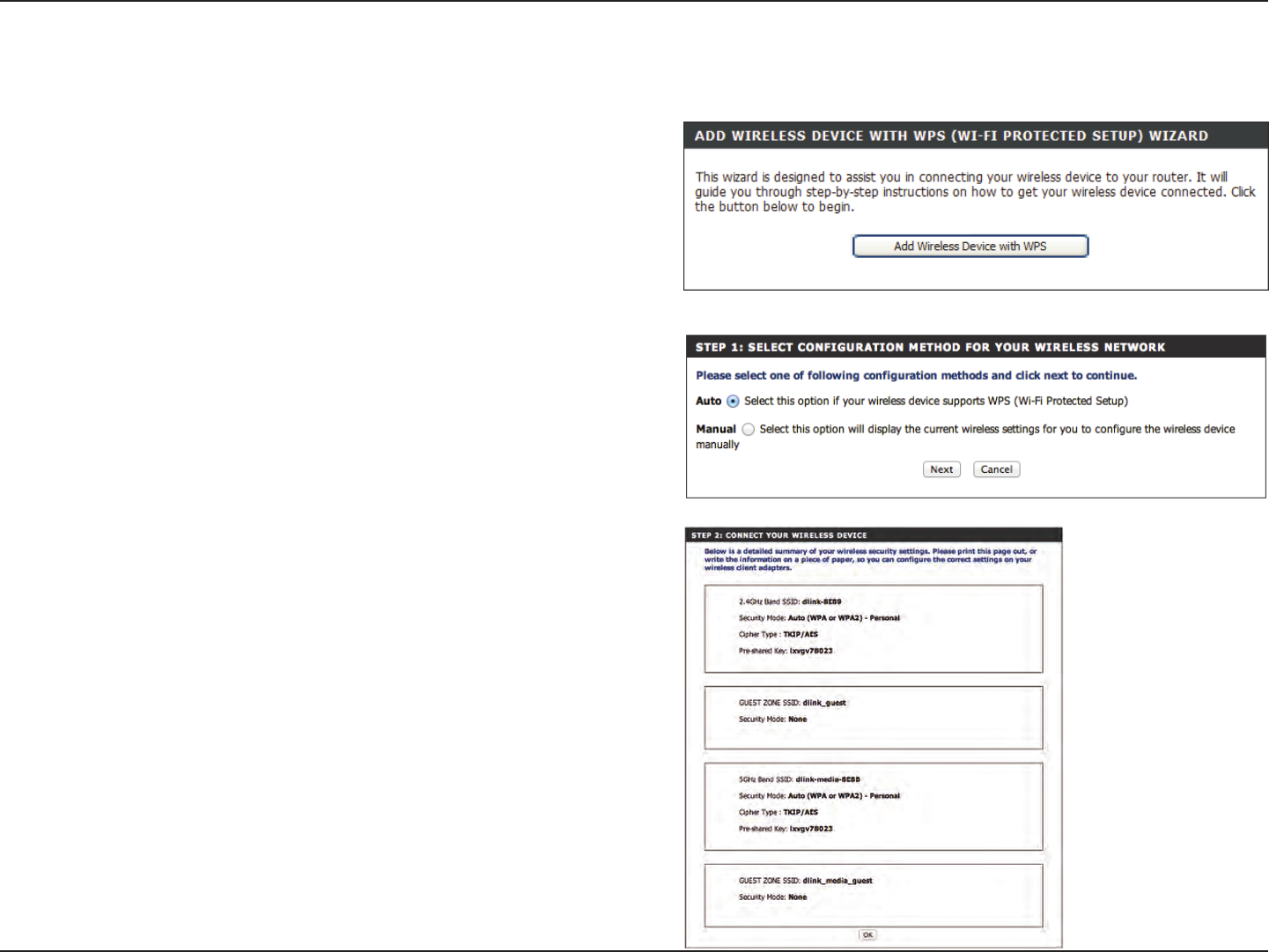
40D-Link DIR-868L User Manual
Section 4 - Security
From the Setup > Wireless Settings screen, click Add Wireless Device with
WPS.
Add Wireless Device with WPS Wizard
If you select Manual, a settings summary screen will appear. Write down the
security key and enter this on your wireless clients. Click OK to nish.
Select Auto to add a wireless client using WPS (Wi-Fi Protected Setup) and
then click Next. Skip to the next page.
If you are unfamiliar with the types of wireless security, more information is located in the appendix at back of this manual.
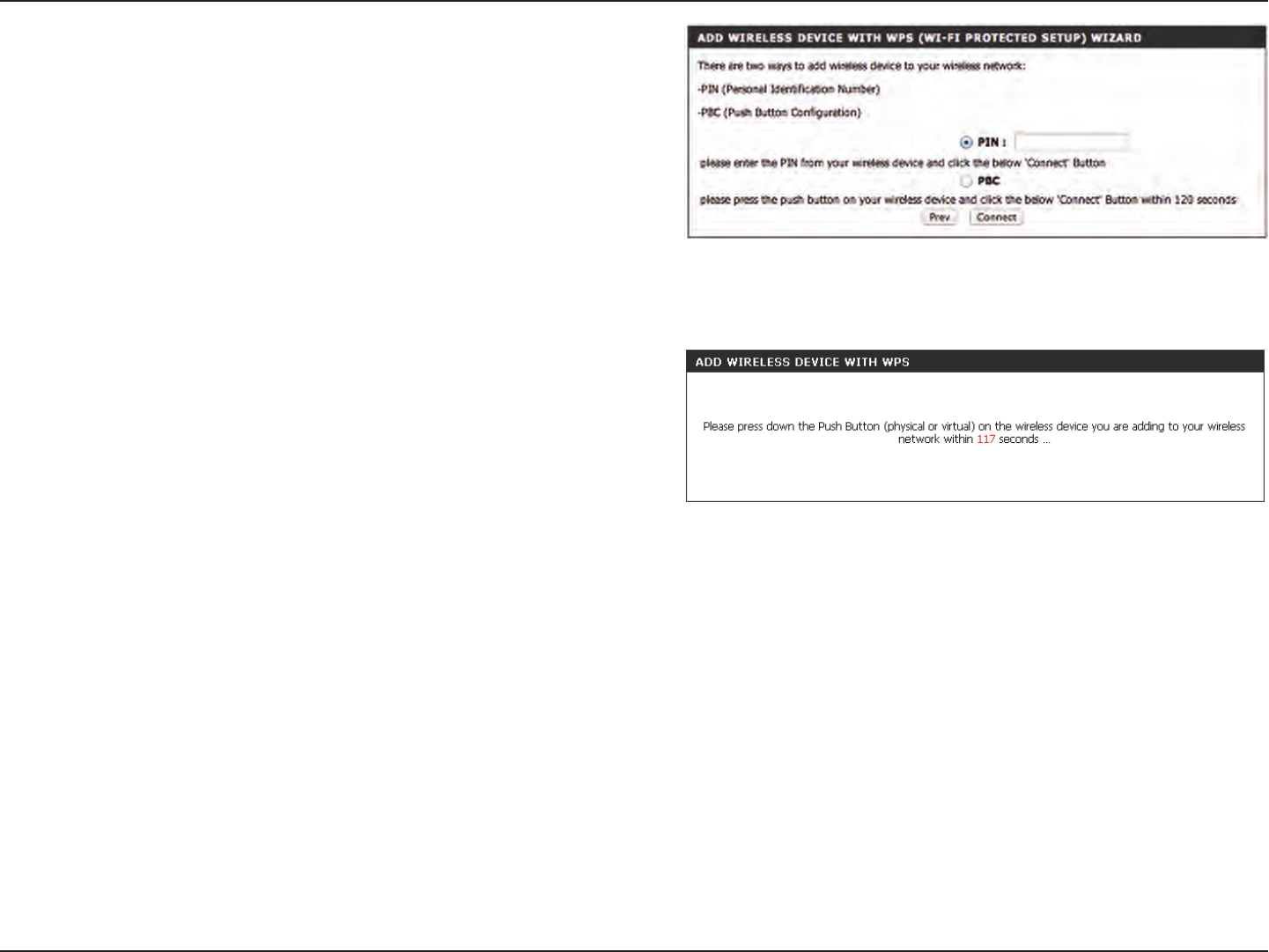
41D-Link DIR-868L User Manual
Section 4 - Security
PIN: Select this option to use PIN method. In order to use this method you
must know the wireless client’s 8 digit PIN and click Connect.
PBC: Select this option to use PBC (Push Button) method to add a wireless
client. Click Connect.
Once you click Connect, you will have a 120 second time limit to apply the
settings to your wireless client(s) and successfully establish a connection.
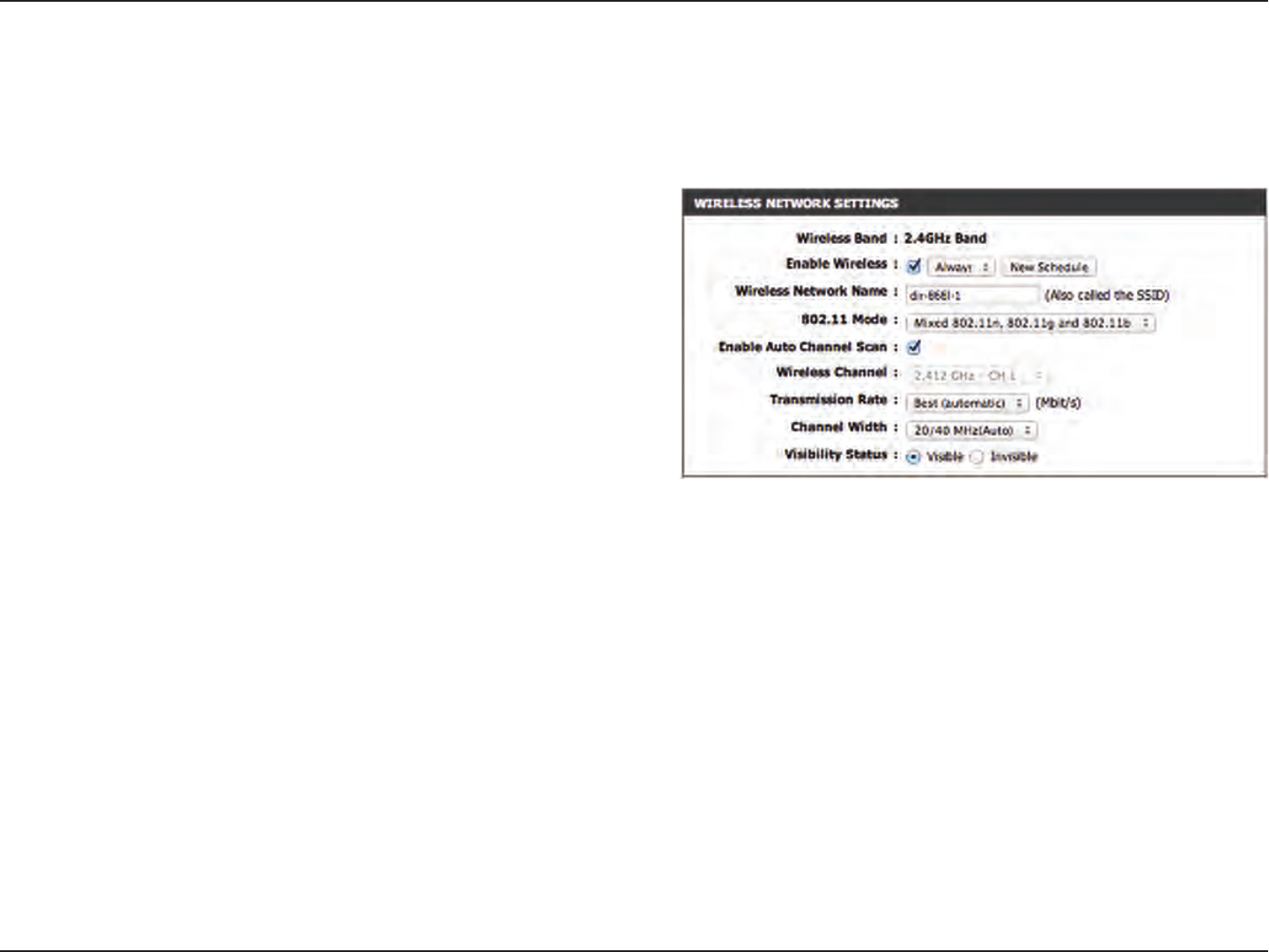
42D-Link DIR-868L User Manual
Section 3 - Conguration
Check the box to enable the wireless function. If you do not want to use
wireless, uncheck the box to disable all the wireless functions.
Select the time frame that you would like your wireless network enabled.
The schedule may be set to Always. Any schedule you create will be
available in the drop-down menu. Click New Schedule to create a
schedule.
Service Set Identier (SSID) is the name of your wireless network. Create
a name for your wireless network using up to 32 characters. The SSID is
case-sensitive.
Select one of the following:
802.11b Only - Select only if all of your wireless clients are 802.11b.
802.11g Only - Select only if all of your wireless clients are 802.11g.
802.11n Only - Select only if all of your wireless clients are 802.11n.
Mixed 802.11g and 802.11b - Select if you are using both 802.11g and 802.11b wireless clients.
Mixed 802.11n and 802.11g - Select if you are using both 802.11n and 802.11g wireless clients.
Mixed 802.11n, 11g, and 11b - Select if you are using a mix of 802.11n, 802.11g, and 802.11b wireless clients.
The Auto Channel Scan setting can be selected to allow the DIR-868L to choose the channel with the least amount of interference.
Indicates the channel setting for the DIR-868L. By default the channel is set to 6. The Channel can be changed to t the channel setting for an existing wireless
network or to customize the wireless network. If you enable Auto Channel Scan, this option will be greyed out.
Select the Channel Width:
Auto 20/40 - This is the default setting. Select if you are using both 802.11n and non-802.11n wireless devices.
20MHz - Select if you are not using any 802.11n wireless clients.
Select Invisible if you do not want the SSID of your wireless network to be broadcasted by the DIR-868L. If Invisible is selected, the SSID of the DIR-868L will
not be seen by Site Survey utilities so your wireless clients will have to know the SSID of your DIR-868L in order to connect to it.
Refer to the appendix in the back of the manual for more information regarding wireless security.
Enable Wireless:
Schedule:
Wireless Network
Name:
802.11 Mode:
Enable Auto Channel
Scan:
Wireless Channel:
Manual Wireless Settings
Channel Width:
Visibility Status:
Wireless Security:
802.11 b/g/n (2.4GHz)
If you are unfamiliar with the types of wireless security, more information is located in the appendix at back of this manual.
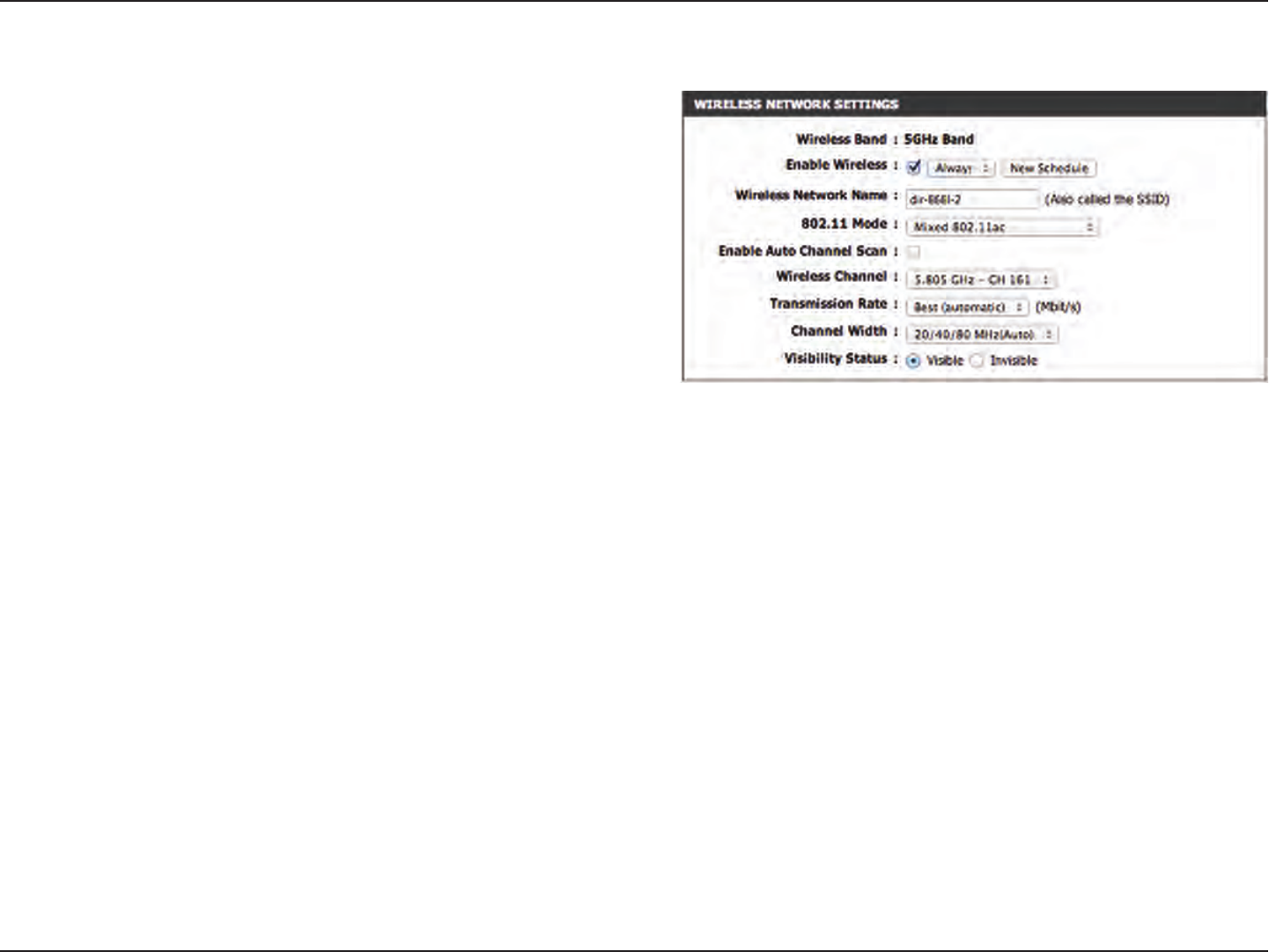
43D-Link DIR-868L User Manual
Section 3 - Conguration
802.11ac draft (5GHz)
Check the box to enable the wireless function. If you do not want to use
wireless, uncheck the box to disable all the wireless functions.
Select the time frame that you would like your wireless network enabled.
The schedule may be set to Always. Any schedule you create will be
available in the drop-down menu. Click New Schedule to create a
schedule.
Service Set Identier (SSID) is the name of your wireless network. Create
a name for your wireless network using up to 32 characters. The SSID is
case-sensitive.
Select one of the following:
802.11n Only - Select only if all of your wireless clients are 802.11n.
802.11ac Only - Select if all of your wireless clients are 802.11ac.
Mixed 802.11n and 802.11a - Select if you are using both 802.11n and 802.11a wireless clients.
Mixed 802.11ac and 802.11n - Select if you are using both 802.11ac and 802.11n wireless clients.
Mixed 802.11ac and 802.11a - Select if you are using both 802.11ac and 802.11a wireless clients.
The Auto Channel Scan setting can be selected to allow the DIR-868L to choose the channel with the least amount of interference.
Indicates the channel setting for the DIR-868L. By default the channel is set to 6. The Channel can be changed to t the channel setting for an existing wireless
network or to customize the wireless network. If you enable Auto Channel Scan, this option will be greyed out.
Select the Channel Width:
Auto 20/40/80 - Select if you are using both 802.11ac, 802.11n and non-802.11n wireless devices.
Auto 20/40 - This is the default setting. Select if you are using both 802.11n and non-802.11n wireless devices.
20MHz - Select if you are not using any 802.11n wireless clients.
Select Invisible if you do not want the SSID of your wireless network to be broadcasted by the DIR-868L. If Invisible is selected, the SSID of the DIR-868L will
not be seen by Site Survey utilities so your wireless clients will have to know the SSID of your DIR-868L in order to connect to it.
Refer to the next page for more information regarding wireless security.
Enable Wireless:
Schedule:
Wireless Network
Name:
802.11 Mode:
Enable Auto Channel
Scan:
Wireless Channel:
Channel Width:
Visibility Status:
Wireless Security:
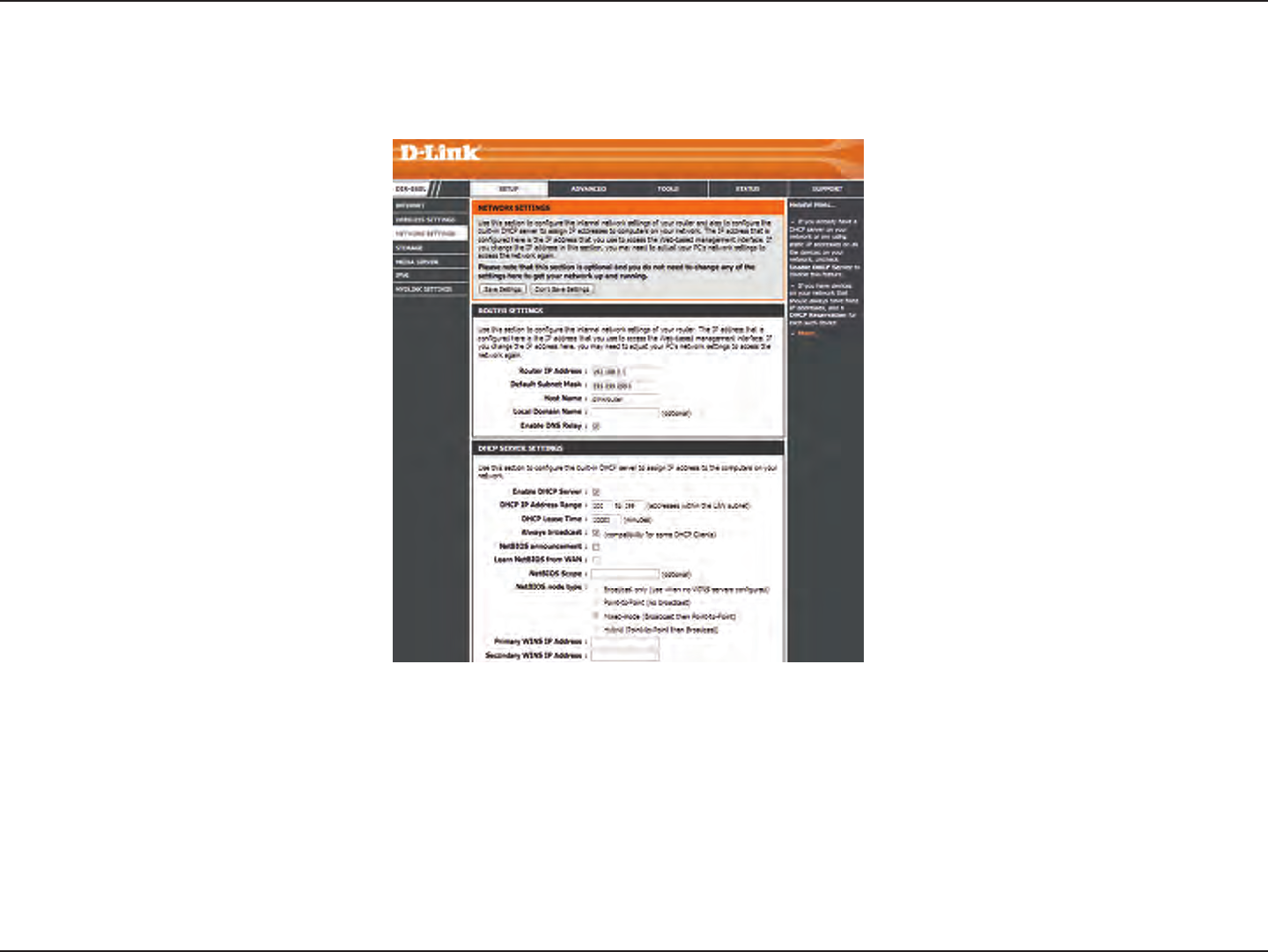
44D-Link DIR-868L User Manual
Section 3 - Conguration
This section will allow you to change the local network settings of the router and to congure the DHCP settings.
Network Settings
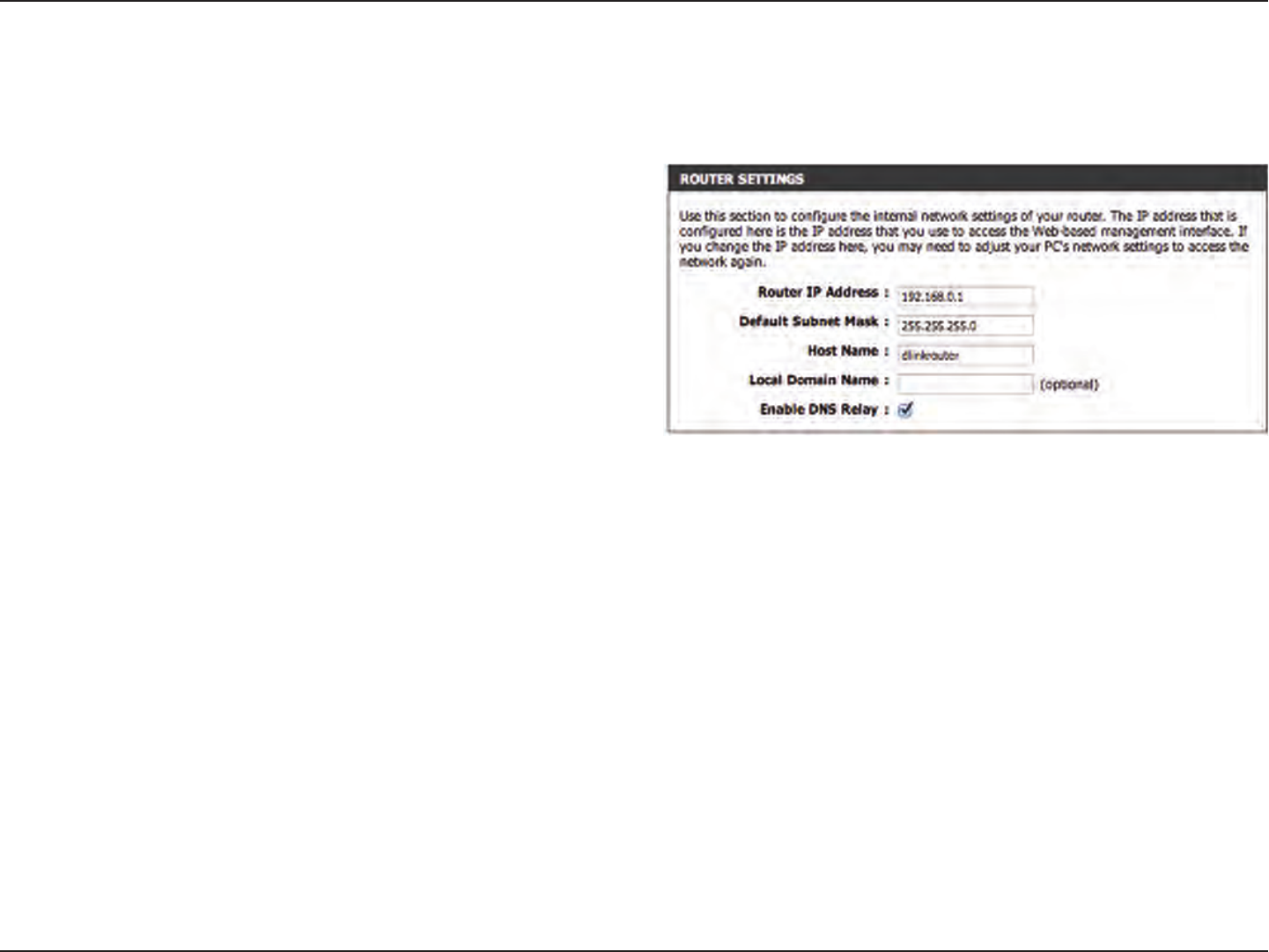
45D-Link DIR-868L User Manual
Section 3 - Conguration
This section will allow you to congure the router settings.
Router Settings
Enter the IP address of the router. The default IP address
is 192.168.0.1.
If you change the IP address, once you click Save Settings,
you will need to enter the new IP address in your browser
to get back into the conguration utility.
Enter the Subnet Mask. The default subnet mask is
255.255.255.0.
Enter a name for the router.
Enter the Domain name (Optional).
Uncheck the box to transfer the DNS server information
from your ISP to your computers. If checked, your
computers will use the router for a DNS server.
Router IP Address:
Subnet Mask:
Device Name:
Local Domain:
Enable DNS Relay:
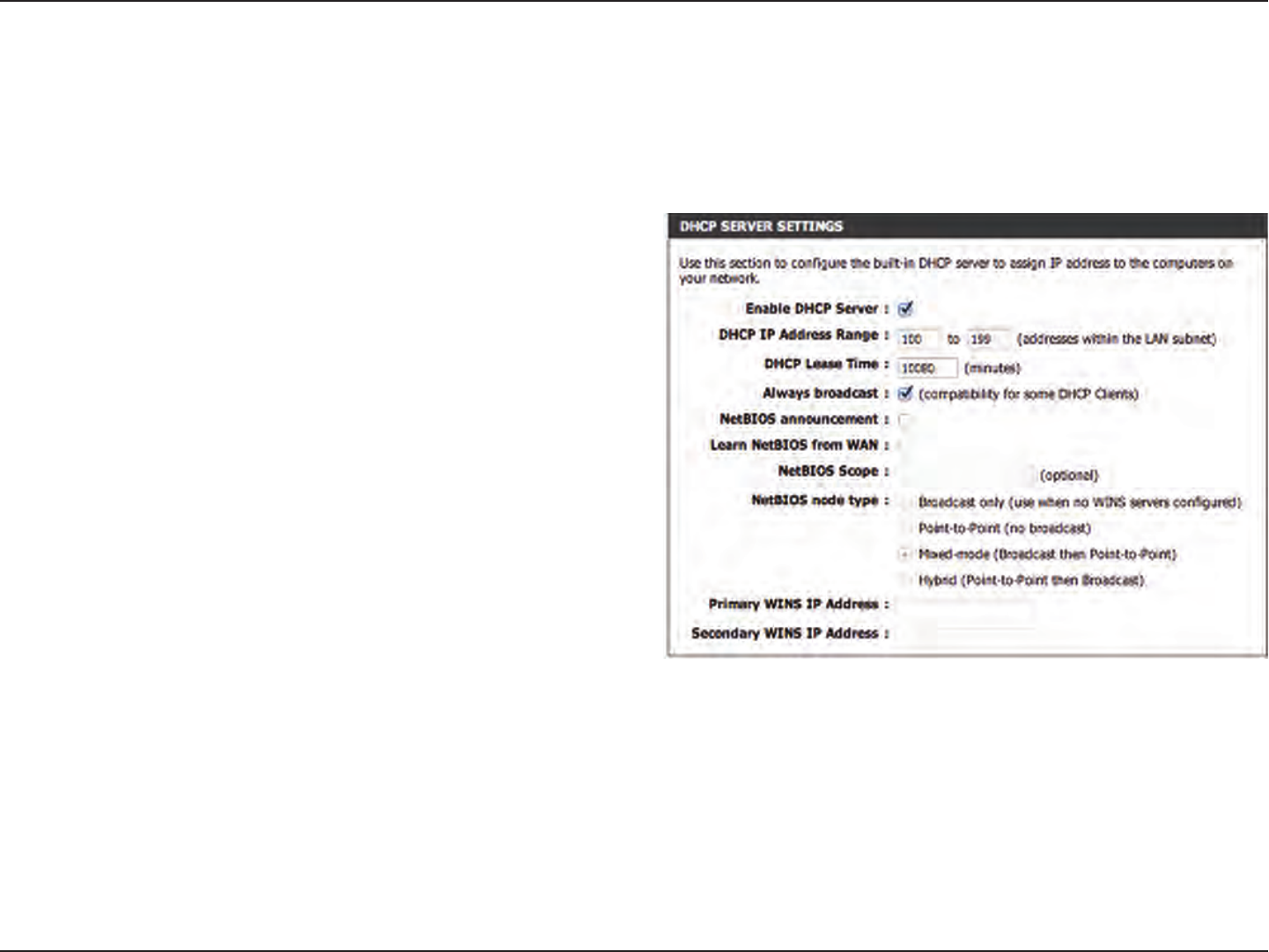
46D-Link DIR-868L User Manual
Section 3 - Conguration
DHCP Server Settings
DHCP stands for Dynamic Host Control Protocol. The DIR-868L has a built-in DHCP server. The DHCP Server will automatically assign an IP address
to the computers on the LAN/private network. Be sure to set your computers to be DHCP clients by setting their TCP/IP settings to “Obtain an IP
Address Automatically.” When you turn your computers on, they will automatically load the proper TCP/IP settings provided by the DIR-868L. The
DHCP Server will automatically allocate an unused IP address from the IP address pool to the requesting computer. You must specify the starting
and ending address of the IP address pool.
Check this box to enable the DHCP server on your router.
Uncheck to disable this function.
Enter the starting and ending IP addresses for the DHCP
server’s IP assignment.
Note: If you statically (manually) assign IP addresses to your
computers or devices, make sure the IP addresses are outside
of this range or you may have an IP conict.
The length of time for the IP address lease. Enter the Lease
time in minutes.
Enable this feature to broadcast your networks DHCP server
to LAN/WLAN clients.
NetBIOS allows LAN hosts to discover all other computers
within the network, enable this feature to allow the DHCP
Server to oer NetBIOS conguration settings.
Enable this feature to allow WINS information to be learned from the WAN side, disable to allow manual conguration.
This feature allows the conguration of a NetBIOS ‘domain’ name under which network hosts operates. This setting has no eect
if the ‘Learn NetBIOS information from WAN’ is activated.
Select the dierent type of NetBIOS node; Broadcast only, Point-to-Point, Mixed-mode, and Hybrid.
Enter your WINS Server IP address(es).
Enable DHCP
Server:
DHCP IP Address
Range:
DHCP Lease Time:
Always
Broadcast:
NetBIOS
Announcement:
Learn NetBIOS
from WAN:
NetBIOS Scope:
NetBIOS Node:
WINS IP Address:
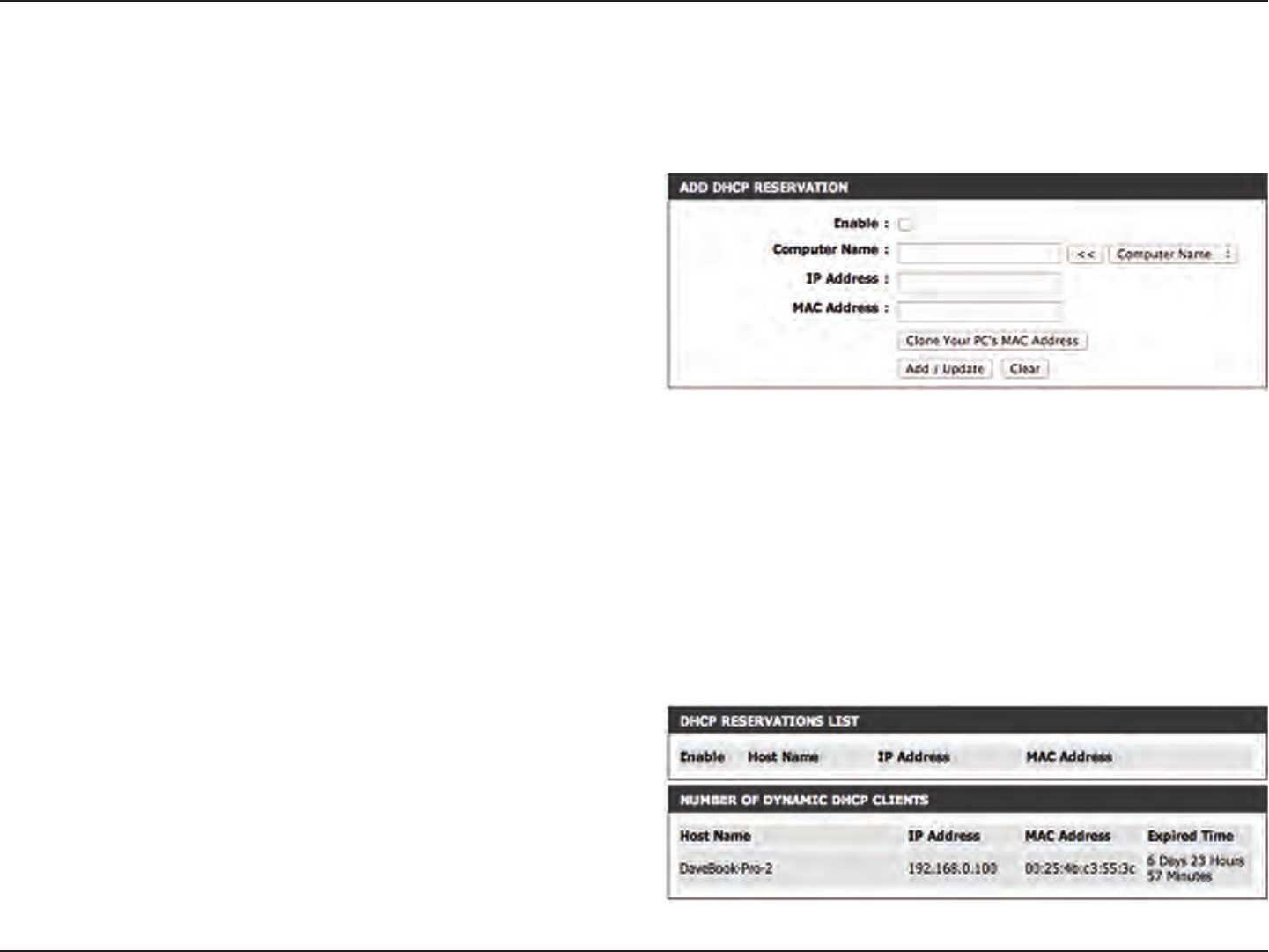
47D-Link DIR-868L User Manual
Section 3 - Conguration
DHCP Reservation
If you want a computer or device to always have the same IP address assigned, you can create a DHCP reservation. The router will assign the IP
address only to that computer or device.
Note: This IP address must be within the DHCP IP Address Range.
Check this box to enable the reservation.
Enter the computer name or select from the drop-down
menu and click <<.
Enter the IP address you want to assign to the computer
or device. This IP Address must be within the DHCP IP
Address Range.
Enter the MAC address of the computer or device.
If you want to assign an IP address to the computer you
are currently on, click this button to populate the elds.
Click Save to save your entry. You must click Save Settings
at the top to activate your reservations.
Displays any reservation entries. Displays the host name
(name of your computer or device), MAC Address, and IP
address.
Check to enable the reservation.
Click the edit icon to make changes to the reservation entry.
Click to remove the reservation from the list.
Enable:
Computer Name:
IP Address:
MAC Address:
Copy Your PC’s
MAC Address:
Save:
DHCP
Reservations List:
Enable:
Edit:
Delete:
DHCP Reservations List
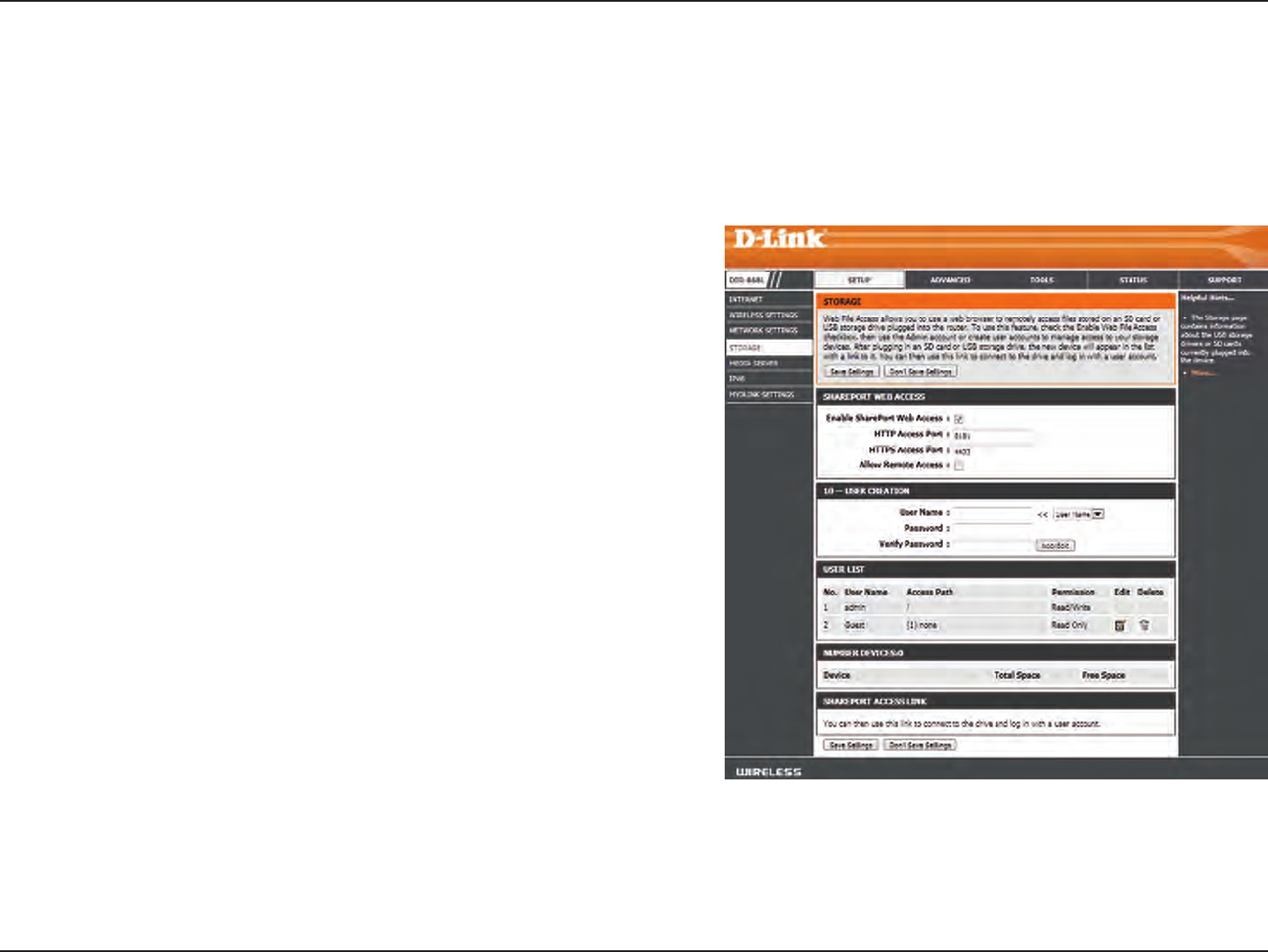
48D-Link DIR-868L User Manual
Section 3 - Conguration
Storage
This page will allow you to set up access to les on an external USB hard drive1 or thumb drive that is plugged into the router. You can do this
through local network or from the Internet using either a web browser or an app on your smartphone or tablet. You can create users that can be
allowed access to these les through SharePort Mobile services accessible through a web UI or on mobile devices using the SharePort Mobile app
available for iOS and Android.
1 Supports capacities of up to 1TB for USB storage drives.
Check this box if you wish to be able to access SharePort through
a browser as well as the mobile app.
Enter the port you want to use when accessing SharePort using
a web browser.
Enter the port you want to use when accessing SharePort through
a secure connection using a web browser.
Check this box if you wish to be able to access SharePort through
a web browser over the Internet.
To give a new user access to your SharePort storage, enter a User
Name and Password here. You can Add new users or choose
existing users from the drop-down menu if you wish to Edit or
Delete them.
Note: The Admin password is the same as the admin password for
the router. The Guest password is “guest” and cannot be changed.
This list displays all of the users with access to the SharePort Mobile
content, what they can access, and their Read/Write Permissions.
All devices you have set up for SharePort access will be listed here.
This area will display the HTTP and HTTPS links to connect to your SharePort drive through a web browser from a device on
your network.
Enable SharePort
Web Access
HTTP Access Port:
HTTPS Access Port:
Allow Remote
Access:
User Creation:
User List:
Number of Devices:
SharePort Web
Access Link:
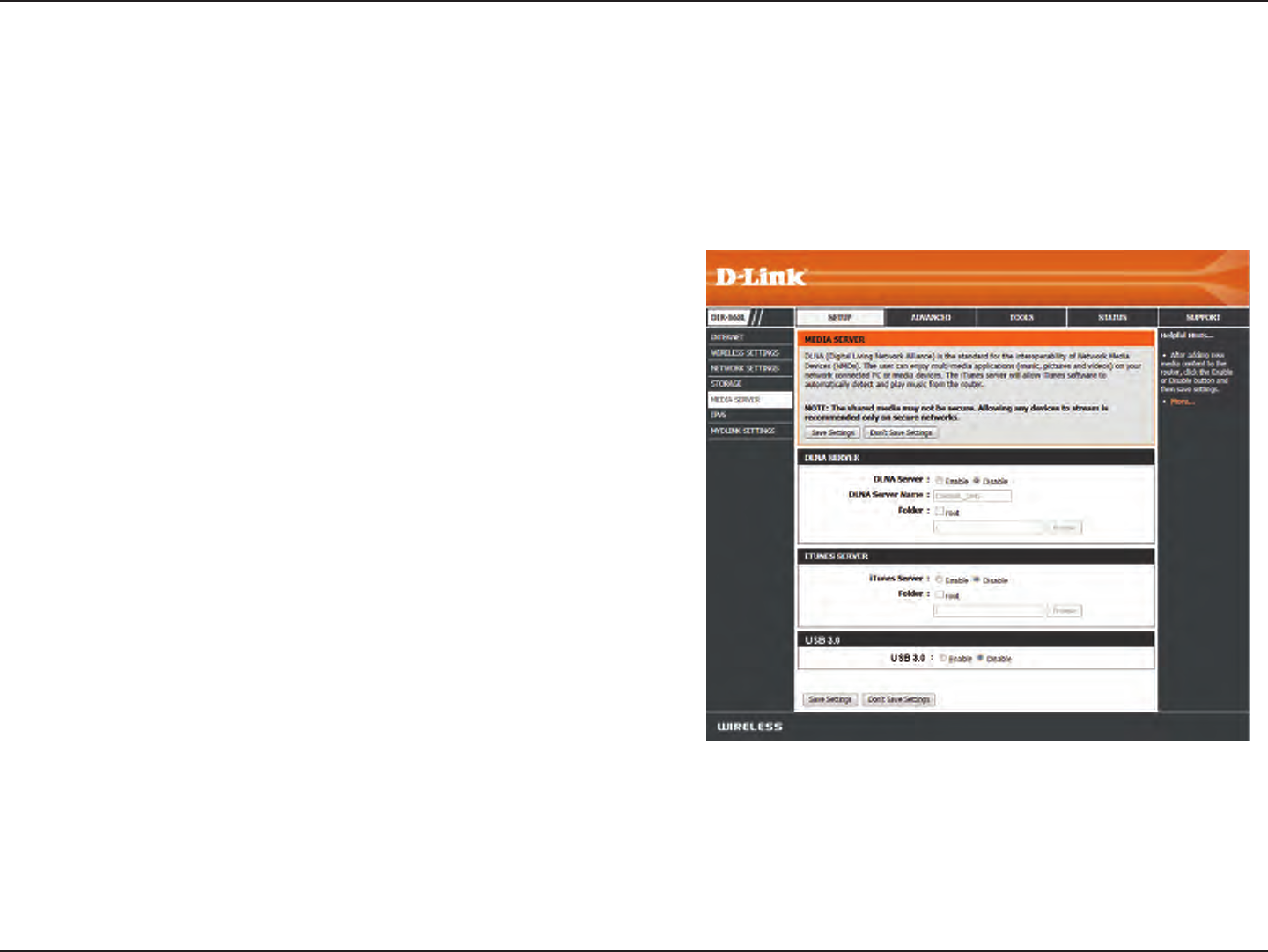
49D-Link DIR-868L User Manual
Section 3 - Conguration
Media Server
This page will allow you to enable a DLNA Media Server. DLNA (Digital Living Network Alliance) is the standard for the interoperability of Network
Media Devices (NMDs). The user can enjoy multimedia applications (music, pictures and videos) on your network connected PC or media devices.
If you agree to share media with devices, any computer or device that connects to your network can play your shared music, pictures and videos.
Note: The shared media may not be secure. Allowing any devices to stream is recommended only on secure networks.
Check to enable DLNA Media Server functions.
Choose a name for your DLNA media server so that it can be
found.
Choose the location of the folder you wish to share or check the
box to use the root folder of the entire drive.
Check to enable iTunes Server functions.
Choose the location of the iTunes Library folder you wish to share
or check the box to use the root folder if it is located on the root
folder of the connected drive.
Use this setting to enable USB 3.0 functionality for the USB port
on the back of the router. USB 3.0 provides high-speed transfer
speeds with compatible devices. This setting is disabled by
default, which means that the USB port will operate at the USB
2.0 specication.
DLNA Server:
DLNA Server
Name:
Folder:
iTunes Server:
Folder:
USB 3.0:
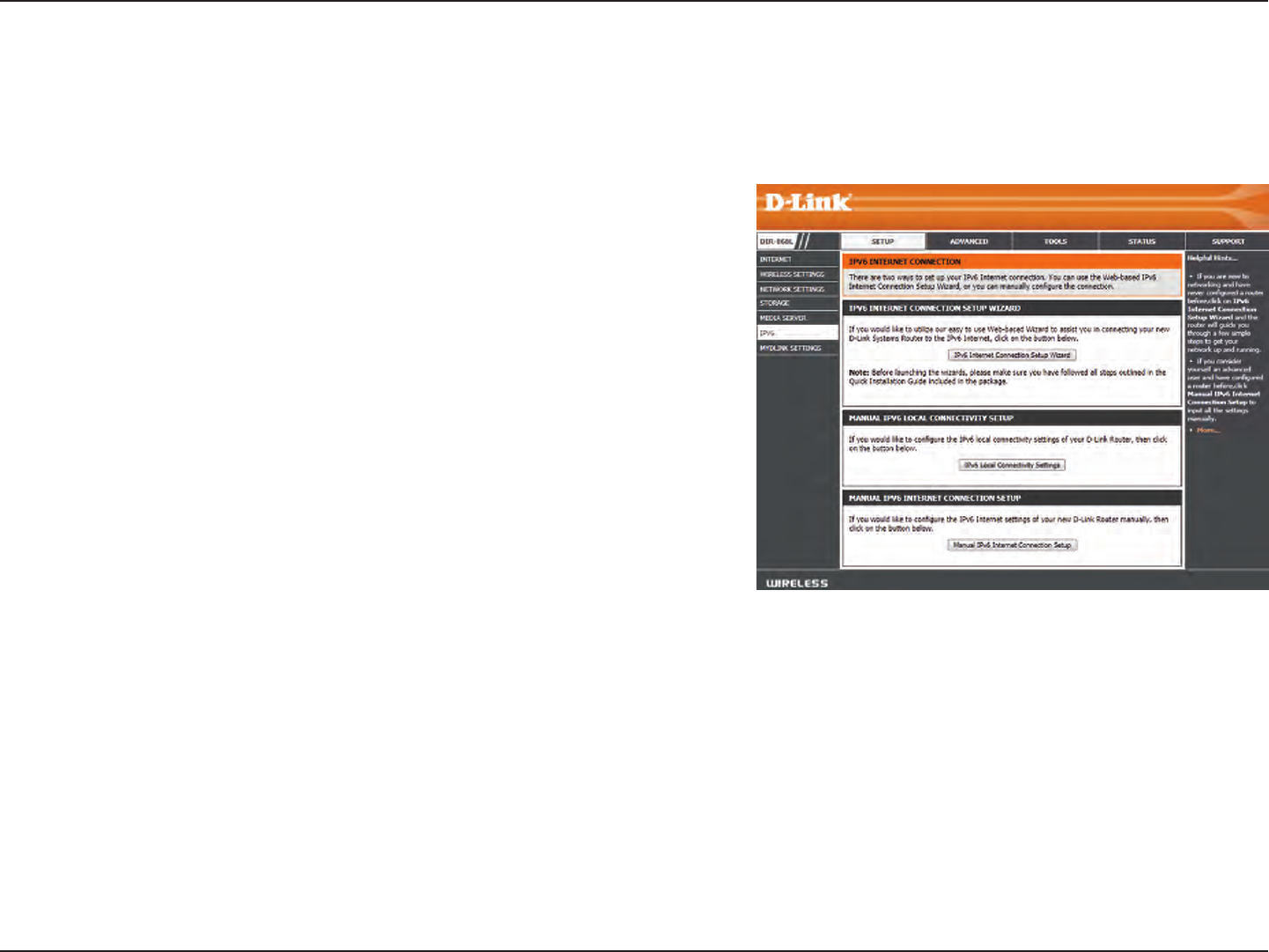
50D-Link DIR-868L User Manual
Section 3 - Conguration
IPv6
On this page, you can congure the IPv6 Connection type. There are two ways to set up the IPv6 Internet connection. You can use the Web-based
IPv6 Internet Connection Setup Wizard, or you can manually congure the connection.
If you are a beginner that has not congured a router before, click on the IPv6 Internet
Connection Setup Wizard button and the router will guide you through a few simple
steps to get your network up and running.
If you are an advanced user that has congured a router before, click on the Manual
IPv6 Internet Connection Setup button to input all the settings manually.
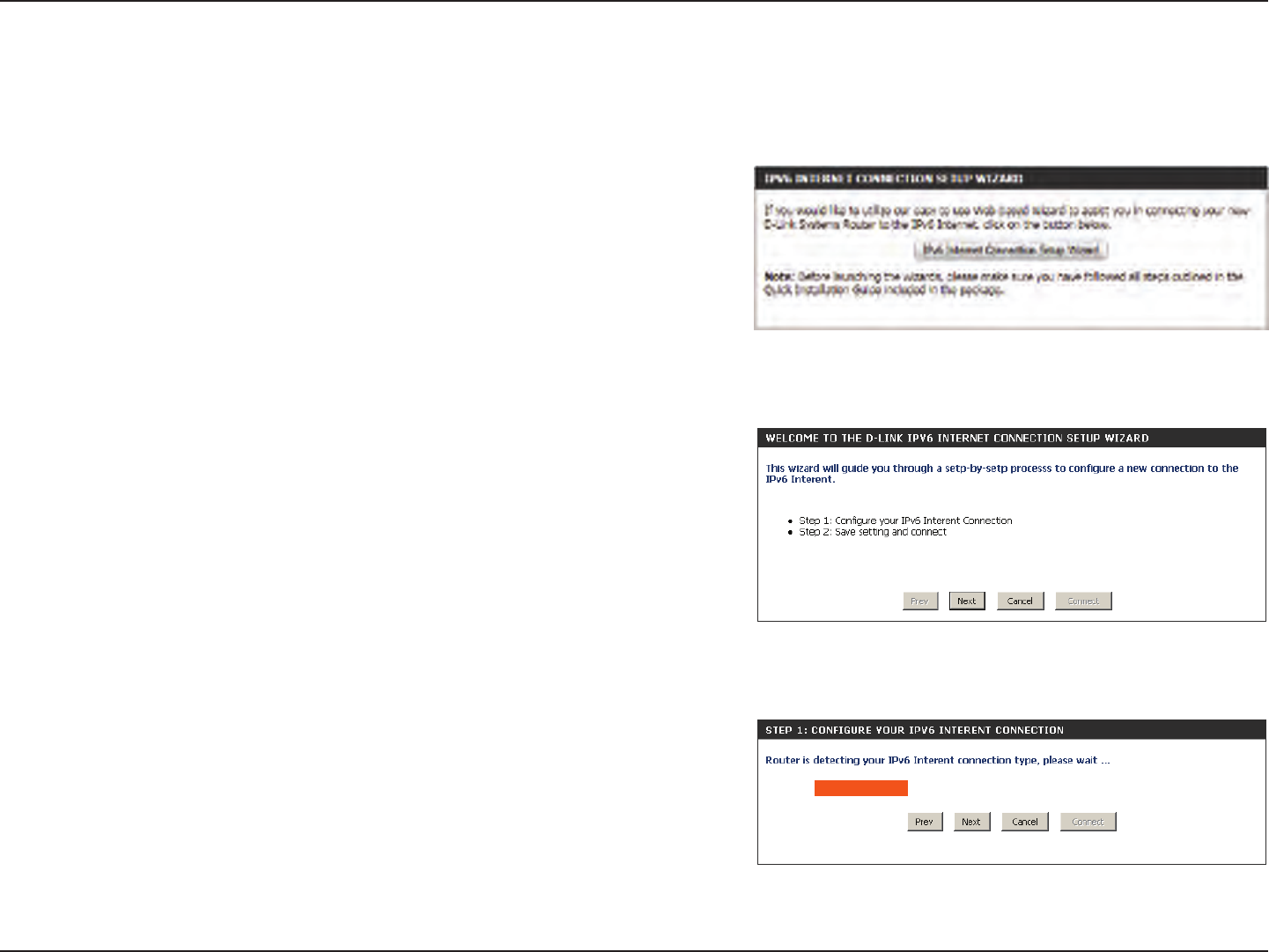
51D-Link DIR-868L User Manual
Section 3 - Conguration
IPv6 Internet Connection Setup Wizard
On this page, the user can congure the IPv6 Connection type using the IPv6 Internet Connection Setup Wizard.
Click the IPv6 Internet Connection Setup Wizard button and the router will guide
you through a few simple steps to get your network up and running.
Click Next to continue to the next page. Click Cancel to discard the changes made
and return to the main page.
The router will try to detect whether its possible to obtain the IPv6 Internet
connection type automatically. If this succeeds then the user will be guided through
the input of the appropriate parameters for the connection type found.
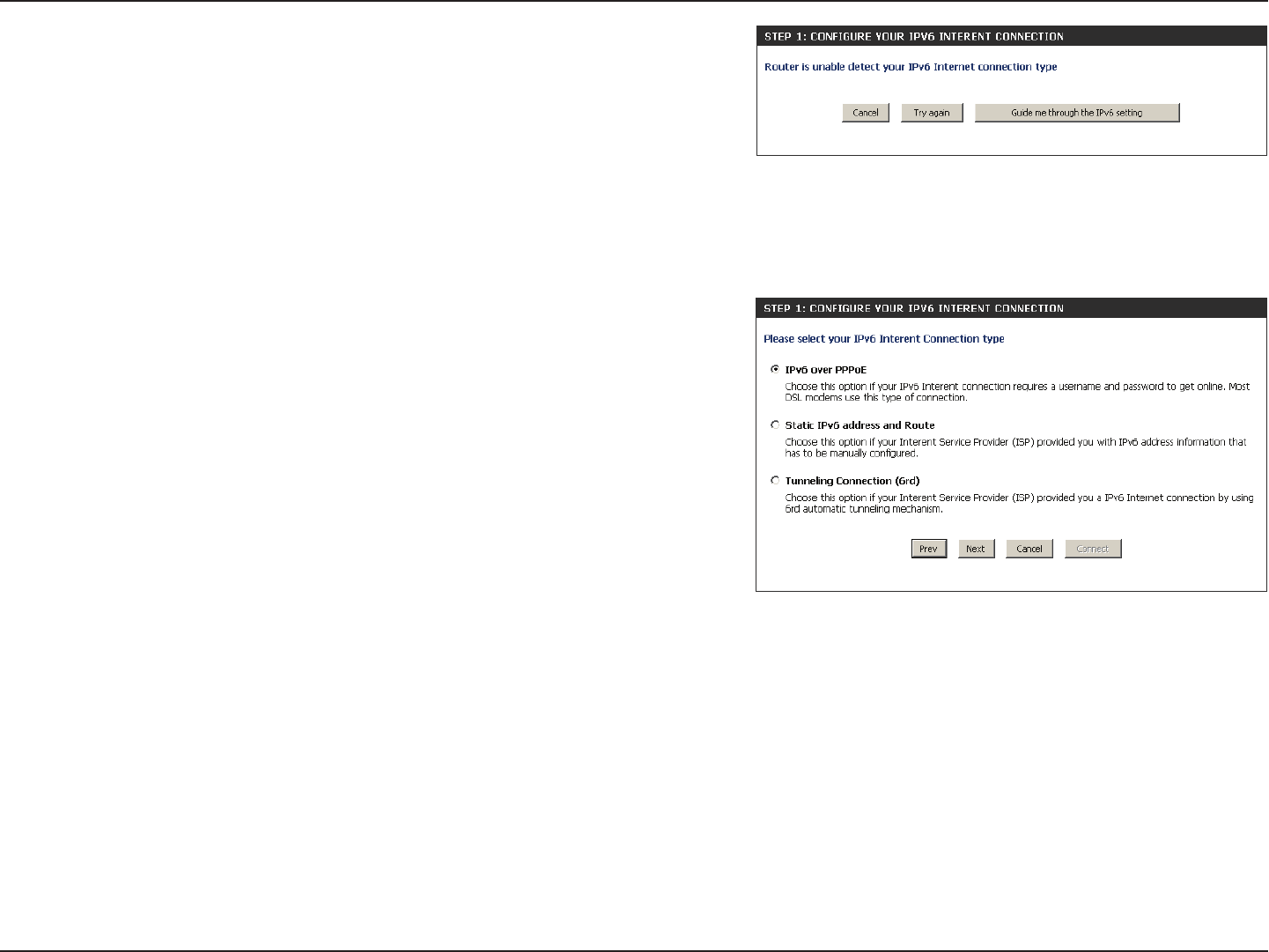
52D-Link DIR-868L User Manual
Section 3 - Conguration
However, if the automatic detection fails, the user will be prompt to either Try
again or to click on the Guide me through the IPv6 settings button to initiate the
manual continual of the wizard.
There are several connection types to choose from. If you are unsure of your
connection method, please contact your IPv6 Internet Service Provider.
Note: If using the PPPoE option, you will need to ensure that any PPPoE client
software on your computers has been removed or disabled. The 3 options available
on this page are IPv6 over PPPoE, Static IPv6 address and Route, and Tunneling
Connection.
Choose the required IPv6 Internet Connection type and click on the Next button
to continue. Click on the Prev button to return to the previous page. Click on the
Cancel button to discard all the changes made and return to the main page.
Click on the Next button to continue. Click on the Prev button to return to the previous page.
Click on the Cancel button to discard all the changes made and return to the main page.
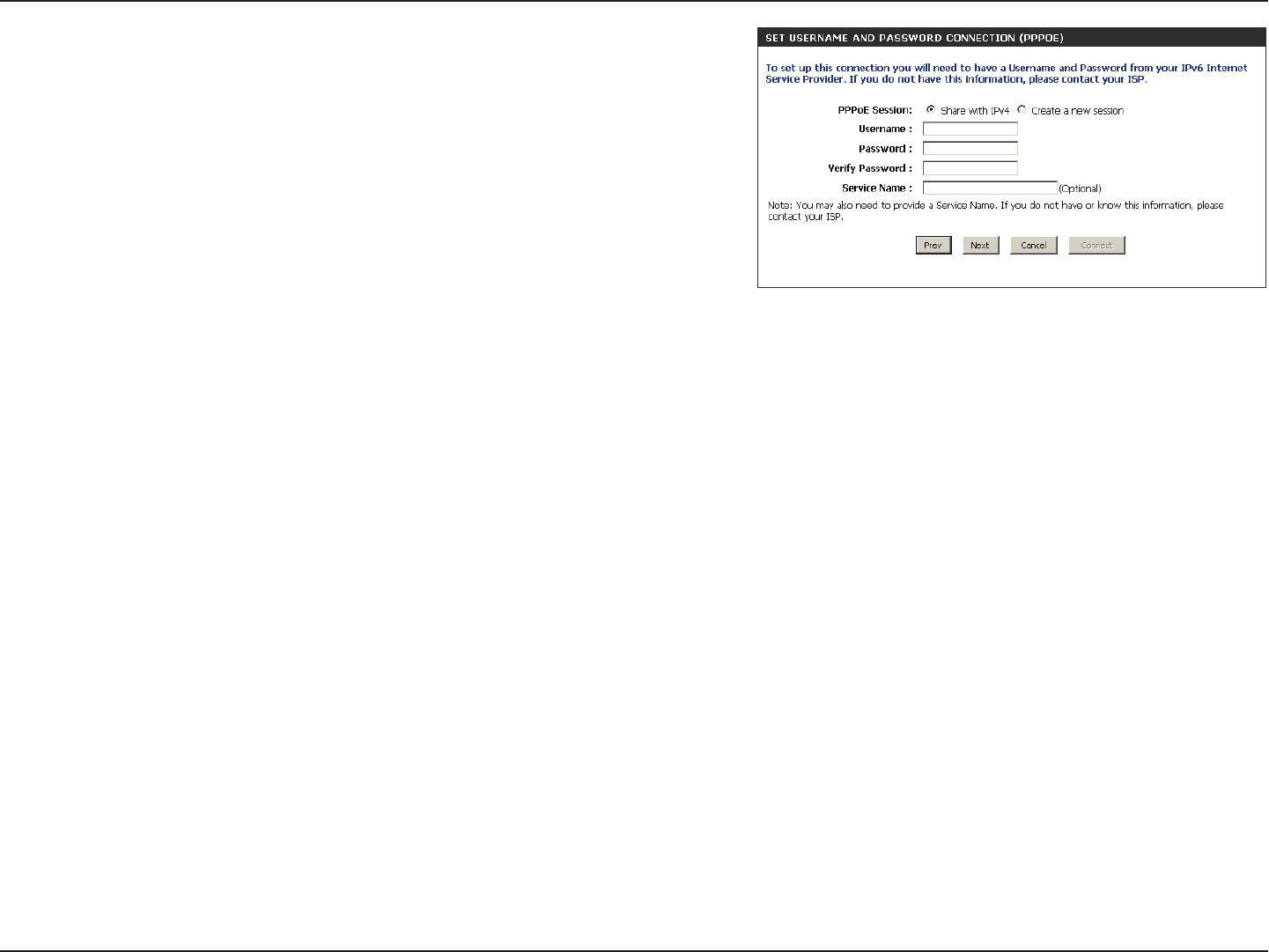
53D-Link DIR-868L User Manual
Section 3 - Conguration
IPv6 over PPPoE
After selecting the IPv6 over PPPoE option, the user will be able to congure the
IPv6 Internet connection that requires a username and password to get online.
Most DSL modems use this type of connection.
The following parameters will be available for conguration:
PPPoE Session: Select the PPPoE Session value used here. This
option will state that this connection shares it’s
information with the already congured IPv6
PPPoE connection, or the user can create a new
PPPoE connection here.
User Name: Enter the PPPoE username used here. If you do not
know your user name, please contact your ISP.
Password: Enter the PPPoE password used here. If you do not
know your password, please contact your ISP.
Verify Password: Re-enter the PPPoE password used here.
Service Name: Enter the service name for this connection here.
This option is optional.
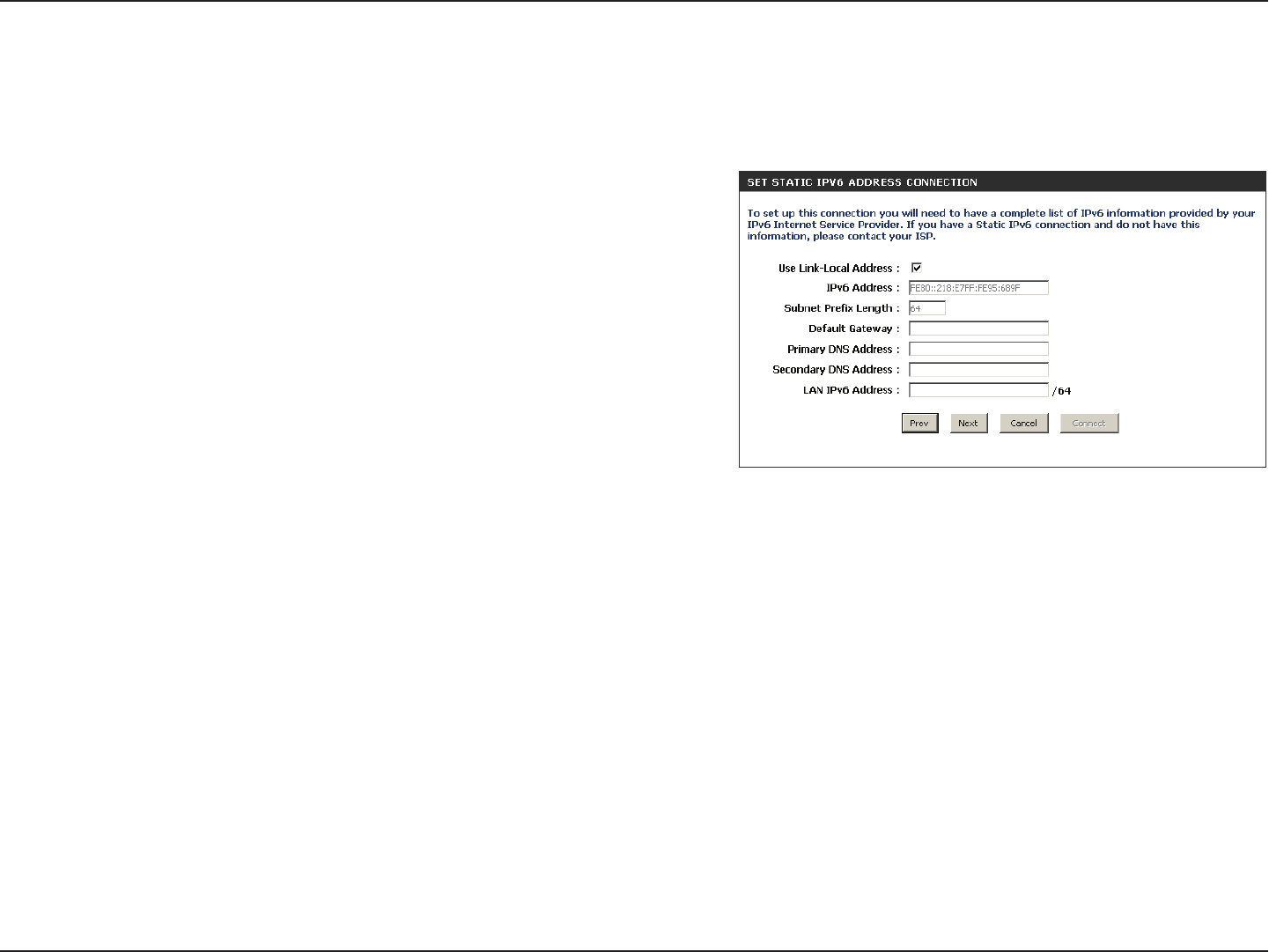
54D-Link DIR-868L User Manual
Section 3 - Conguration
Static IPv6 Address Connection
This mode is used when your ISP provides you with a set IPv6 addresses that does not change. The IPv6 information is manually entered in your
IPv6 conguration settings. You must enter the IPv6 address, Subnet Prex Length, Default Gateway, Primary DNS Server, and Secondary DNS
Server. Your ISP provides you with all this information.
Use Link-Local
Address:
IPv6 Address:
Subnet Prex
Length:
Default Gateway:
Primary DNS
Address:
Secondary DNS
Address:
LAN IPv6 Address:
The Link-local address is used by nodes and routers when
communicating with neighboring nodes on the same link. This
mode enables IPv6-capable devices to communicate with each
other on the LAN side.
Enter the WAN IPv6 address for the router here.
Enter the WAN subnet prex length value used here.
Enter the WAN default gateway IPv6 address used here.
Enter the WAN primary DNS Server address used here.
Enter the WAN secondary DNS Server address used here.
These are the settings of the LAN (Local Area Network) IPv6 interface for the router. The router’s LAN IPv6 Address conguration is
based on the IPv6 Address and Subnet assigned by your ISP. (A subnet with prex /64 is supported in LAN.)
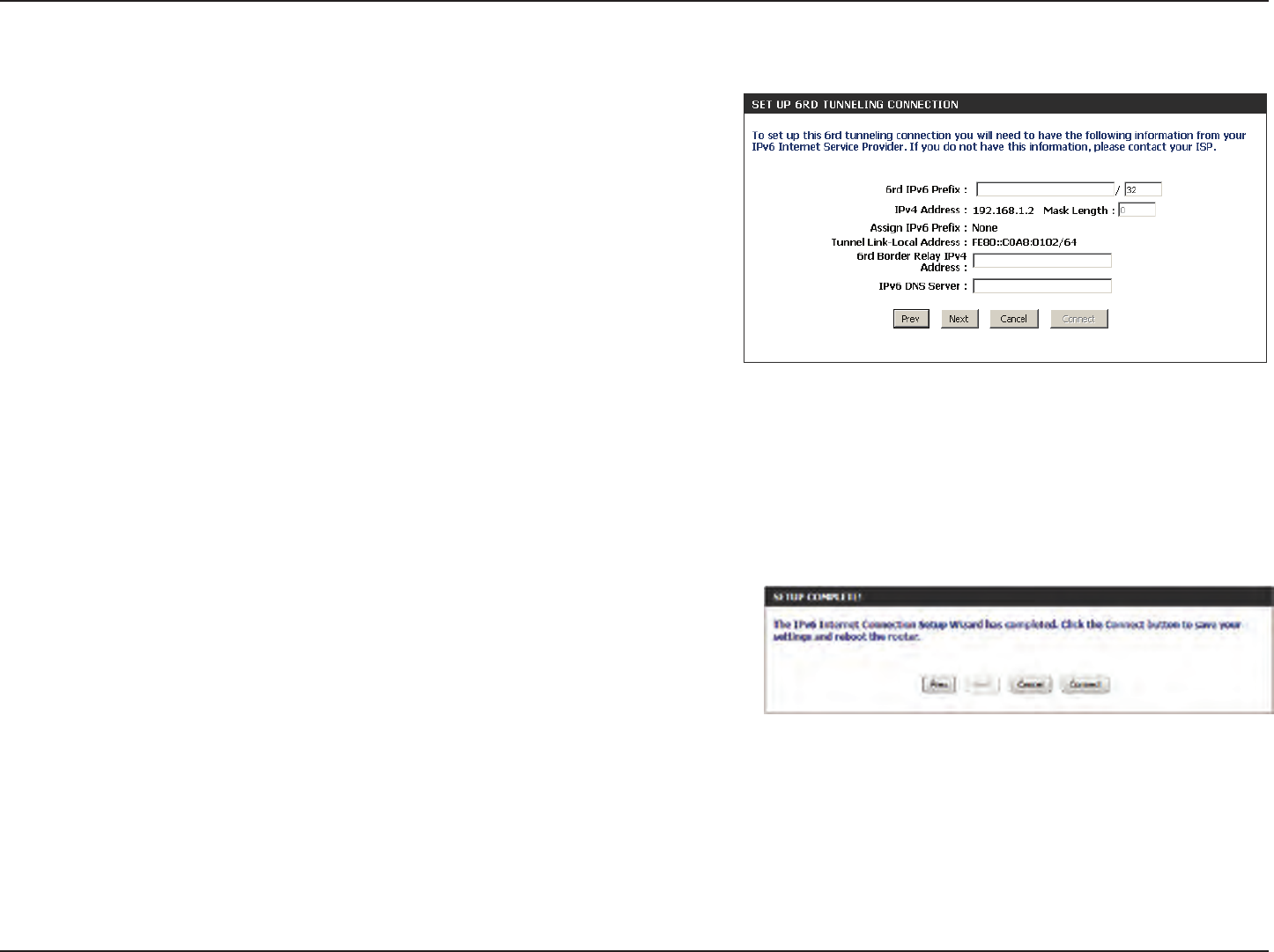
55D-Link DIR-868L User Manual
Section 3 - Conguration
The IPv6 Internet Connection Setup Wizard is complete.
Click on the Connect button to continue. Click on the Prev button to return to
the previous page. Click on the Cancel button to discard all the changes made
and return to the main page.
Tunneling Connection (6rd)
After selecting the Tunneling Connection (6rd) option, the user can congure the IPv6 6rd connection settings.
Enter the 6rd IPv6 address and prex value used here.
Enter the IPv4 address used here.
Enter the IPv4 mask length used here.
Displays the IPv6 assigned prex value here.
Enter the 6rd border relay IPv4 address used here.
Enter the primary DNS Server address used here.
6rd IPv6 Prex:
IPv4 Address:
Mask Length:
Assigned
IPv6 Prex:
6rd Border Relay
IPv4 Address:
IPv6 DNS Server:
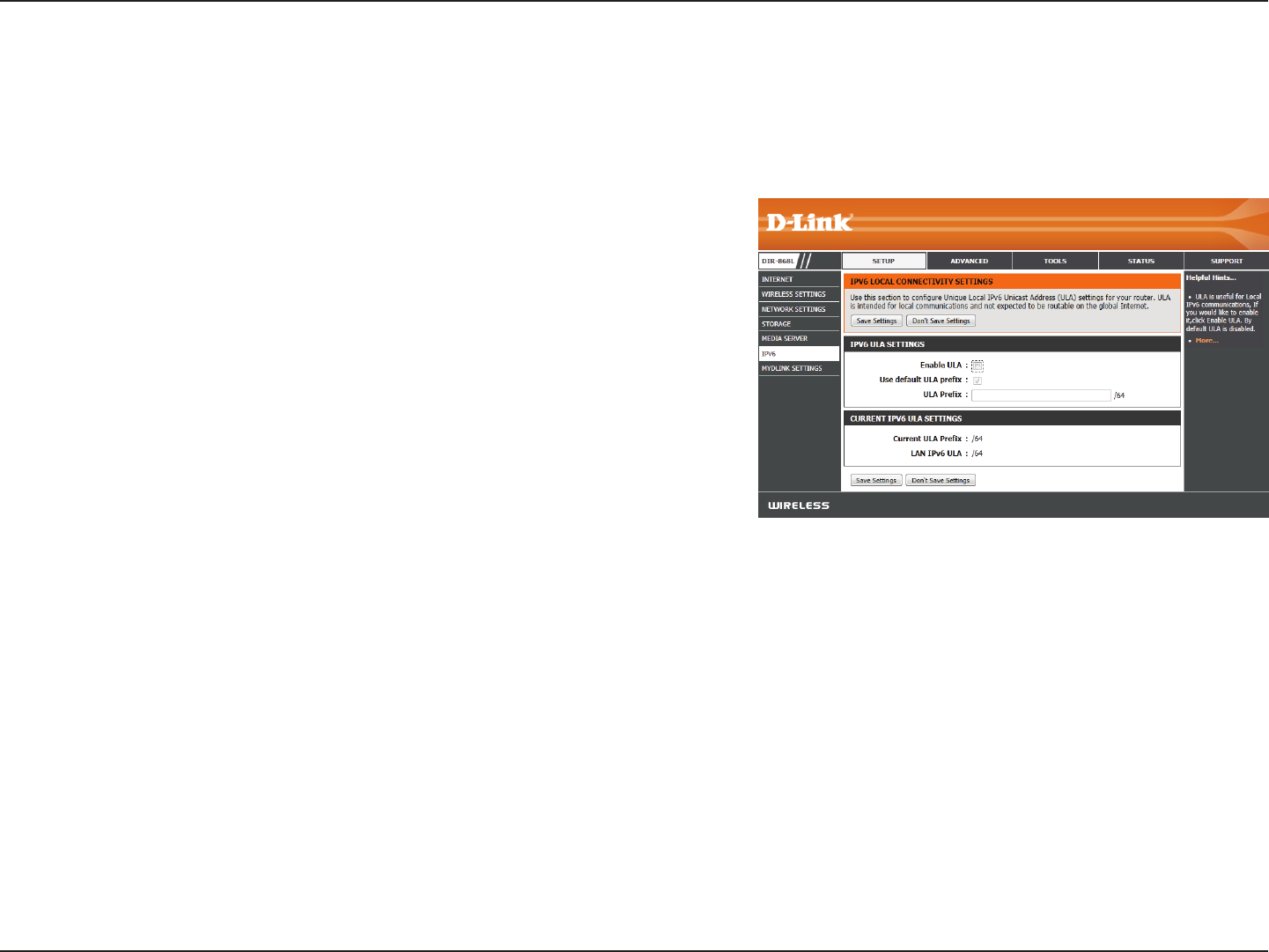
56D-Link DIR-868L User Manual
Section 3 - Conguration
Manual IPv6 Local Connectivity Setup
You can set up a local-only IPv6 Internet connection as well. If you want to congure an IPv6 connection that will not connect to the Internet, click
on the Manual IPv6 Local Connectivity Settings button.
Enable ULA:
Use Default
ULA Prex:
ULA Prex:
Current IPv6
ULA Settings:
Click here to enable Unique Local IPv6 Unicast Addresses settings.
Checking this box will automatically congure
the ULA prex for the default setting.
If you wish to choose your own ULA prex, enter it here.
This section with display the current settings for your IPv6 ULA.
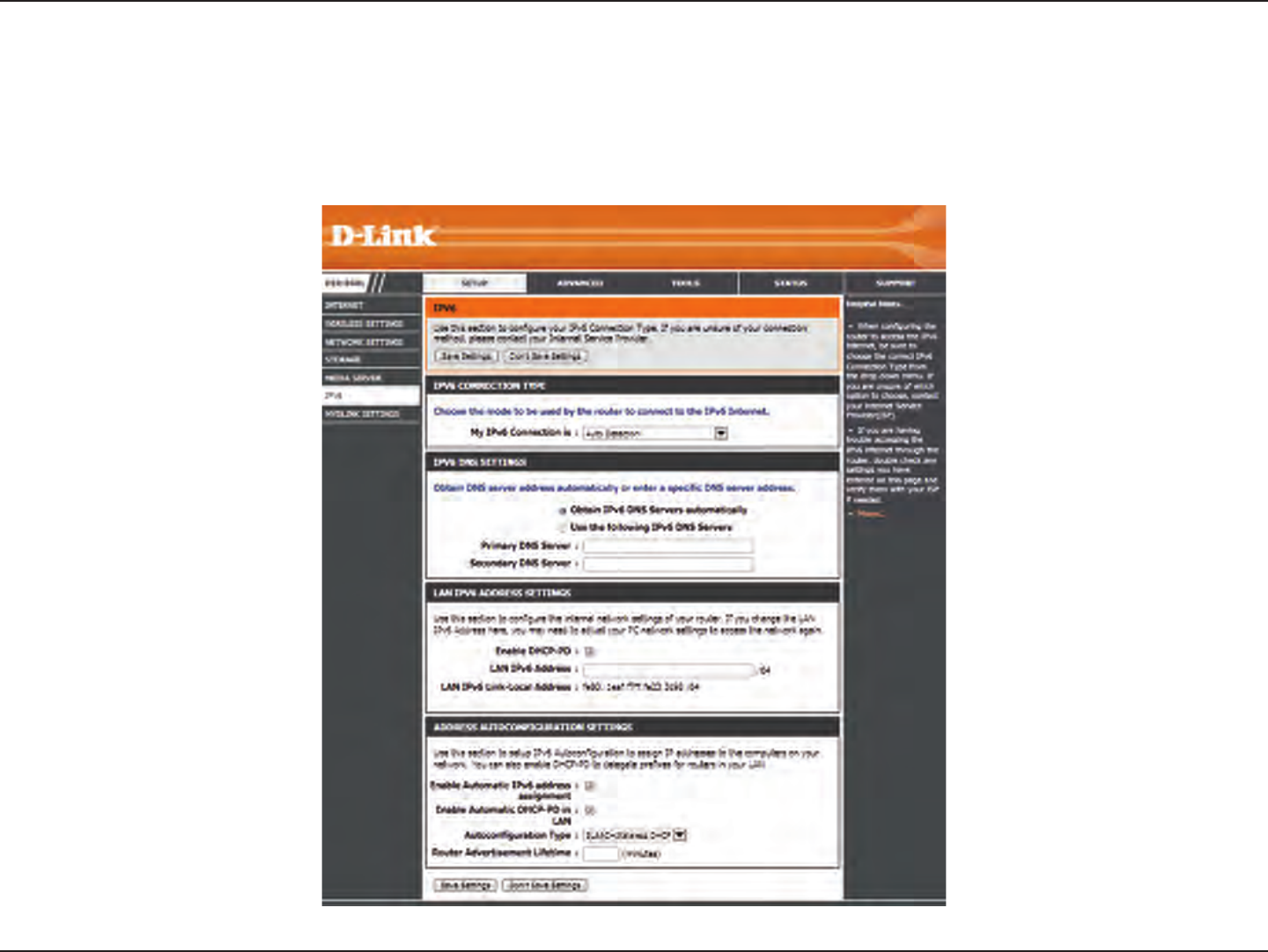
57D-Link DIR-868L User Manual
Section 3 - Conguration
IPv6 Manual Setup
There are several connection types to choose from: Auto Detection, Static IPv6, Autoconguration (SLAAC/DHCPv6), PPPoE, IPv6 in IPv4 Tunnel,
6to4, 6rd, and Link-local. If you are unsure of your connection method, please contact your IPv6 Internet Service Provider.
Note: If using the PPPoE option, you will need to ensure that any PPPoE client software on your computers has been removed or disabled.
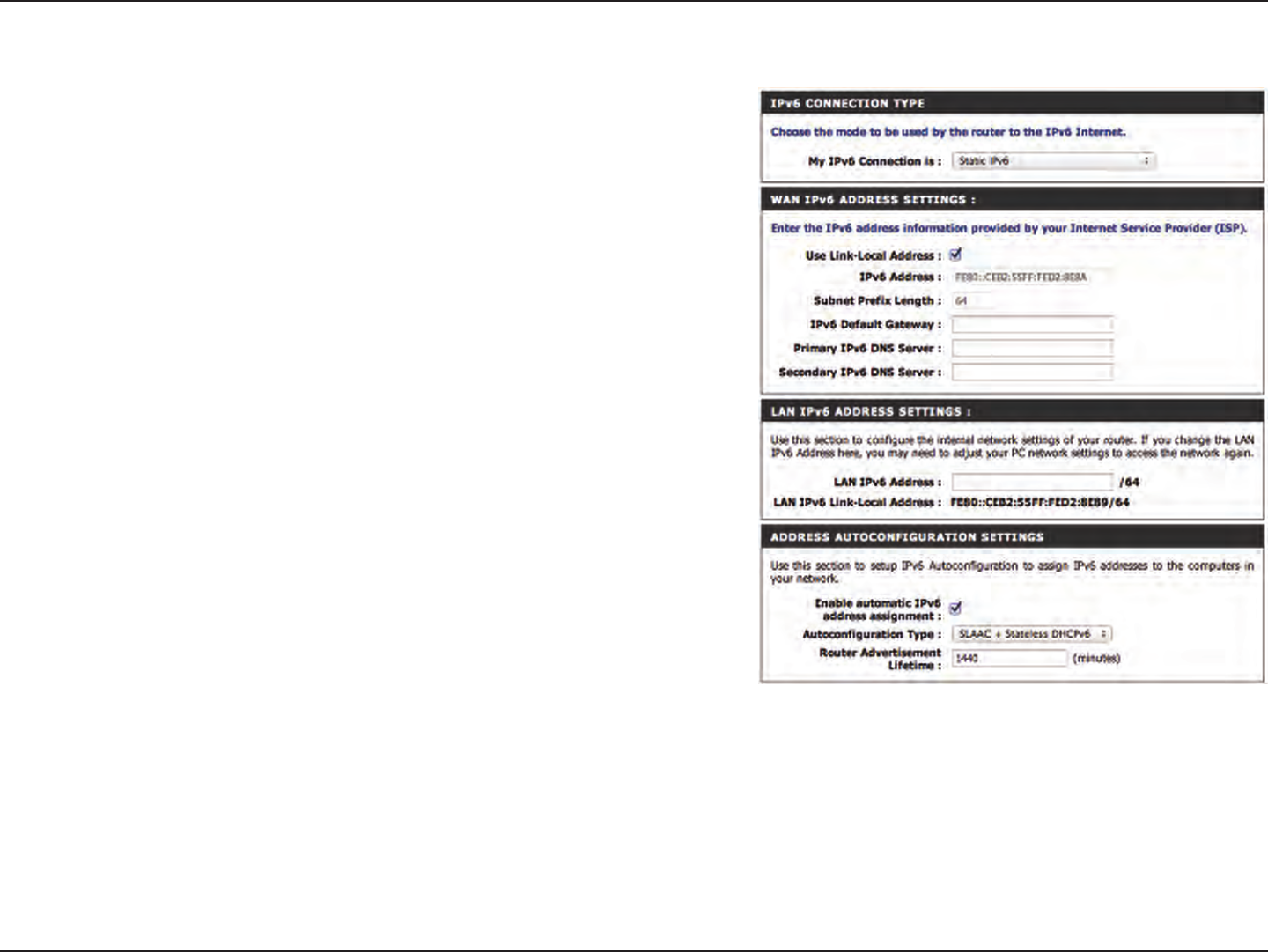
58D-Link DIR-868L User Manual
Section 3 - Conguration
Static IPv6
Select Static IPv6 from the drop-down menu.
Enter the address settings supplied by your Internet provider (ISP).
Enter a subnet prex length.
Enter the default gateway for your IPv6 connection.
Enter the primary and secondary DNS server addresses.
Enter the LAN (local) IPv6 address for the router.
Displays the router’s LAN Link-Local Address.
Check to enable the Autoconguration feature.
Choose either Stateful DHCPv6, SLAAC + RDNSS or SLAAC +
Stateless DHCPv6 from the drop-down menu.
Enter the IPv6 Address Lifetime (in minutes).
My IPv6
Connection Is:
Use Link-Local
Address:
Subnet Prex
Length:
IPv6 Default
Gateway:
Primary/
Secondary IPv6
DNS Servers:
LAN IPv6 Address:
LAN Link-Local
Address:
Enable Automatic
IPv6 Address
Assignment:
Autoconguration
Type:
Router
Advertisement
Lifetime:
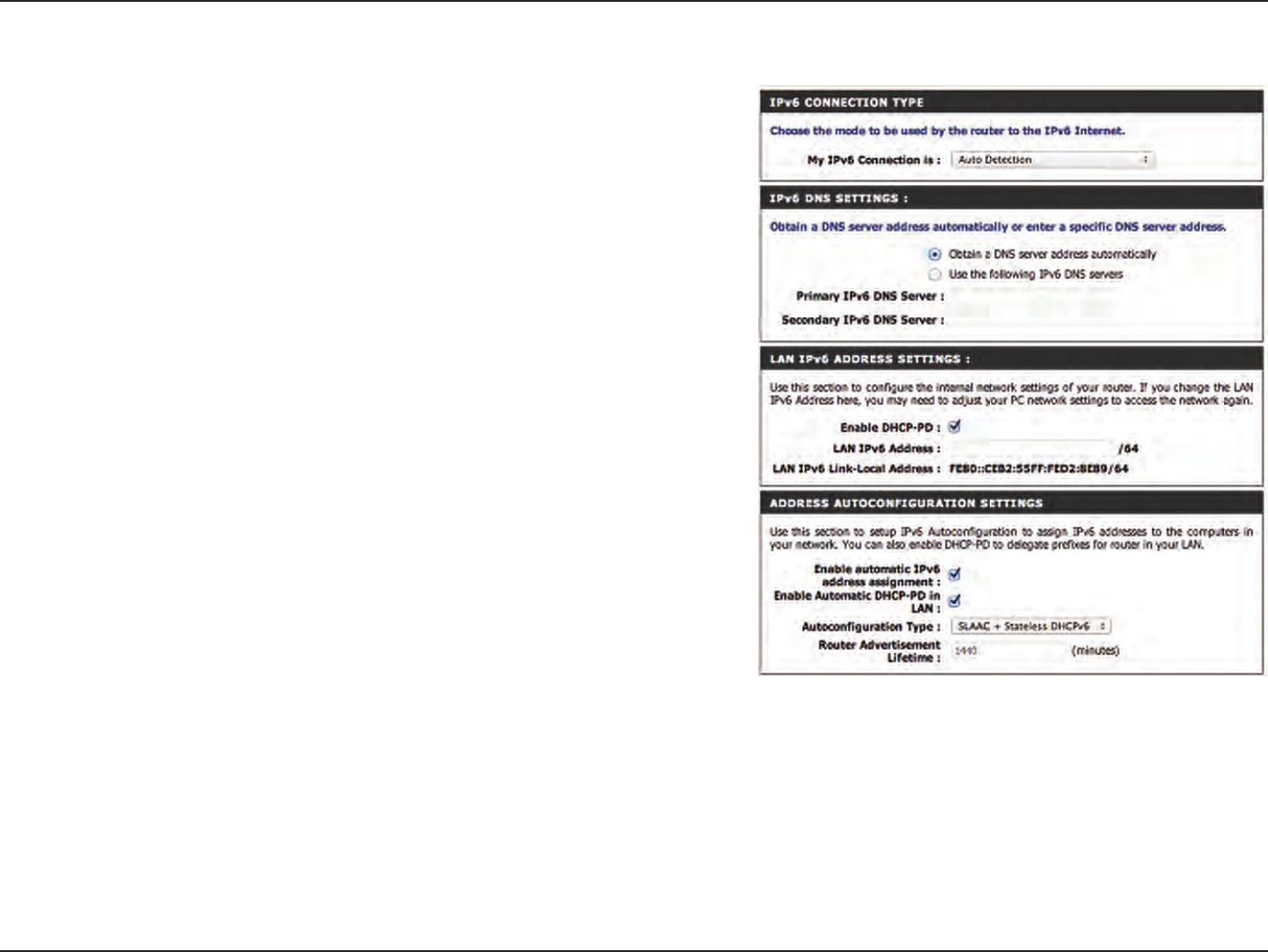
59D-Link DIR-868L User Manual
Section 3 - Conguration
Auto Detection
Select Auto Detection from the drop-down menu.
Select either Obtain DNS server address automatically or Use the
following DNS Address.
Enter the primary and secondary DNS server addresses.
Check this box to enable DHCP-PD services.
Enter the LAN (local) IPv6 address for the router.
Displays the Router’s LAN Link-Local Address.
Check to enable the Automatic IPv6 Address Assignment feature.
Check this box to automatically enable DHCP-PD services.
Select Stateful (DHCPv6), SLAAC + RDNSS or SLAAC + Stateless
DHCPv6.
Enter the IPv6 Address Lifetime (in minutes).
My IPv6
Connection Is:
IPv6 DNS Settings:
Primary/Secondary
DNS Address:
Enable DHCP-PD:
LAN IPv6 Address:
LAN Link-Local
Address:
Enable Automatic
IPv6 Address
Assignment:
Enable Automatic
DHCP-PD in LAN:
Autoconguration
Type:
Router
Advertisement
Lifetime:
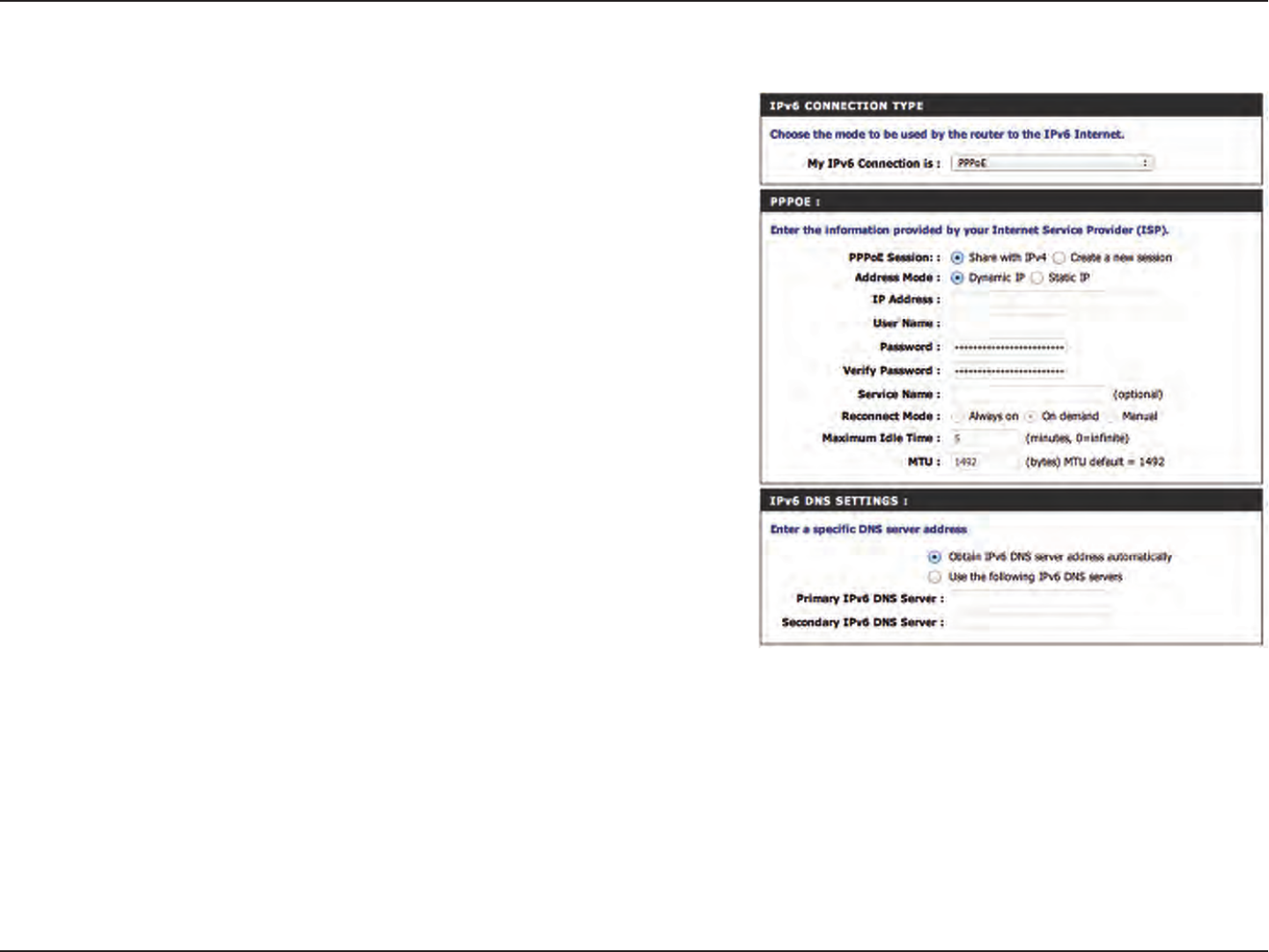
60D-Link DIR-868L User Manual
Section 3 - Conguration
PPPoE
Select PPPoE from the drop-down menu.
Enter the PPPoE account settings supplied by your Internet provider.
Select Static if your ISP assigned you the IP address, subnet mask,
gateway, and DNS server addresses. In most cases, select Dynamic.
Enter the IP address (Static PPPoE only).
Enter your PPPoE user name.
Enter your PPPoE password and retype the password in the next box.
Enter the ISP Service Name (optional).
Select either Always-on, On-Demand, or Manual.
Enter a maximum idle time during which the Internet connection is
maintained during inactivity.
Maximum Transmission Unit - you may need to change the MTU for
optimal performance with your specic ISP. 1492 is the default MTU.
Select either Obtain DNS server address automatically or Use the following DNS Address.
Enter the primary and secondary DNS server addresses.
My IPv6
Connection Is:
PPPoE Session:
Address Mode:
IP Address:
Username:
Password:
Service Name:
Reconnection
Mode:
Maximum Idle
Time:
MTU:
IPv6 DNS Settings:
Primary/Secondary
DNS Address:
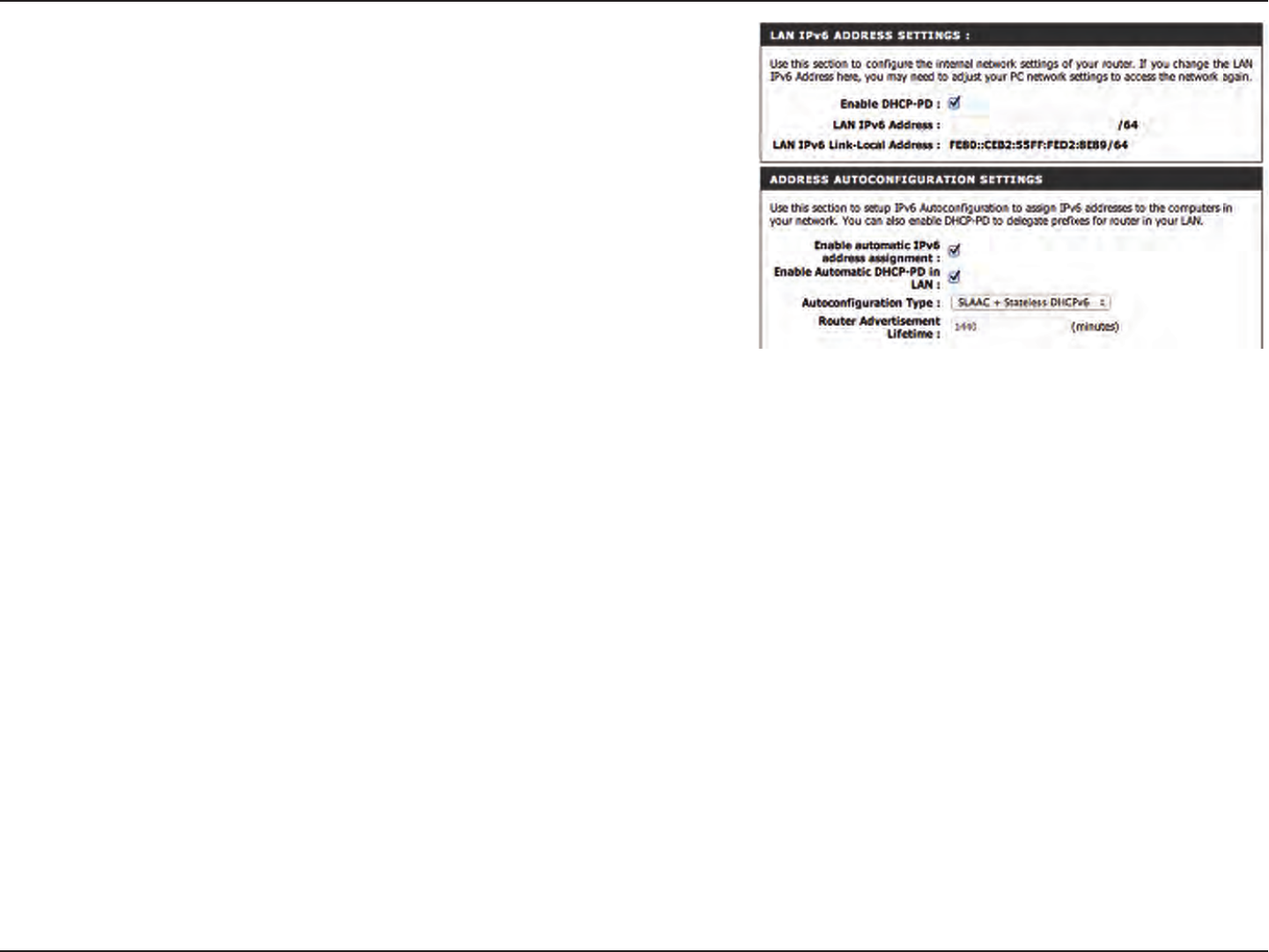
61D-Link DIR-868L User Manual
Section 3 - Conguration
Enable DHCP-D:
LAN IPv6 Address:
LAN Link-Local
Address:
Enable Automatic
IPv6 Address
Assignment:
Enable Automatic
DHCP-PD in LAN:
Autoconguration
Type:
IPv6 Address
Lifetime:
Check this box to enable DHCP prex delegation for each LAN on the
network.
Enter the LAN (local) IPv6 address for the router.
Displays the router’s LAN Link-Local Address.
Check to enable the Automatic IPv6 Address Assignment feature.
Check this box to enable automatica conguration of the DHCP prex
delegation for each LAN on the network.
Select Stateful (DHCPv6), SLAAC + RDNSS or SLAAC + Stateless DHCPv6.
Enter the IPv6 Address Lifetime (in minutes).
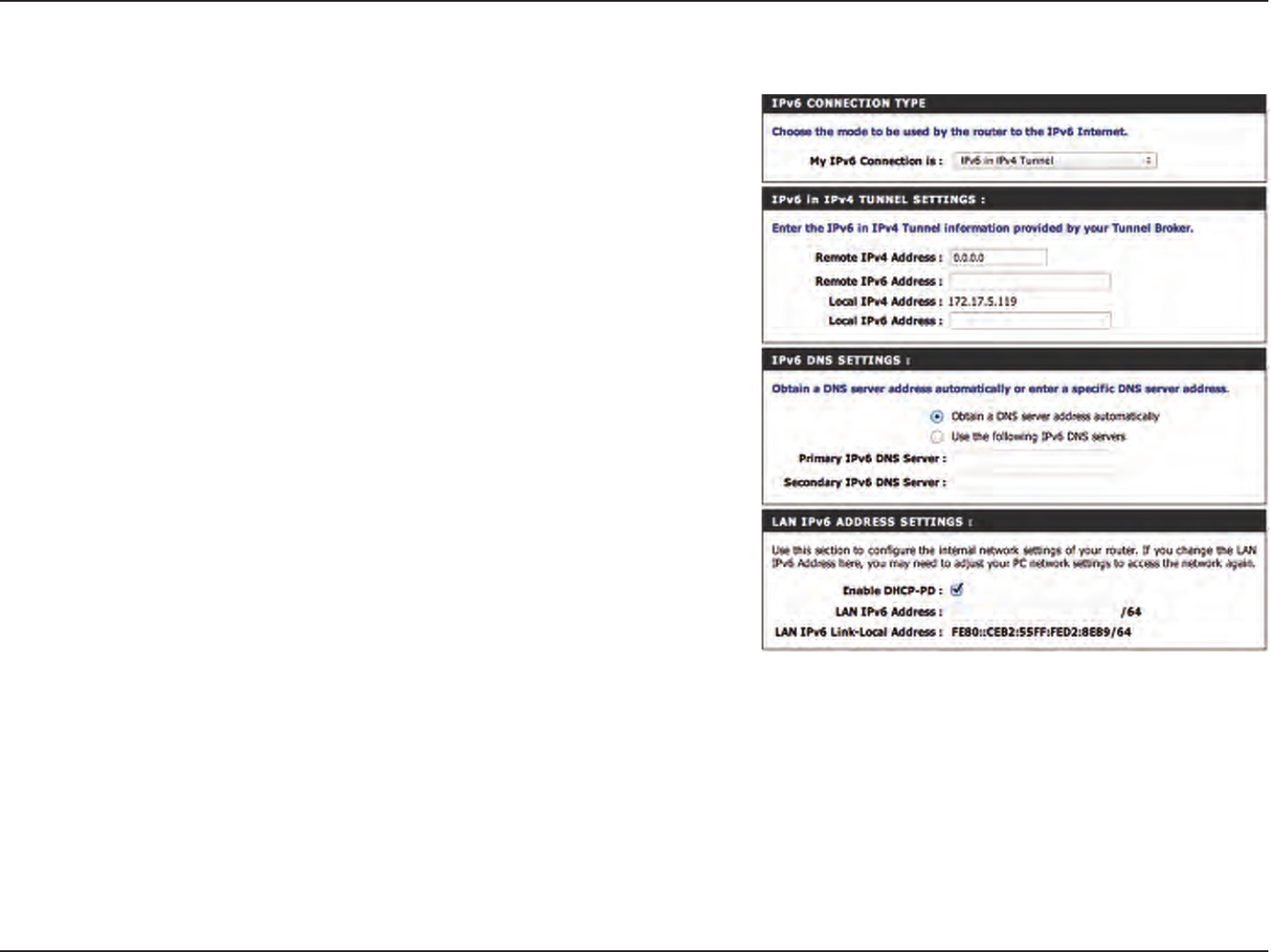
62D-Link DIR-868L User Manual
Section 3 - Conguration
IPv6 in IPv4 Tunneling
Select IPv6 in IPv4 Tunnel from the drop-down menu.
Enter the IPv4 remote address you will use.
Enter the IPv6 remote address you will use.
Enter the IPv4 local address you will use.
Enter the IPv6 local address you will use.
Select either Obtain DNS server address automatically or Use the
following DNS Address.
Enter the primary and secondary DNS server addresses.
Check this box to enable DHCP prex delegation for each LAN.
Enter the LAN (local) IPv6 address for the router.
Displays the router’s LAN Link-Local Address.
My IPv6
Connection Is:
Remote IPv4
Address:
Remote IPv6
Address:
Local IPv4 Address:
Local IPv6 Address:
IPv6 DNS Settings:
Primary/Secondary
DNS Address:
Enable DHCP-D:
LAN IPv6 Address:
LAN IPv6 Lin-Local
Address:
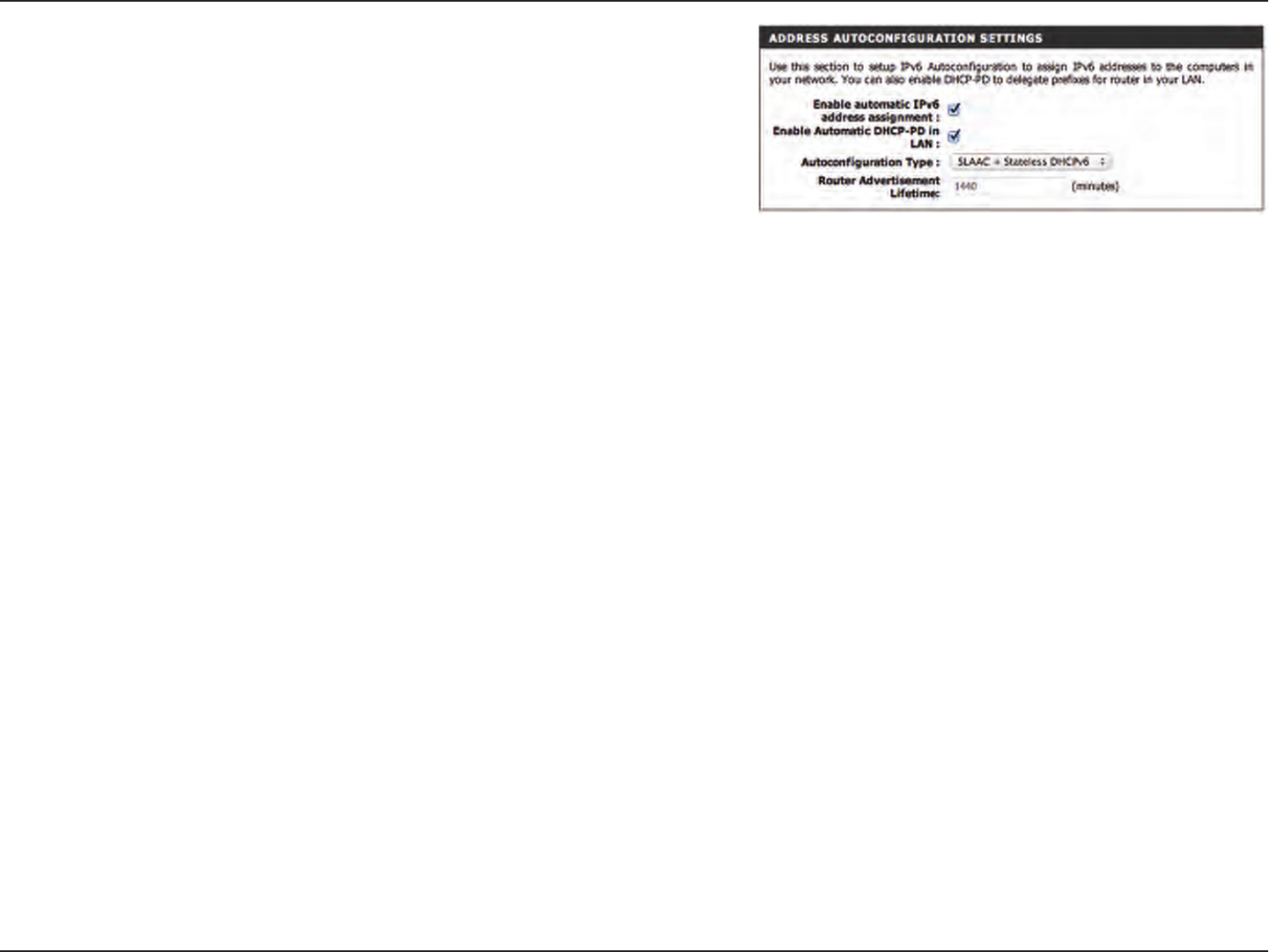
63D-Link DIR-868L User Manual
Section 3 - Conguration
Enable Automatic
IPv6 Address
Assignment:
Enable Automatic
DHCP-PD in LAN:
Autoconguration
Type:
Router
Advertisement
Lifetime:
Check to enable the Automatic IPv6 Address Assignment feature.
Check this box to enable automatic conguration of the DHCP prex
delegation for each LAN on the network.
Select Stateful (DHCPv6), SLAAC + RDNSS or SLAAC + Stateless
DHCPv6.
Enter the Router Advertisement Lifetime (in minutes).
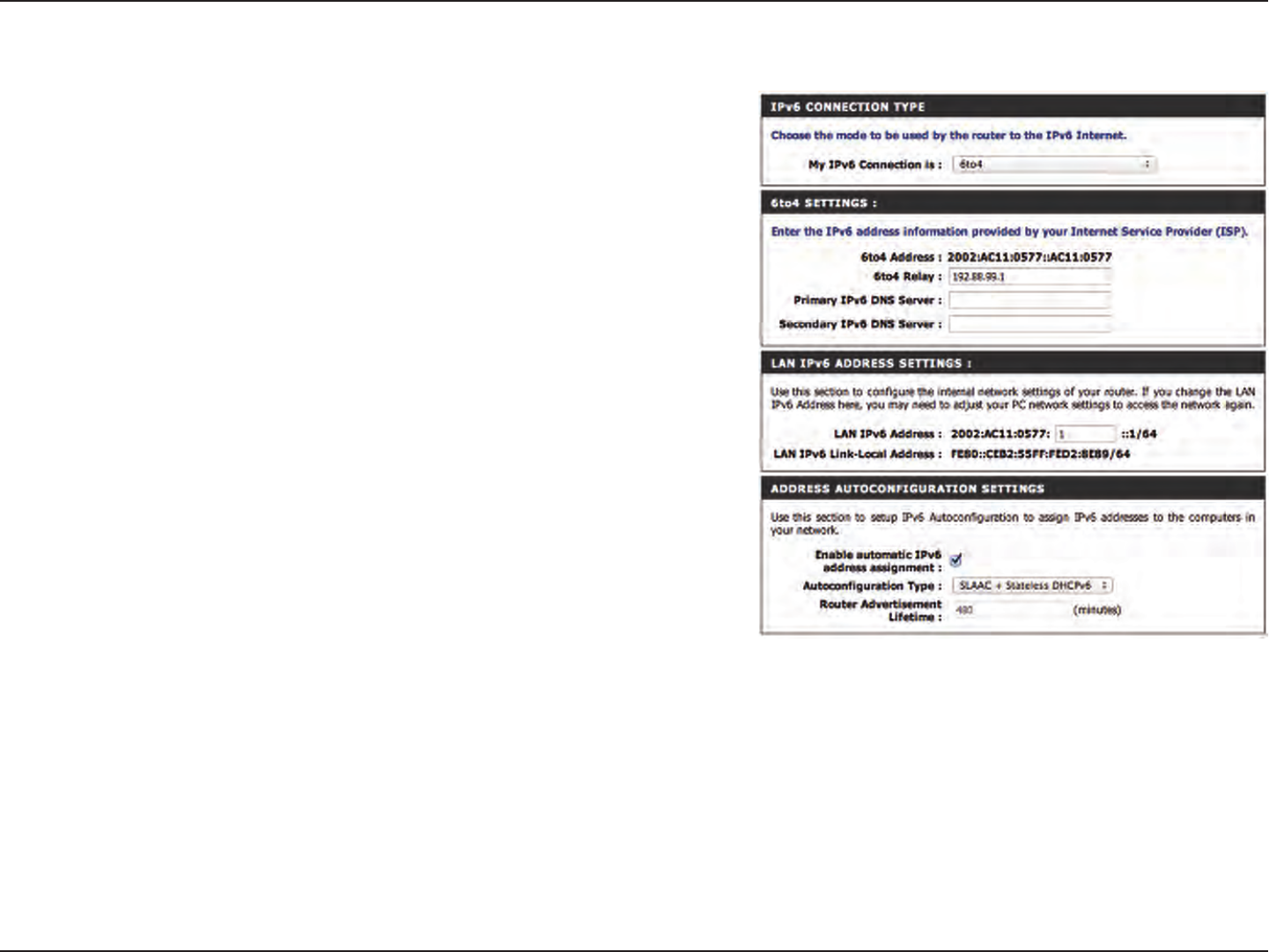
64D-Link DIR-868L User Manual
Section 3 - Conguration
6to4
Select 6to4 from the drop-down menu.
Enter the IPv6 settings supplied by your ISP.
Enter the IPv6 relay supplied by your ISP.
Enter the primary and secondary DNS server addresses.
Enter the LAN (local) IPv6 address for the router.
Displays the Router’s LAN Link-Local Address.
Check to enable the Automatic IPv6 Address Assignment feature.
Select Stateful (DHCPv6), SLAAC + RDNSS or SLAAC + Stateless
DHCPv6.
Enter the IPv6 Address Lifetime (in minutes).
My IPv6
Connection Is:
6to4 Address:
6to4 Relay:
Primary/Secondary
DNS Address:
LAN IPv6 Address:
LAN Link-Local
Address:
Enable Automatic
IPv6 Address
Assignment:
Autoconguration
Type:
Router
Advertisement
Lifetime:
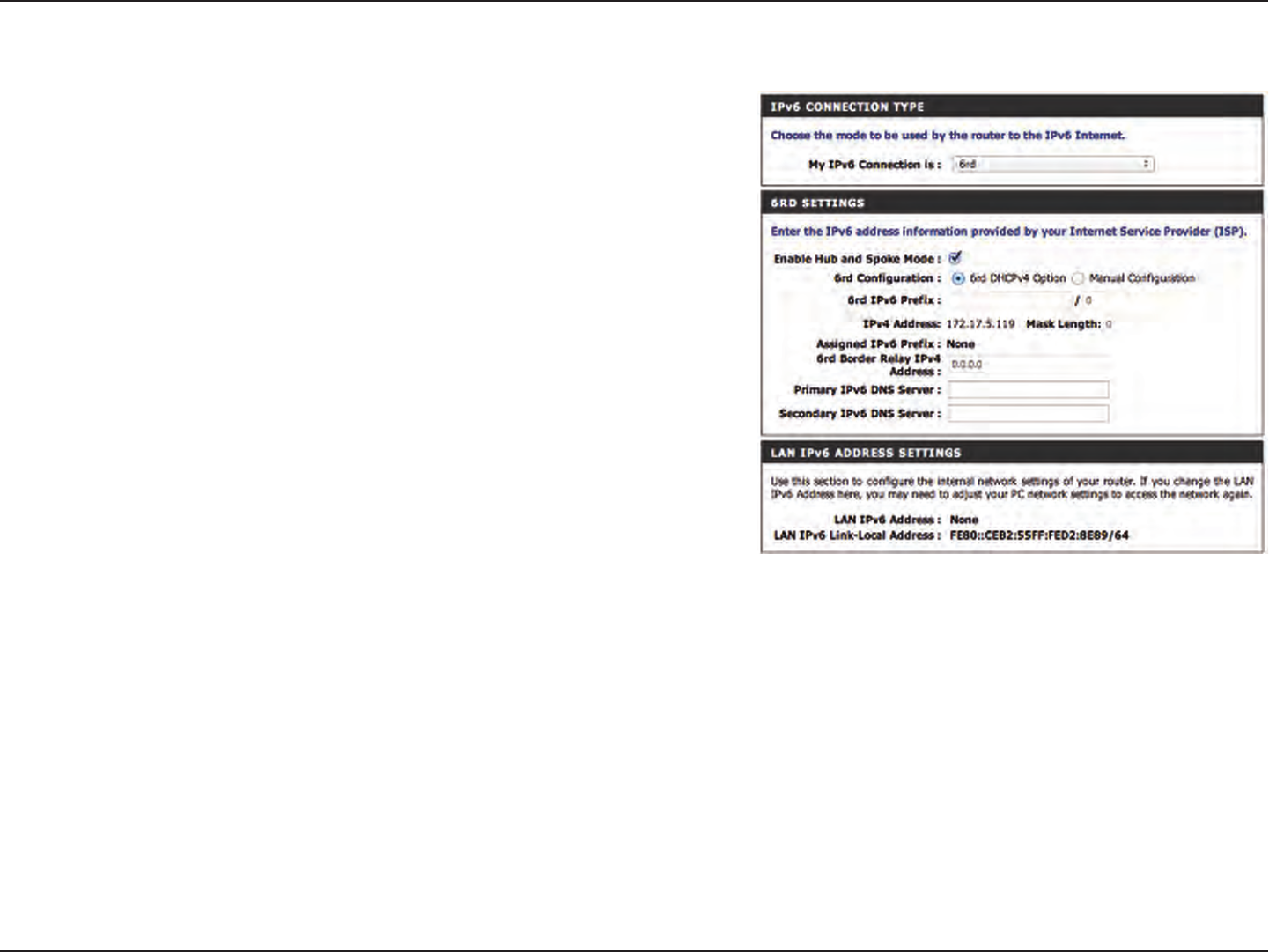
65D-Link DIR-868L User Manual
Section 3 - Conguration
6rd
Select 6rd from the drop-down menu.
Check this box if you want to minimize the number of routes to the
destination by using a hub and spoke method of networking.
Choose the 6rd DHCPv4 Option to automatically discover and populate
the data values, or Manual Conguration to enter the settings yourself.
Enter the 6rd IPv6 prex settings supplied by your ISP.
You IPv4 address will appear here.
Enter the desired IPv4 mask length.
When an IPv6 prex is assigned, it will appear here.
Enter the 6rd Border Relay IPv4 address settings supplied by your ISP.
Enter the primary and secondary DNS server addresses.
Enter the LAN (local) IPv6 address for the router.
Displays the Router’s LAN Link-Local Address.
My IPv6
Connection Is:
Enable Hub and
Spoke Mode:
6rd Conguration:
6rd IPv6 Prex:
IPv4 Address:
Mask Length:
Assigned IPv6
Prex:
6rd Border Relay
IPv4 Address:
Primary/
Secondary DNS
Address:
LAN IPv6 Address:
LAN Link-Local
Address:
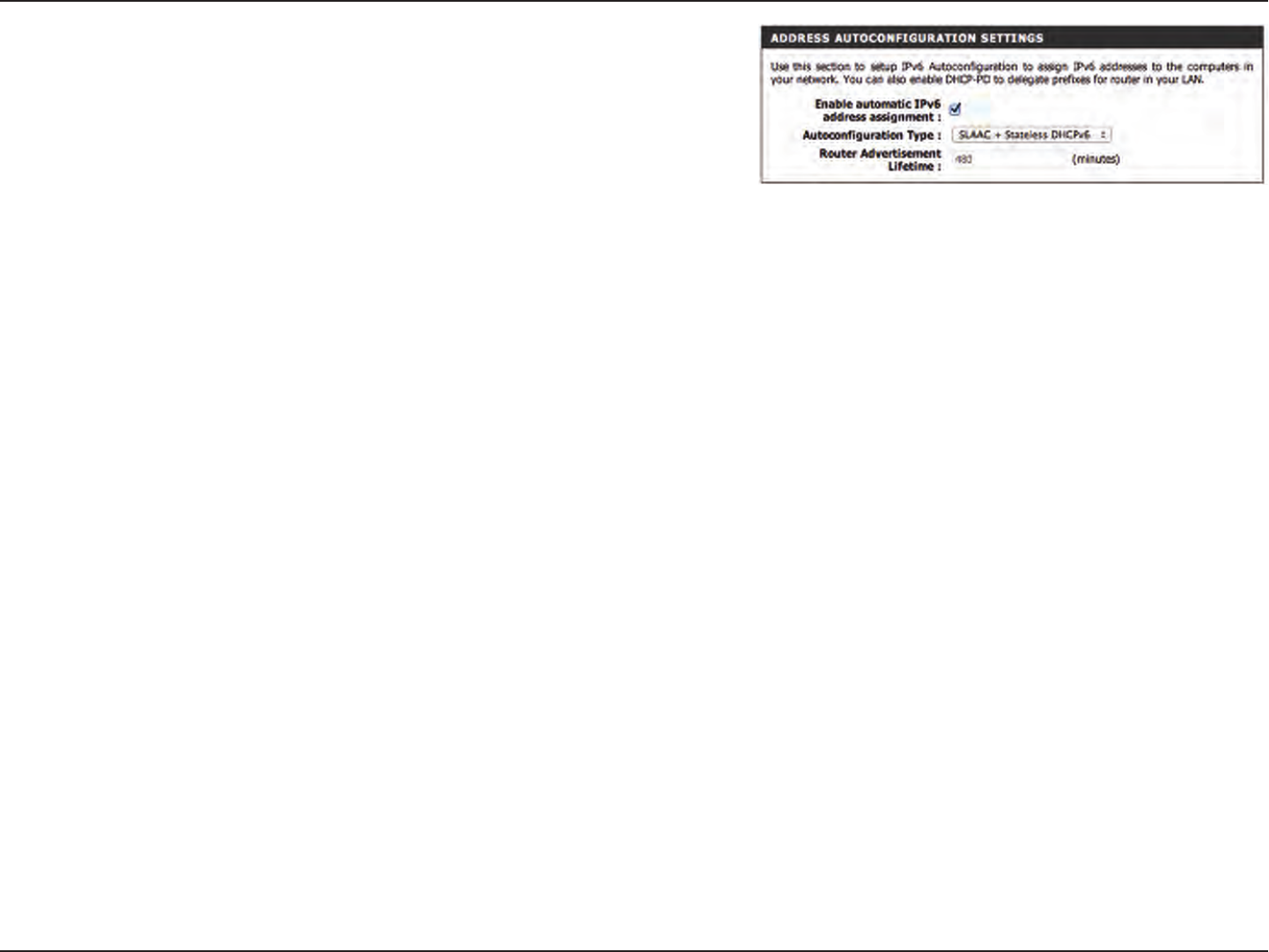
66D-Link DIR-868L User Manual
Section 3 - Conguration
Enable Automatic
IPv6 Address
Assignment:
Autoconguration
Type:
Router
Advertisement
Lifetime:
Check to enable the Automatic IPv6 Address Assignment feature.
Select Stateful (DHCPv6), SLAAC + RDNSS or SLAAC + Stateless
DHCPv6.
Enter the IPv6 Address Lifetime (in minutes).
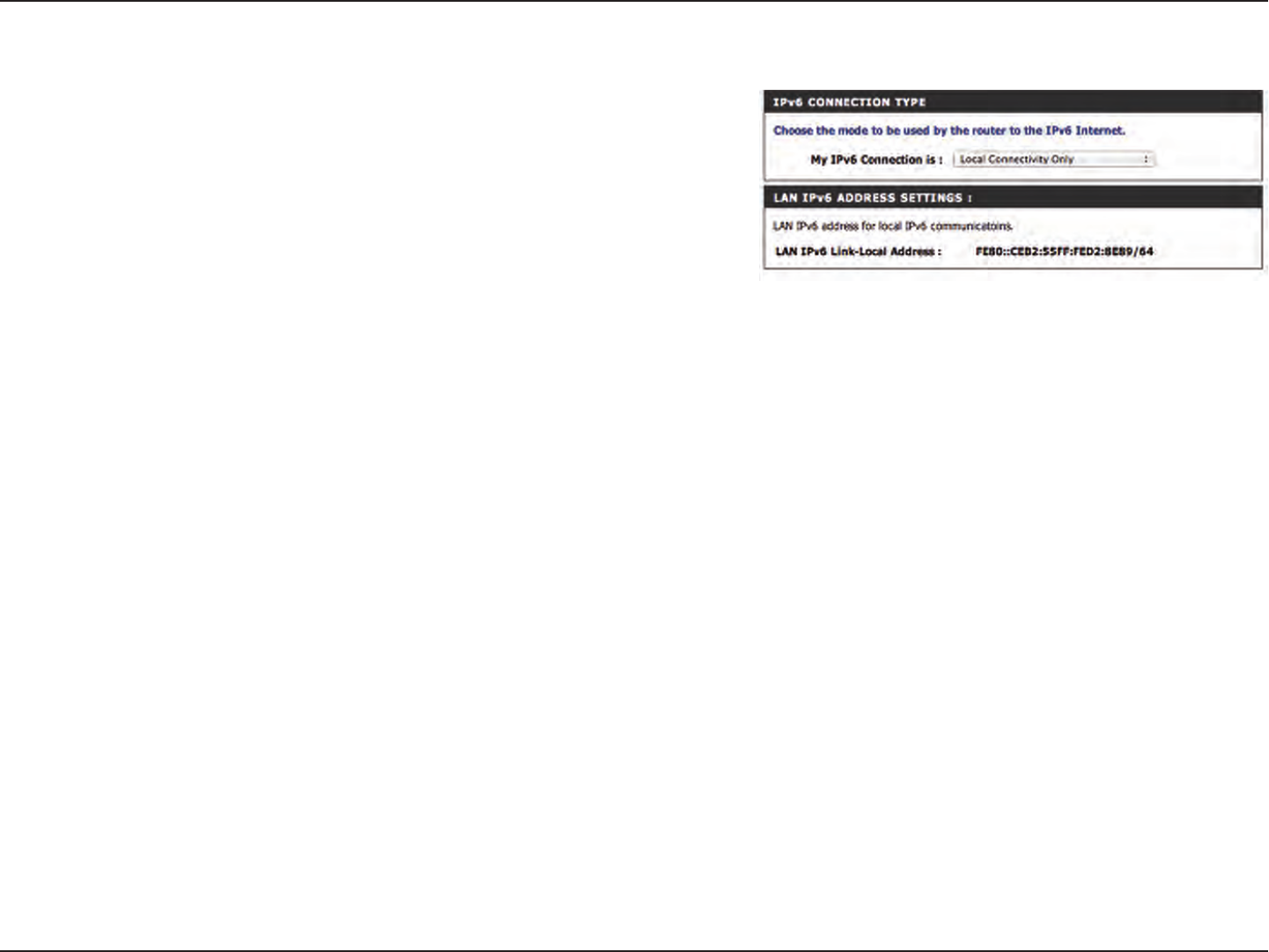
67D-Link DIR-868L User Manual
Section 3 - Conguration
Select Link-Local Only from the drop-down menu.
Displays the IPv6 address of the router.
My IPv6
Connection Is:
LAN IPv6 Address
Settings:
Link-Local Connectivity
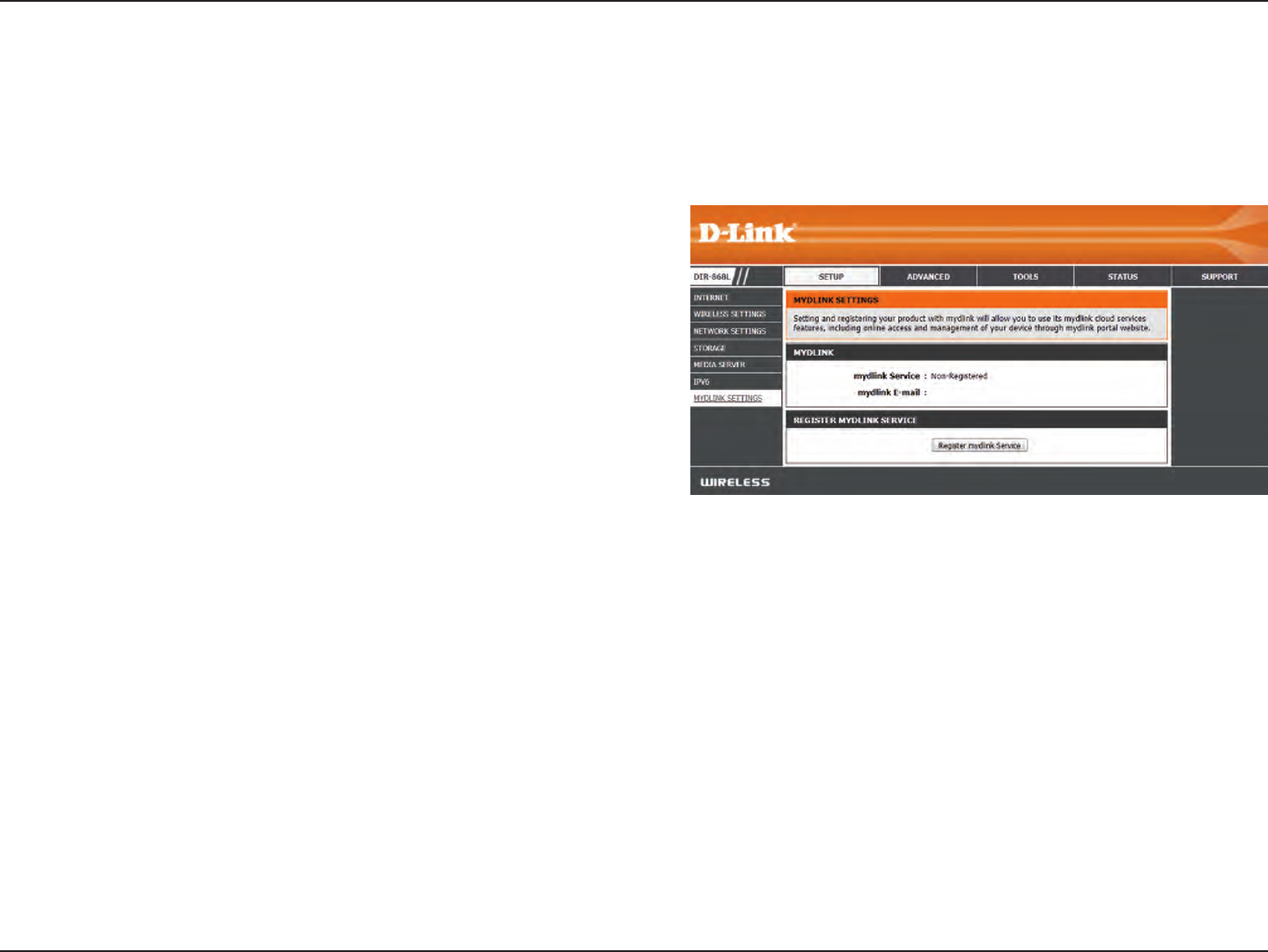
68D-Link DIR-868L User Manual
Section 3 - Conguration
mydlink Settings
Displays whether your device is registered with a mydlink
account or not.
Displays the email address associated with your mydlink
account if you have an active account.
Click to go to the mydlink website to register your device or
edit your settings.
mydlink Service:
mydlink E-mail:
Register mydlink
Service:
Devices that are mydlink-enabled can be accessed and managed through the mydlink website and by using mydlink mobile apps for iOS and
Android. You cannot take advantage of these features without a mydlink account. If you have a mydlink account already, you can log in when you
rst set up the router, or by visitng this setup page.
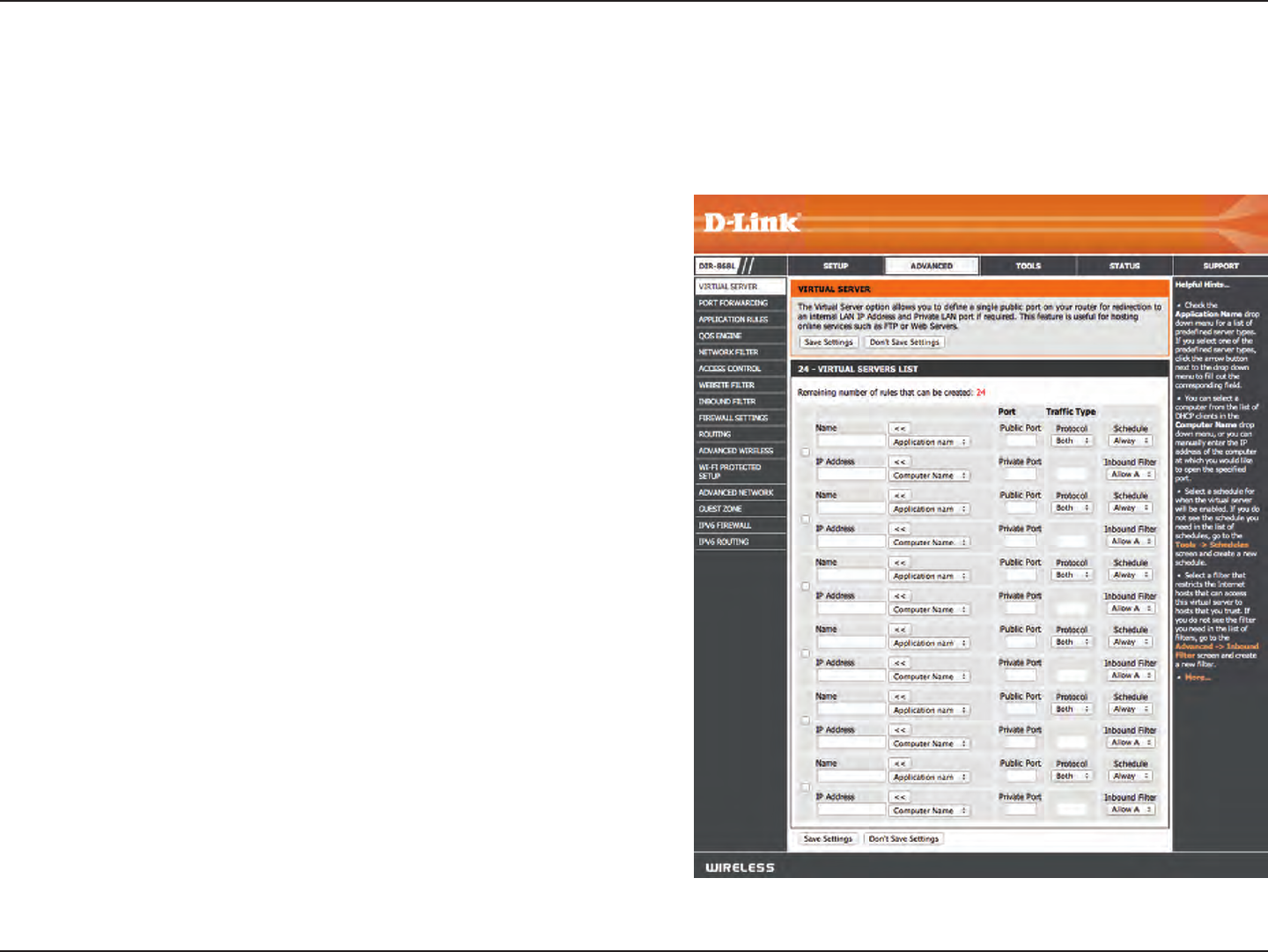
69D-Link DIR-868L User Manual
Section 3 - Conguration
This page will allow you to open a single port. If you would like to open a range of ports, refer to the next page.
Enter a name for the rule or select an application from the
drop-down menu. Select an application and click << to
populate the elds.
Enter the IP address of the computer on your local network
that you want to allow the incoming service to. If your
computer is receiving an IP address automatically from the
router (DHCP), your computer will be listed in the “Computer
Name” drop-down menu.
Enter the port that you want to open next to Private Port
and Public Port. The private and public ports are usually the
same. The public port is seen from the Internet side, and
the private port is used by the application on the computer
within your local network.
Select TCP, UDP, or Both from the drop-down menu.
The schedule of time when the Virtual Server Rule will be
enabled. The schedule may be set to Always, which will allow
the particular service to always be enabled. You can create
your own times in the Tools > Schedules section.
Select Allow All (most common) or a created Inbound lter.
You may create your own inbound lters in the Advanced >
Inbound Filter page.
Name:
IP Address:
Private Port/
Public Port:
Protocol:
Schedule:
Inbound Filter:
Virtual Server
Advanced
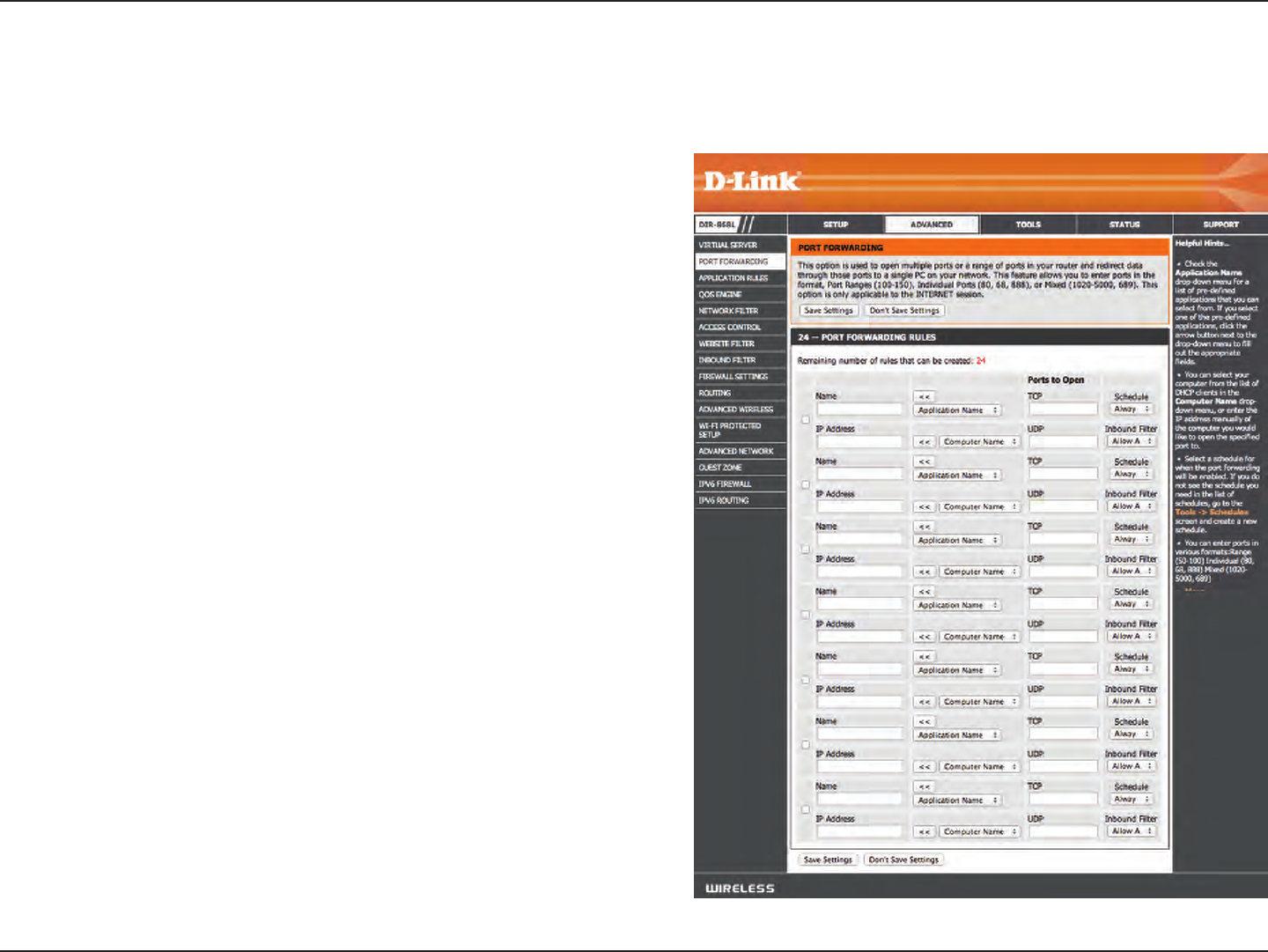
70D-Link DIR-868L User Manual
Section 3 - Conguration
This page will allow you to open a single port or a range of ports.
Port Forwarding
Enter a name for the rule or select an application from the
drop-down menu. Select an application and click to populate
the elds.
Enter the IP address of the computer on your local network that
you want to allow the incoming service to. If your computer is
receiving an IP address automatically from the router (DHCP),
you computer will be listed in the “Computer Name” drop-
down menu. Select your computer and click <<.
Enter the TCP and/or UDP port or ports that you want to open.
You can enter a single port or a range of ports. Separate ports
with a common. Example: 24,1009,3000-4000
The schedule of time when the Virtual Server Rule will be
enabled. The schedule may be set to Always, which will allow
the particular service to always be enabled. You can create your
own times in the Tools > Schedules section.
Select Allow All (most common) or a created Inbound lter.
You may create your own inbound lters in the Advanced >
Inbound Filter page.
Name:
IP Address:
TCP/UDP:
Schedule:
Inbound Filter:
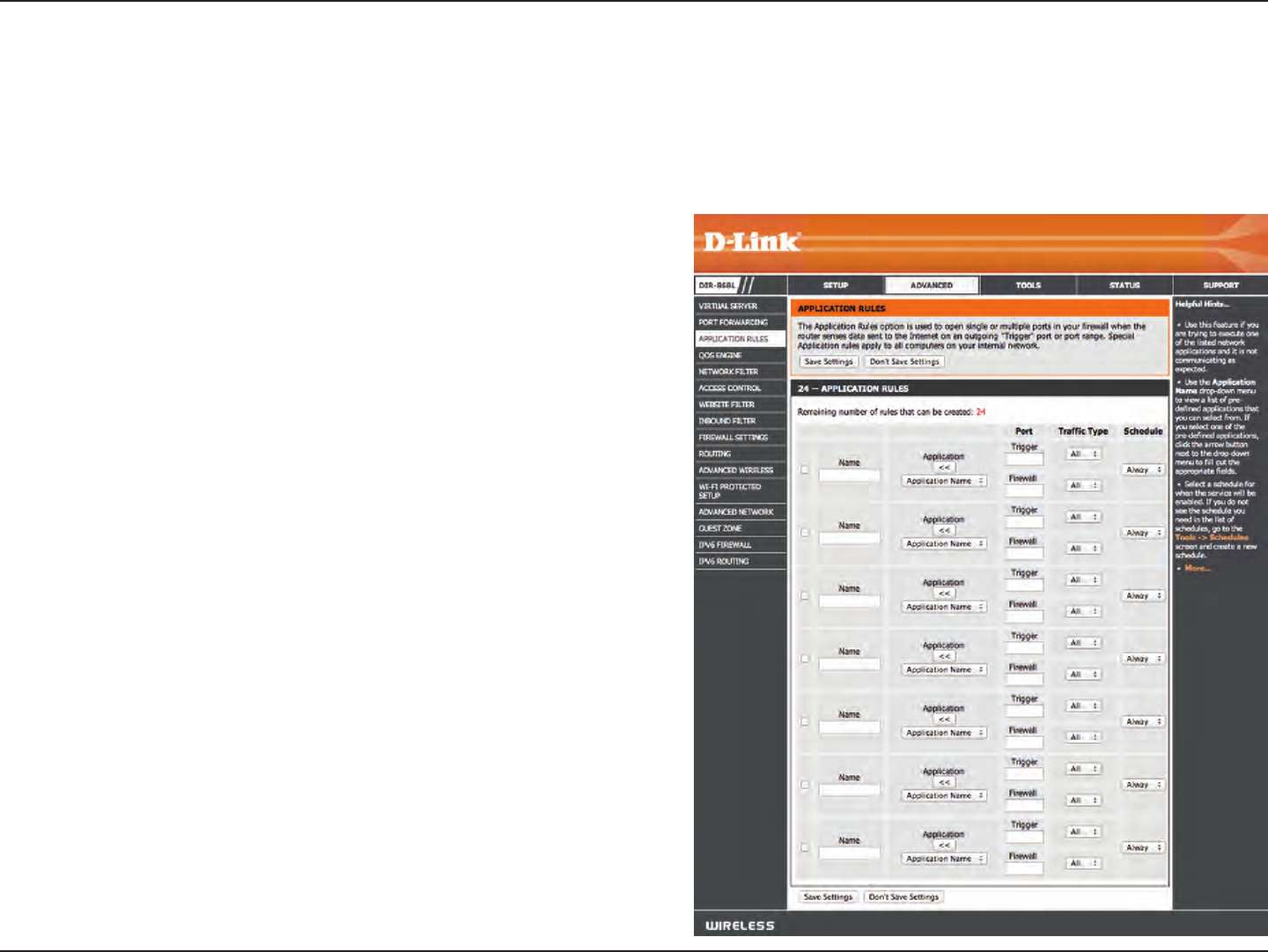
71D-Link DIR-868L User Manual
Section 3 - Conguration
Enter a name for the rule. You may select a pre-dened
application from the drop-down menu and click.
This is the port used to trigger the application. It
can be either a single port or a range of ports.
Select the protocol of the trigger port (TCP, UDP, or Both).
This is the port number on the Internet side that
will be used to access the application. You may
dene a single port or a range of ports. You can use
a comma to add multiple ports or port ranges.
Select the protocol of the rewall port (TCP, UDP, or Both).
The schedule of time when the Application Rule will be
enabled. The schedule may be set to Always, which will
allow the particular service to always be enabled. You can
create your own times in the Tools > Schedules section.
Name:
Trigger:
Trac Type:
Firewall:
Trac Type:
Schedule:
Application Rules
Some applications require multiple connections, such as Internet gaming, video conferencing, Internet telephony and others. These applications
have diculties working through NAT (Network Address Translation). Special Applications makes some of these applications work with the DIR-868L.
If you need to run applications that require multiple connections, specify the port normally associated with an application in the “Trigger Port”
eld, select the protocol type as TCP or UDP, then enter the rewall (public) ports associated with the trigger port to open them for inbound trac.
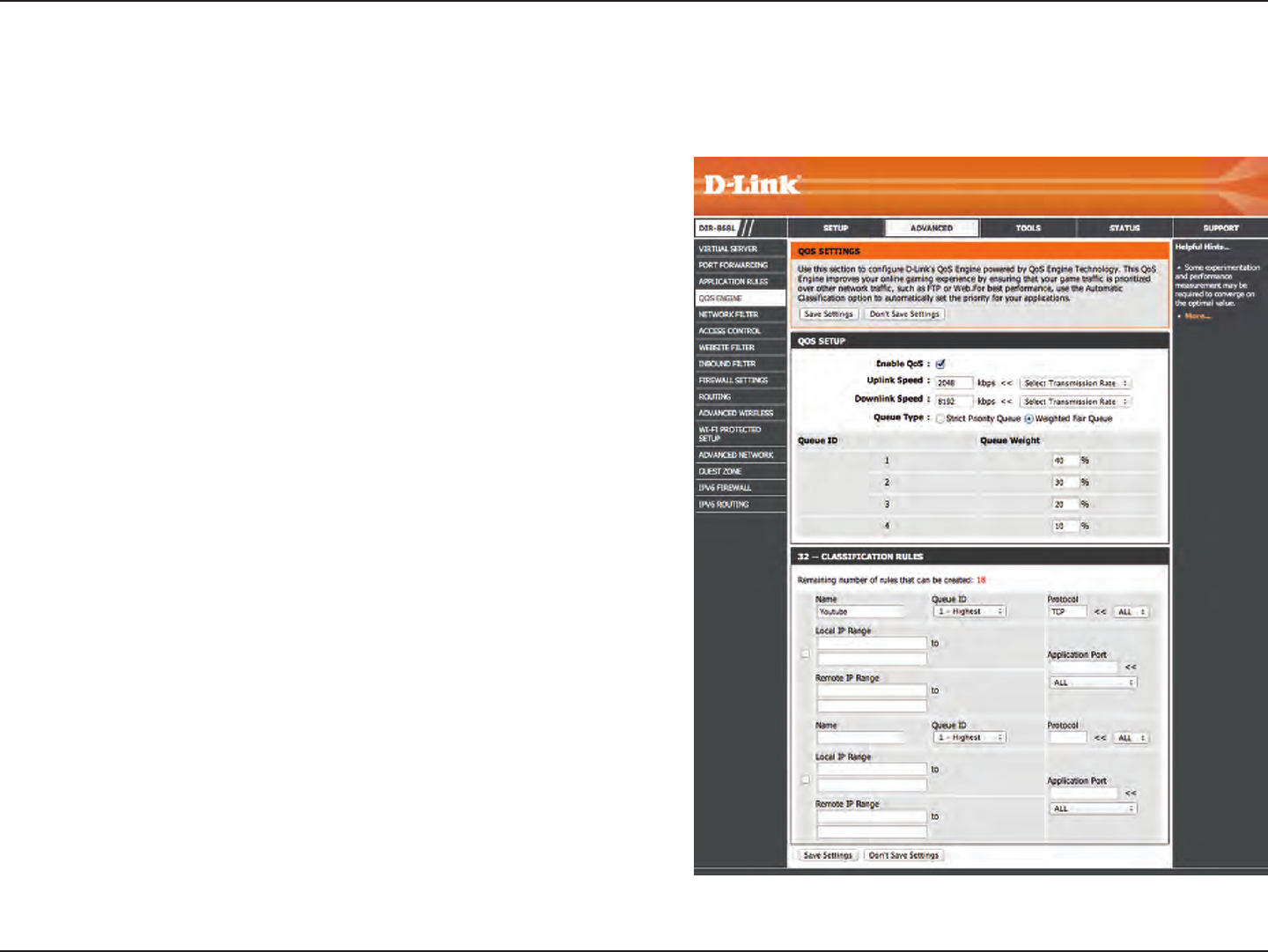
72D-Link DIR-868L User Manual
Section 3 - Conguration
QoS Engine
This option is disabled by default. Enable this option for better
performance and experience with online games and other
interactive applications, such as VoIP.
This option is enabled by default when the QoS Engine option
is enabled. This option will allow your router to automatically
determine the uplink speed of your Internet connection.
This displays the detected uplink speed.
The speed at which data can be transferred from the router to
your ISP. This is determined by your ISP. ISP’s often speed as a
download/upload pair. For example, 1.5Mbits/284Kbits. Using
this example, you would enter 284. Alternatively you can test
your uplink speed with a service such as speedtest.net.
A QoS Engine Rule identies a specic message ow and
assigns a priority to that ow. For most applications, automatic
classication will be adequate, and specic QoS Engine Rules
will not be required.
The QoS Engine supports overlaps between rules, where more
than one rule can match for a specic message ow. If more
than one rule is found to match the rule with the highest
priority will be used.
Create a name for the rule that is meaningful to you.
The priority of the message ow is entered here -- 1 receives
the highest priority (most urgent) and 255 receives the lowest priority (least urgent).
Enable QoS
Engine:
Automatic Uplink
Speed:
Measured Uplink
Speed:
Manual Uplink
Speed:
QoS Engine Rules:
Name:
Priority:
The QoS Engine option helps improve your network gaming performance by prioritizing applications. By default the QoS Engine settings are
disabled and application priority is not classied automatically.

73D-Link DIR-868L User Manual
Section 3 - Conguration
The protocol used by the messages.
The rule applies to a ow of messages whose LAN-side IP address falls within the range set here.
The rule applies to a ow of messages whose LAN-side port number is within the range set here.
The rule applies to a ow of messages whose WAN-side IP address falls within the range set here.
The rule applies to a ow of messages whose WAN-side port number is within the range set here.
Protocol:
Local IP Range:
Local Port Range:
Remote IP Range:
Remote Port
Range:
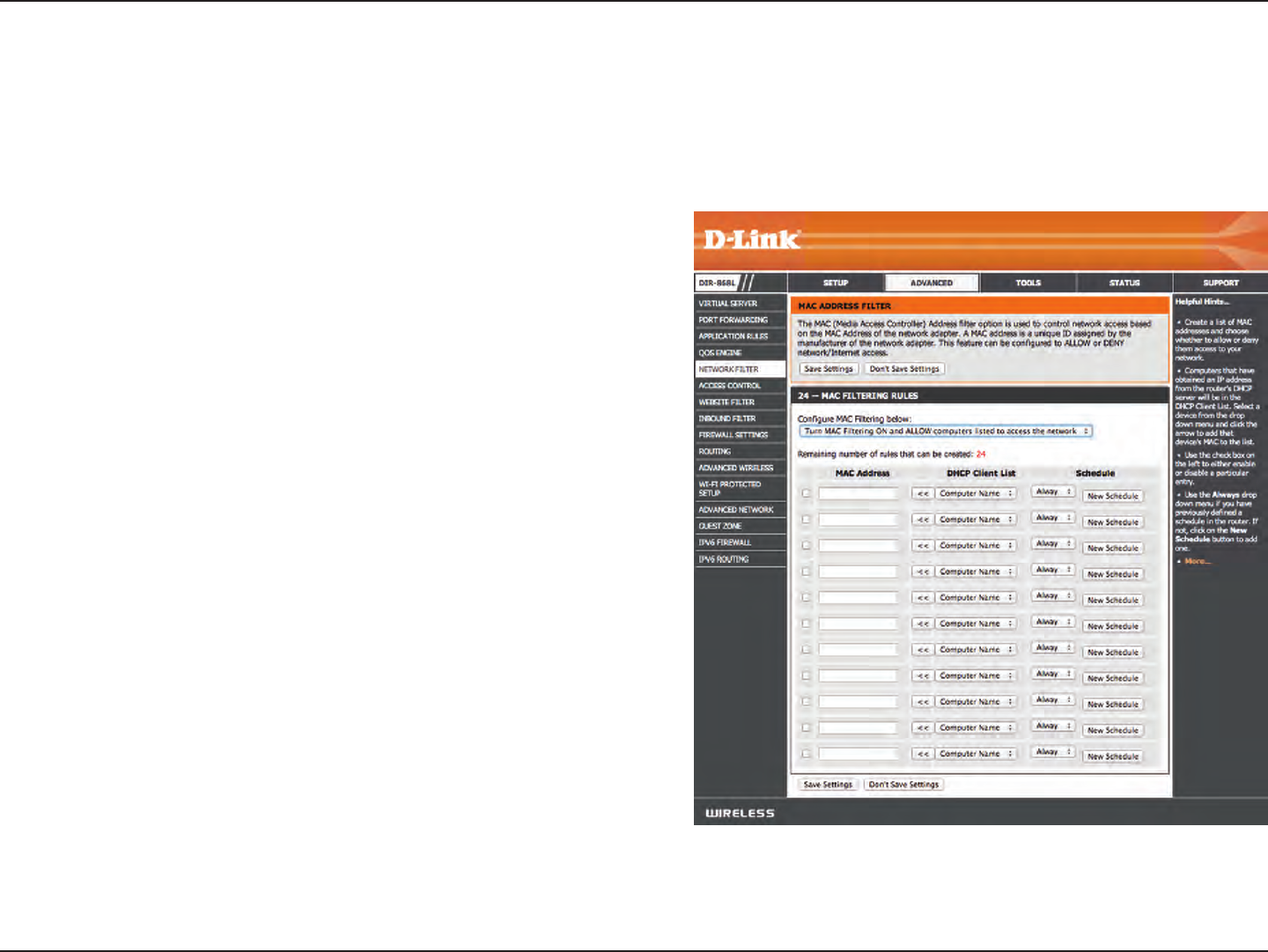
74D-Link DIR-868L User Manual
Section 3 - Conguration
Network Filters
Select Turn MAC Filtering O, Allow MAC addresses listed
below, or Deny MAC addresses listed below from the drop-
down menu.
Enter the MAC address you would like to lter.
To nd the MAC address on a computer, please refer to the
Networking Basics section in this manual.
Select a DHCP client from the drop-down menu and click << to
copy that MAC Address.
Click to remove the MAC address.
Congure MAC
Filtering:
MAC Address:
DHCP Client:
Clear:
Use MAC (Media Access Control) Filters to allow or deny LAN (Local Area Network) computers by their MAC addresses from
accessing the network. You can either manually add a MAC address or select the MAC address from the list of clients that are
currently connected to the Broadband Router.
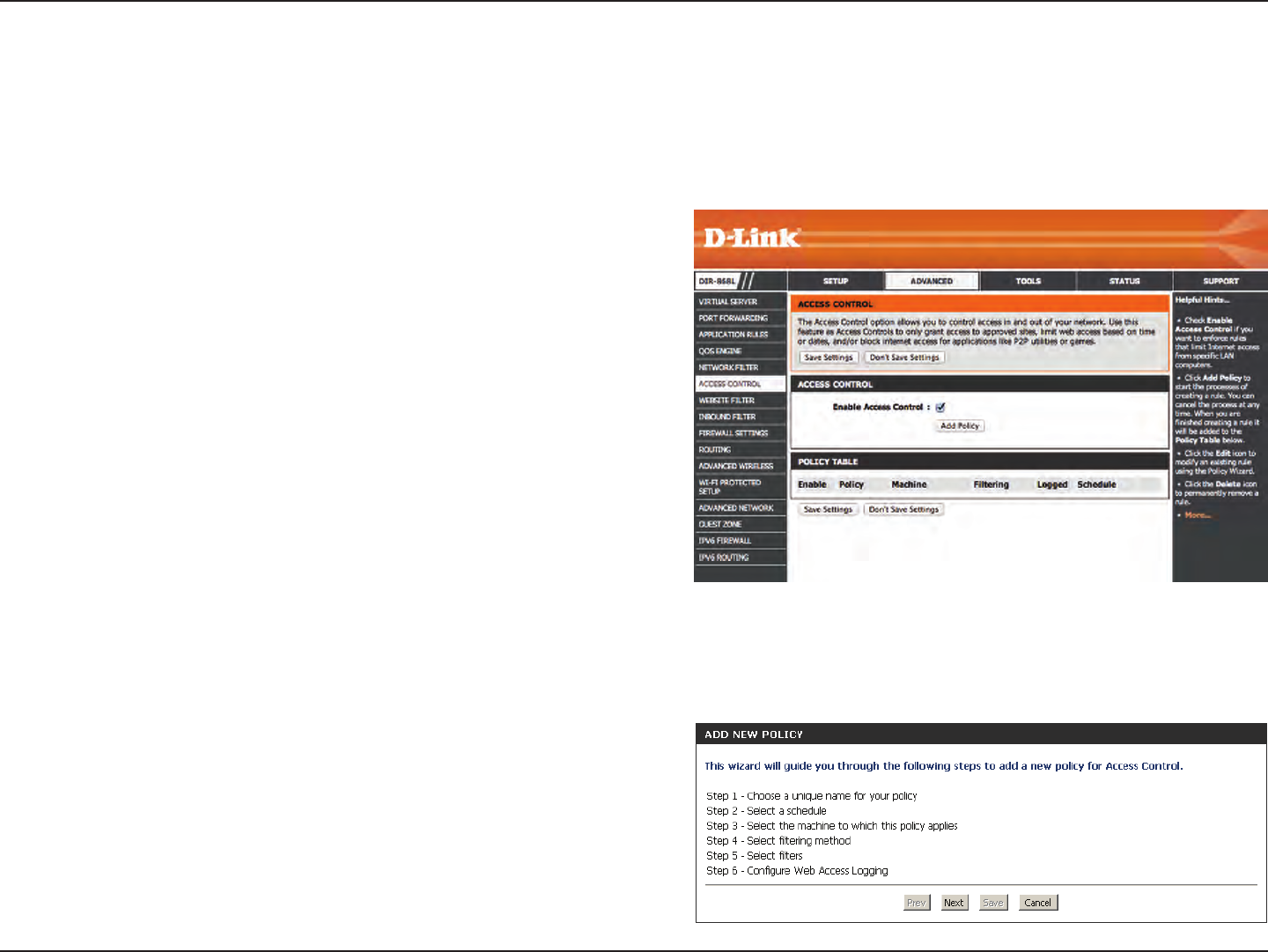
75D-Link DIR-868L User Manual
Section 3 - Conguration
Access Control
Click the Add Policy button to start the Access Control Wizard. Add Policy:
The Access Control section allows you to control access in and out of your network. Use this feature as Parental Controls to
only grant access to approved sites, limit web access based on time or dates, and/or block access from applications like P2P
utilities or games.
Click Next to continue with the wizard.
Access Control Wizard
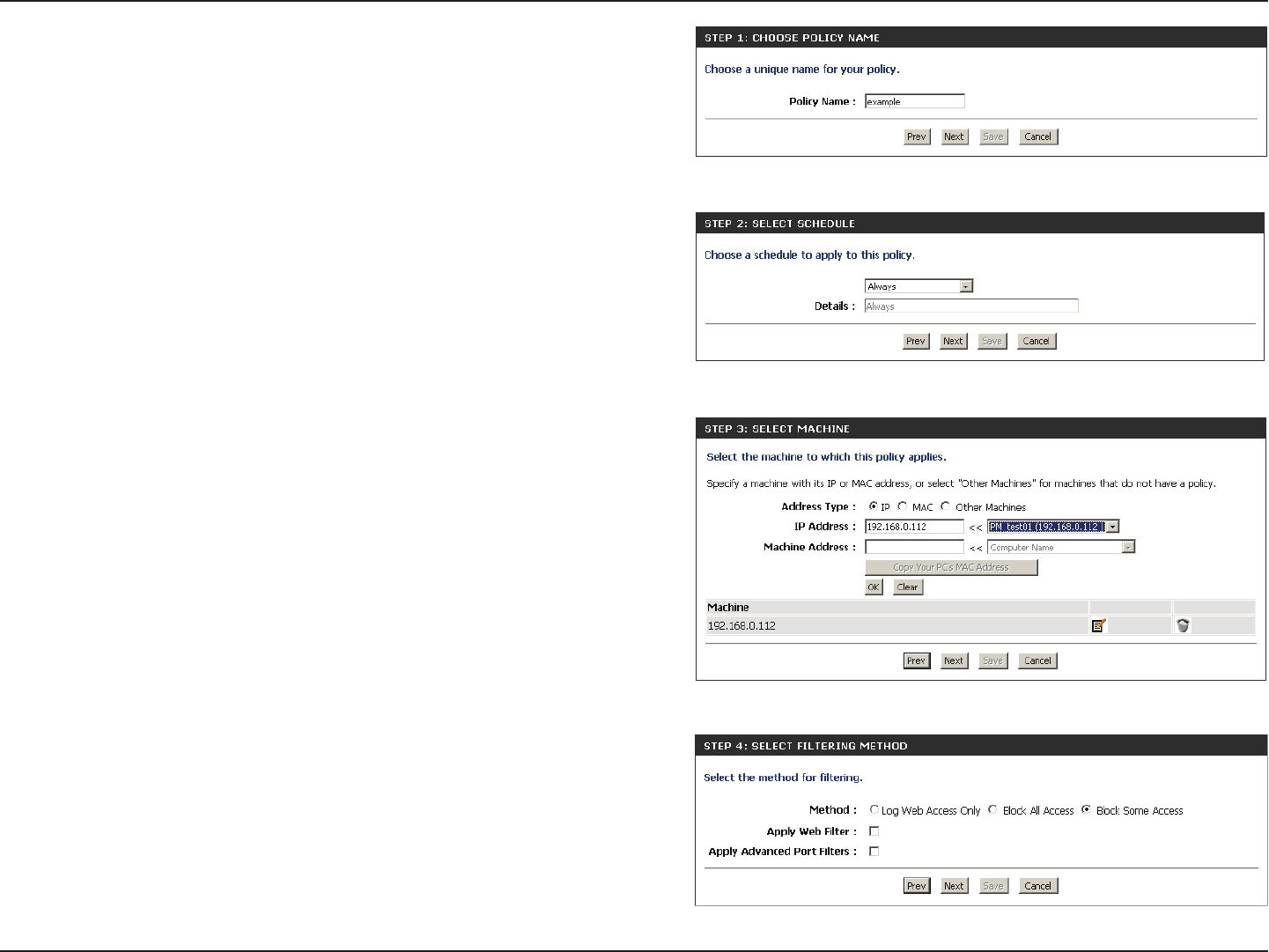
76D-Link DIR-868L User Manual
Section 3 - Conguration
Enter a name for the policy and then click Next to continue.
Select a schedule (I.E. Always) from the drop-down menu and
then click Next to continue.
Enter the following information and then click Next to continue.
• Address Type - Select IP address, MAC address, or Other
Machines.
• IP Address - Enter the IP address of the computer you want to
apply the rule to.
• Machine Address - Enter the PC MAC address (i.e. 00:00.00.00.00).
Select the ltering method and then click Next to continue.